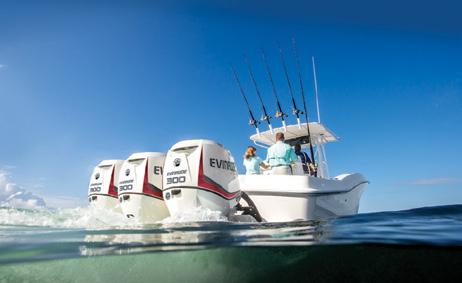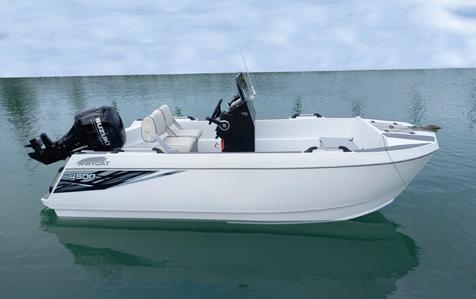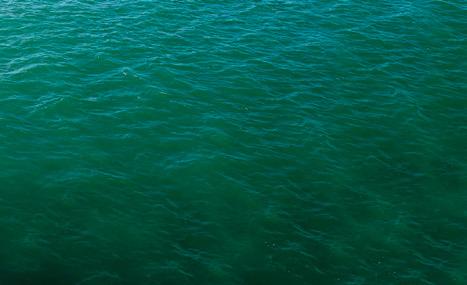
















The all new M75 flybridge motor yacht combines a synergy of balanced proportions, grace and purpose with an immensity of deck and interior spaces to cater for a vast range of entertaining, relaxation, or adventuring activities. Australian built, its powerful exterior form and grand luxurious spaces reset the international standard for cruising flybridge motor yachts. Step aboard at the Sanctuary Cove Boat Show. maritimo.com.au




68 ELECTRIC INBOARDS – PART 2
Ron Czerniak looks at the latest developements in electric powered boats.



88 LOOKING BACK – JESSE JAMES & ROSS TEBBS
One of the most recognised names in offshore powerboat racing worldwide is Jesse James or just Jesse to its fans. In 1986 it arrived in New Zealand to compete in the Class 2 UIM World Championship, and it has never left. 98 PEOPLE IN BUSINESS –SCOTT ROBSON Barry Thompson called into the Robson Design studio based in Christchurch to find out more about the company and principal designer Scott Robson.
110 COASTGUARD EDUCATION
For sailors, cruisers, and yachties, the importance of offshore medical training cannot be overstated.
132 ALLOY TRAILER BOATS – PART 2
In Part two of our series on trailer boats, we look at the proliferation of aluminium boat brands, which make up the majority of trailer boats sold in New Zealand.
148
FAR NORTH TREVS –STRING PULLERS!
Fishing in Godzone’s editor Matt Hewetson headed to the Far North to enjoy some hot softbait action fishing in the Rangiputa harbour.
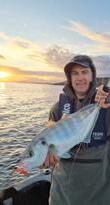
160
FORGOTTEN WORLD
Carla Dukeson took the time to get lost in the Forgotten World – the quiet place history left behind in the Central North Island.
172 ALLOY BOAT LISTINGS
Every manufacturer - every boat available in New Zealand


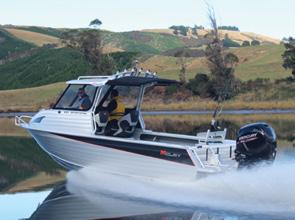
Digital readers - click play buttons to watch video review online at powerboatmagazine.co.nz



Voodoo Yachts have announced a new model, the 23 meter long XF75. The all-new Voodoo XF75 forges a new motor-yachting standard with unmatched capabilities, performance, and an expansive range of features. With production of this flagship model of the Xpedition Foiler range commenced, Voodoo Yachts is raising the bar to a new level of what an adventure cruising yacht can be.
Designed and hydrodynamically engineered for serious all-round performance, the XF75 is the largest boat to date to employ the Xpedition Wing technology and Voodoo’s hydrofoil assisted catamaran hull form for extreme fuel efficiency. The XF75 draws from the world renown success of the XF60, Voodoo Yacht’s acclaimed model of hydrofoil assisted catamaran. Performance is not only extremely fast – cruising speeds of 30-37 knots and top speeds of 45+ knots – but also agile, comfortable and able to be maintained in rougher conditions than most yachts. Her head turning, elegantly aggressive sports styling personifies an unmatched power and performance capability.
Open up and relax in the XF75’s large and spacious living areas, including multiple interior and exterior lounging and dining spaces, and a full-beam master suite. A large, open, main deck galley and extensive refrigeration caters for gourmet cooking and social inclusion. Customizable layout
options include up to four generous staterooms, and an optional crew cabin or storeroom for long voyages, with modern and stylish interior design featuring highquality finishes and materials. Two main deck layout options allow owners to craft their vessel to perfectly suit their lifestyle.
Large windows throughout the yacht maximize natural light and views, fostering immersive connections to surroundings and providing comfortable and inviting living spaces.
An optional aft pool and daybed island and an extended aft deck add to the ultimate


entertainment space, sure to create unforgettable experiences. The cockpit can be easily enclosed and so is usable as an indoor or outdoor space. The area is also adventure equipped, boasting electric fold down rod lockers, a dive compressor and bottle storage lockers, a game fishing ready aft deck area, and a large garage for storing a tender and other aquatic toys. A versatile roof deck can serve as storage of a larger tender or as a touch and go helipad for up to an H130, opening up huge possibilities. Refuelling for the helicopter is available up to 3,000L in in-built tankage, further increasing
your exploration and safety options. Despite her generous volume, excellent manoeuvrability and seakeeping make the boat easy to handle with just 2 people. The first hull, under construction currently, will feature HamiltonJet drives with a special shallow hydrofoil design and reinforced hulls, allowing the boat to be beached in remote territory such as the Kimberley. It also features adventure based systems engineering with high level of redundancy and even a dry generator which can run without seawater cooling when the boat is dried out.

VOODOOYACHTS.COM

“Performance is not only extremely fast – cruising speeds of 30-37 knots and top speeds of 45+ knots –but also agile, comfortable and able to be maintained in rougher conditions than most yachts.”
PUBLISHER D&B Publishing Ltd

EDITORIAL TEAM
Barry Thompson, Ron
editorial@boatmags.com
+64 9 428 2328
ADVERTISING
New Zealand & Australia
Doug Dukeson +64 9 428 2328
+64 21 772 202 doug@boatmags.com
Holly Dukeson +64 21 028 66849 holly@boatmags.com
PRODUCTION
Annabelle Rose Design +64 27 427 4559 design@annabellerose.co.nz
Printer: SCG
WEBSITE Stealth Media Ltd
Gustav Wentzel +64 21 0201949 info@stealthmedialtd.co.nz
ACCOUNTS accounts@boatmags.com
+64 9 428 2328
CIRCULATION
Are Direct NZ +64 9 979 3018
Are Direct Aust +61 2 99728886
SUBSCRIPTIONS (Printed & Digital) subs@boatmags.com Pacific PowerBoat is published bi-monthly January, March, May, July, September, November
Ileft the Auckland Boat Show in late March with mixed feelings. Yes, it was a fabulous venue, and the idyllic weather undoubtedly helped it, but where were the people with money to spend? While those on the marina seemed to do well, with several big boats sold during the show, the same could not be said for most trailer boat exhibitors. According to NZ Marine, there were 116 boats on the water and around 250 on land, which is a record for both sectors.
"I spoke to quite a few exhibitors after the show, and most were complimentary about the show and pleasantly surprised with the results, reporting boats sold at the show and some very positive leads to follow up", says Peter Busfield, CEO of NZ Marine. However, it is not always about the number of people who attend. It is the quality and whether or not they are looking to spend money on a new boat, fishfinder, outboard or, in our case, a magazine subscription. It wasn't our best show for sales or subs, but we did okay. Was it the time of the year or the sign of times? Over the years, there has been a lot of discussion about Auckland having two boat shows. While they are very different, one inland and one on the water, can Auckland sustain two shows? Our financial future as a country in the next 12 months is not looking positive, with interest rates rising and our cost of living skyrocketing. Boat sales from the first quarter of 2023 are at an all-time low, and predictions are 2023 will be a tough year. Most major boat builders are still in catchup mode, delivering boats ordered up to two years ago.

The on water Auckland Boat Show certainly has appeal regarding location, with Jellicoe Harbour and the ability to put boats on the water. Busfield says that the local and central government are keen to see the Jellicoe Harbour be developed as an exhibition centre and see the Auckland Boat Show and other marine-related activities, e.g. Sail GP, as an integral part of that vision. The Auckland Boat Show has not only been given a guarantee of space until 2028 but, as of next year, will also be able to include the Events Centre back into its exhibitor plans.
"We have a lot of room for expansion both outside, in marquees, the Events Centre and on the water, so the show could double in size without causing any space issues", says Busfield. "The Auckland Show Grounds, where the Hutchwilco New Zealand Boat Show has been since 1956, is the only place in Auckland the show can be held in its current format", says organiser Dave Gibbs.
Taking up 30,000 sqm of exhibitor space, on an 8 hectare purpose built exhibition centre, it would be a tall order to transfer the entire Hutchwilco NZ Boat Show to Jellicoe Harbour and the surrounding area. However, never say never, as the development of the harbour area is always work in progress.
Dave Gibbs, says that the exhibitor space was all but sold out six weeks before the show and pre-purchase ticket sales are massively up on any previous year.
"We have been getting a positive vibe from exhibitors and the public, so seeing how it all pans out in the end will be interesting. It's all about marketing the marine industry and our exhibitors making sales, which the Hutchwilco NZ Boat Show always delivers on", added Dave.
Dave admits that despite his best efforts, getting larger non-trailerable boats to the show has been a logistical nightmare and cost prohibitive for the exhibitors. So essentially, the Hutchwilco has the reputation of being a trailer boat show with all the associated accessories, engines, etc., that go with boating. It should be pointed out that the trailer powerboat market is massively bigger than the non-trailerable powerboat market, which is a plus for the Hutchwilco NZ Boat Show. The glory days of the pool may never return, but it is still an exceptional show, and the marine industry (including us) does good business. So, do we need two boat shows in Auckland? Right now, yes, it works, and exhibitors and Kiwi boating enthusiasts will have to make their own minds up as to which to support. I love both venues, but if I was, to be honest, the on-water arm makes a lot of sense and is the only way to exhibit launches and motor yachts. Will there be a consolidation of both shows? Not in the foreseeable future. Meanwhile, we will exhibit at both and encourage everyone to visit both shows as that way, you will be exposed to the very best of the local and international markets.
 Czerniak, Richard Milner, Doug Dukeson, Derek the Chef, Laurie Canfield, Mike Rose, Carla Dukeson, Rebecca Hayter, Phil Gilbert, Aaron Fletcher
Czerniak, Richard Milner, Doug Dukeson, Derek the Chef, Laurie Canfield, Mike Rose, Carla Dukeson, Rebecca Hayter, Phil Gilbert, Aaron Fletcher

WORLD PREMIERE – THE MAGNIFICENT RIVIERA 585 SUV
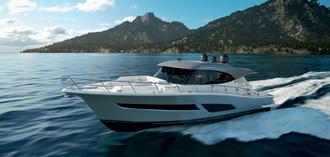



An innovative hull design, brilliant from the keel up. An expansive, single level alfresco entertainer with even more accommodation and brilliant features. Three luxurious staterooms including a full-beam master, three bathrooms and a crew cabin or utility room with dedicated laundry. Relish the Riviera attention to detail, handcrafted luxury and easy-to-use technology that makes boating easier and even more enjoyable, for a weekend escape or extended cruise. Explore the great waterways of the world empowered by the signature Riviera SUV spirit of adventure, blue-water performance and water sports action. Discover more at RivieraAustralia.com


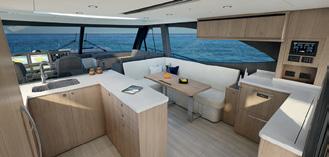
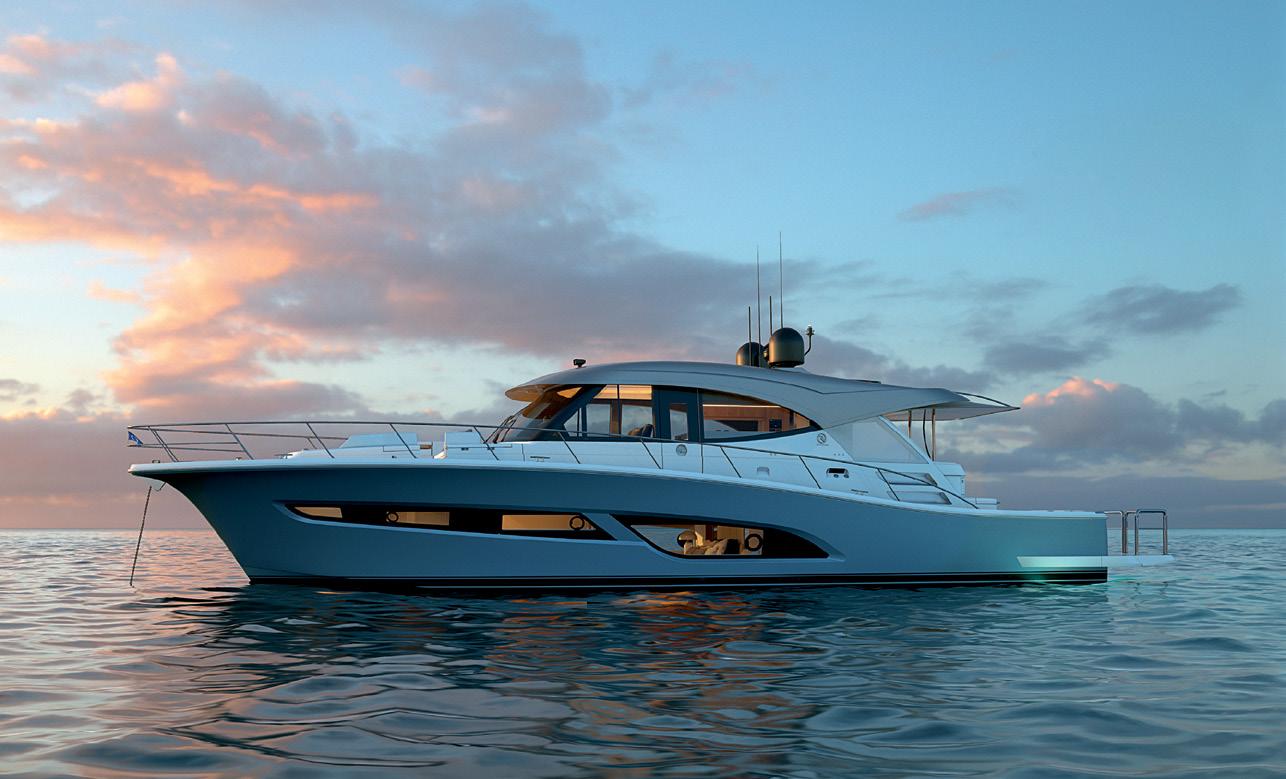
Well here we go again – we are well into boat show season, with the Auckland Boat Show last month, now well under our belt and what a great show it was, with many new and returning subscribers signing up, along with marine products and boats small and more so large finding their way a little closer to new owners, despite the so called main media driven recession approaching, possibly why smaller craft did not get the sales normally generated from a show !!
For 35 years now I have attended boat shows all around the world, mixing with our readers, the industry and show patrons, it has always been enjoyable.
Being a ‘salesperson’ myself, it has always been entertaining listening from afar, the banter between the show patrons and salespeople. The best sales pitch I’ve ever heard was at the Sydney International Boat show about 10 years ago, where a salesman saw ‘Bob’ heading towards his stand, as he had, for the last 4 years running, admiring the same model 50ft cruiser, as he had the previous years…
The salesman greeted Bob with his normal enthusiasm, although just a little more tired, after 5 years of Bob’s same cyclic visits…
Salesman: How are you Bob?
Bob: I’m great thanks – the back is playing up a little, but I’m still getting around okay.
Salesman: That is great to hear. Are you still interested in our 50ft model?
Bob: Yes - do you mind of I take may friend here through for her to take another look?
Salesman: Yes… sure…
On completion of the tour…
Salesman: So what do you think Bob?
Bob: Yes I really like her, but think I might have to look at the numbers and perhaps make the call next year.
Salesman: Okay Bob. Bob, without being rude – just how old are you this year?
Bob: 73 why?
Salesman: Well, sadly my father passed away last year, at the age of 77.
Bob: I’m sorry to hear that…
Salesman: Thanks Bob, for me it helped bring things into perspective. Now, if you are to run with a similar lifespan, this would mean you would only have 4 more summers to enjoy your new boat….. can you afford not to buy your new boat this year???
One of the best sales lines I have heard. I think of this pitch often and actually place this thinking in decision making, in my own life at times.
We are now about to start gearing up for the Hutchwilco NZ Boat Show 18th–21st May, followed up by the Sanctuary Cove Boat Show 25th–28th May the following week.

Please wander by our stand and say hello – we have some great Subscription offers and offer subscribers the chance to win a Engel Eclipse Chest Fridge Freezer valued at $1,345


Enjoy your latest copy – happy reading!
 Doug Dukeson Publisher
Doug Dukeson Publisher


The Voodoo Xpedition Foiler range of hydrofoil assisted power catamarans are set apart by their ability to cover huge open ocean distances at high speeds in absolute comfort And with incredible efficiency

Contemporary interiors, light, flowing spaces and sustainable selections refine the extreme performance
Devastatingly fast, immensely capable and supremely comfortable. The Voodoo Xpedition Foiler truly is the ultimate boat for the modern day adventurer
Get your key to unlock the oceans


Cule hatches are proudly made in NZ so we can customise to your needs and supply any parts. Easy online purchasing backed by friendly local customer service and a manufacturers warranty. Get in touch to discuss your next project.
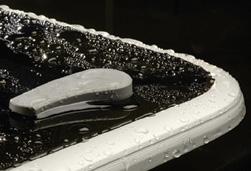
Summer may be waning but if the results from the recent Auckland On Water Boat Show are anything to go by the glow of summer certainly has not faded. Sealegs International recorded another record year in FY23 topped off with over $1.5 million in sales at this year’s four day event reinforcing the popularity of amphibious craft - both traditional Rigid Hull Inflatables (RIB's) as well as our ever popular all alloy craft. The show also provided a wonderful launch pad for two new Sealegs models - the 3.8 meter amphibious electric tender (3.8T) for which we received a huge amount of interest, as well as the allnew Sealegs 6.5 meter Alloy Cuddy Cabin.






Looking back over past years we’re delighted to see the overall market for amphibious craft has continued to grow every year since Sealegs started further proving the credibility of amphibious craft. In line with industry trends, we continue to see increased interest in our larger format craft - the 9.0m and 12.0 m Cabin RIBs coupled with higher horsepower outboards (Yamaha’s 425HP and recently announced 450HP) being top pick as well as configurations of large twin rig set ups. Additionally, the Sealegs 8.5M Alloy Cabin remains hugely popular particularly with our local NZ as well as Australian customers.
Today Sealegs are proud to offer the industry’s broadest range from the 3.8M tender through to the range-topping 12M Cabin RIB, our luxury high-end model that continues to garner significant interest for both recreational as well as commercial applications. In the commercial space Sealegs continue to experience significant interest from organisations looking at applications for our amphibious craft - be they transporting guests from cruise ships to remote islands, to emergency services to additional search and rescue craft destined for Asia.
In summary Sealegs continues to go from strength to strength with recent releases of two new models (with another on the drawing board) coupled with continual refinement of our proven amphibious models and strong local as well as international demand. As a key player in the local marine industry we remain committed to the New Zealand market place with our craft 100% designed, manufactured, built and tested here locally in New Zealand and after over 20 years in the business, and having recently signed our 1700th order, Sealegs are primatial placed to continue offering the industry's broadest range of tried and tested amphibious craft.


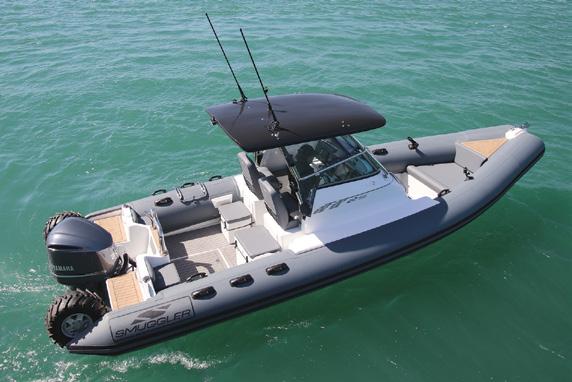


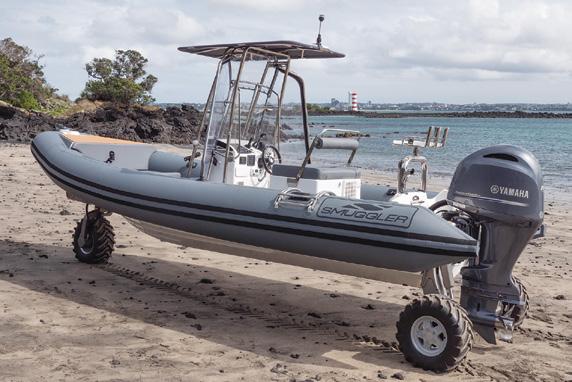




Its owner and designer, Bard Eker knows a thing or two about going quickly in boats, and how to make them that way. He is a former winner of the Class One Offshore Powerboat World Championship, he is also a key influence behind the ground-breaking Koenigsegg supercar and this experience in world-beating design coupled with a drive to succeed forms the DNA of Hydrolift.
As the name Hydrolift suggests, it chose to adopt the twin step hull that provides lift and a more comfortable driving experience and at higher speeds, than would normally be attained by a conventional day boat. A challenging 80 knots is perfectly attainable with triple Mercury outboards.
The ability to create such performance was a result of an evolved hull design originating from the innovations made through Hydrolift's rich history in offshore powerboat racing.
Australasia now gets to benefit from this Nordic powerhouse of design and innovation with the delivery of the X-Series performance day boat range which consists of five models.
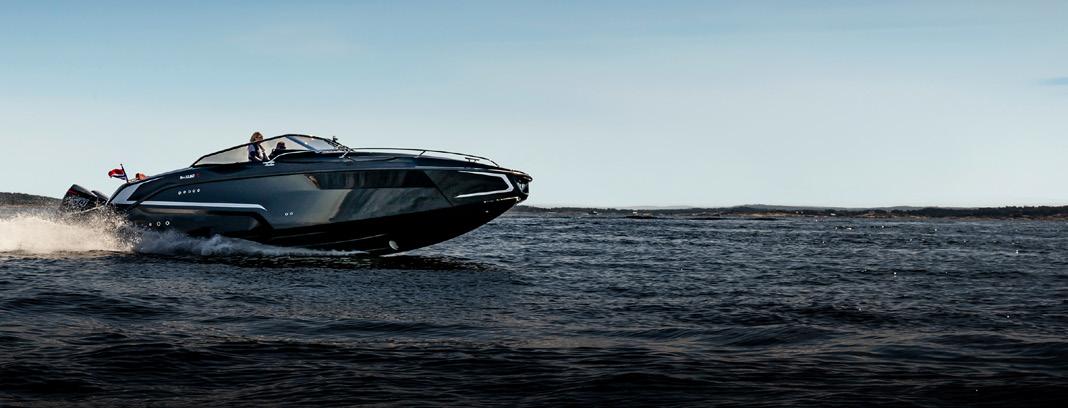
Hydrolift has made a strong commitment to the Australian market with an ample supply of boats being made available from
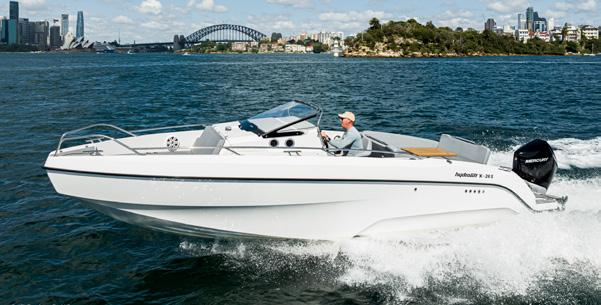
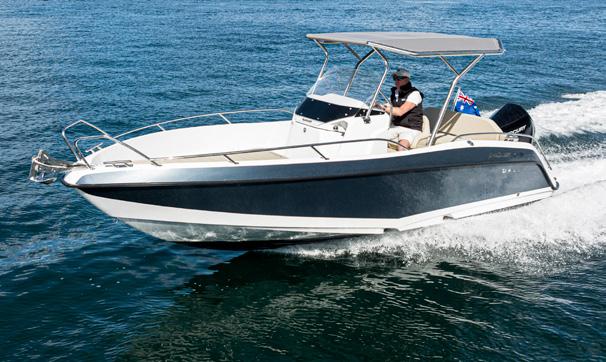

Ocean Boats (NSW, VIC, SA, WA) and Geoff Lovett International (QLD).
There’s no wait list right now, except for the X27 which is on order. Good news for those keen to get out on the water today. Every model has been specified for the Australian market with factory fitted T-tops providing additional shade, U-DEK® marine decking, 12v/240V power and increased capacity cooler boxes ensuring no one will run short on beverages.
“We are delighted to be appointed by Hydrolift to offer the X Series range, which we believe will capture the attention of anyone seeking a day boat at the next level. Not only do these boats boast a stunning quality of finish and practical liveability, but the way they perform is simply extraordinary”
SHANE MAY OCEAN BOATS
Each boat is beautifully appointed and crafted by hand to the most exacting of standards as you would expect from a country known for its world-class boat building heritage; importantly with the benefit of over 40 years of research and development.
Whilst each boat offers the unparalleled thrills of speed and agility through the special hull design and race-bred driving dynamics, its benefit of incredibly low drag also offers low fuel consumption and increased range.
Seating is switchable to allow all passengers to face forward, the hull has evolved with an exceptionally high freeboard for added comfort and safety, and cleverly hidden practical features such as galley stations and storage bins all create onboard space maximised to create usable areas for socialising and relaxing ensuring each boating experience is a memorable one.
For all further information please contact
Shane May at Ocean Boats
Ph 0409 838 498
shane@oceanboats.com.au
OCEANBOATS.COM.AU
Since 1985, Hydrolift from Norway has chosen to do things differently. It has challenged convention and continually delivered innovative designs that have been game changing.







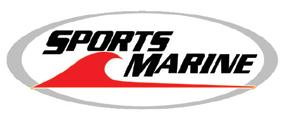

Yanmar products have been well known in our waters, both here in New Zealand and Australia for many years now –mostly for their reliable diesel engines, that are fitted into tens of thousands of boats on both sides of the Tasman.
Now, coming from this famous engine manufacturer we are about to see Yanmar Boats hit our shores. Yanmar Recreational Boats have been part of the boating industry in Japan for more than 50 years, supplying high-end fishing cruisers, they are now ready to take the new challenge of bringing Japanese fishing and leisure craft to New Zealand and Australian waters.
VF23:
The first boat expected to be exhibited in May at the Hutchwilco NZ Boat Show is the 23FT fishing cruiser. The new addition to New Zealand market will surely create a wave of interest for the Kiwi fishing enthusiast.
The VF23AZ is an inboard fiberglass boat that Yanmar believe will fit into the medium boat market with plenty of space for fishing. Equipped with their own Yanmar Diesel Engine 4JH3 series, this stern drive model can even do beachlanding as it can be fully tilted up.
The hull design has a unique property that is not often seen, with a deep entry to the fine keel, we look forward to getting out on the boat after the show for a full review. This design resembles a common center console boat, but with added protection from the wind and elements, due to an enclosed cabin design, offering protection from any sudden change in the weather. Even with this smaller sized vessel in their range, the cabin is equipped with hidden toilet and offers space for 2-3 people to bunk down.
VX30:
A larger version is also going to be available, the Yanmar VX30B fishing cruiser will make its debut in the Australian market, launching at the Sanctuary Cove International Boat Show just one week after the Hutchwilco Boat Show.
The Yanmar VX30B could be an option for Australian and Kiwi boaters looking for a compact and maneuverable vessel offering a comfortable boating experience. With its sleek design and many advanced features, Yanmar believe the boat will suit exploring Australia's beautiful waterways, whether fishing, cruising or simply soaking up the sun on the broad water.
Yanmar feel, one of the standout features of the Yanmar VX30, is its powerful and efficient engine. Powered by the ever reliable Yanmar 8LV-350 diesel engine offers reliability and performance, the VX30B is reported to be very fuel-efficient, allowing more time on the water and not at the pumps.
The VX30 comes equipped with a bow thruster, making it easy to navigate even the most challenging waterways.

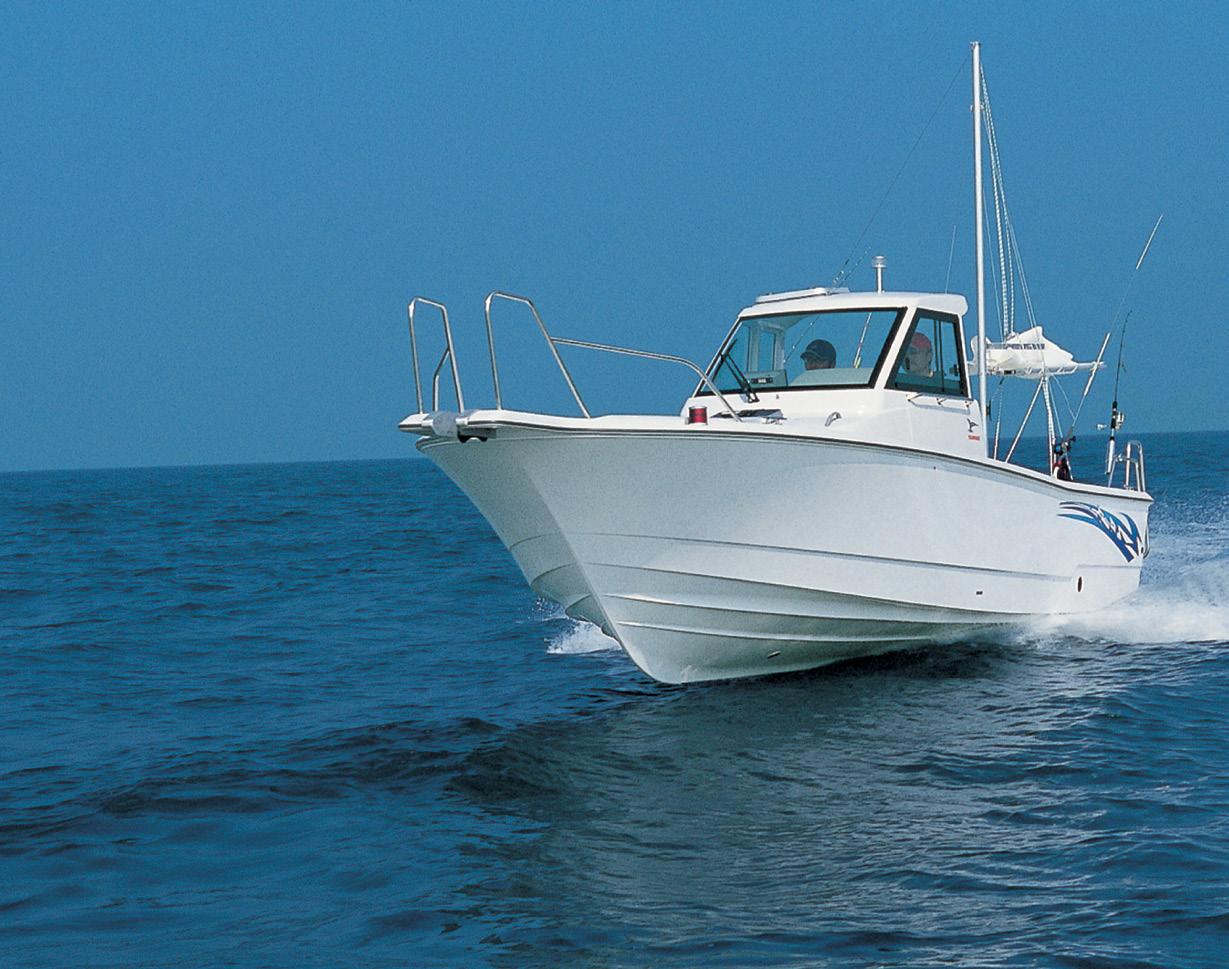
The vessel features a spacious cockpit and cabin, with ample seating and storage for all your gear. The cabin is also fully air-conditioned, providing a comfortable retreat from the heat on those hot summer days.
Yanmar believe the VX30 Boat to be an excellent choice for anyone looking for a versatile, high-performance, and comfortable vessel. Whether you're an avid fisher person, a weekend cruiser, or a water sports enthusiast, this boat is said to exceed your expectations. With this model, we again look forward to getting out on the water and coming back with a review in a future issue.
YANMAR.COM/GLOBAL/RECREATIONALMARINE/PRODUCTS/RECREATIONALBOAT/
For those who are interested in becoming part of this exciting Yanmar adventure, Yanmar still have openings for boat dealer appointments in Asian-Pacific countries. For further information, please refer to the link or QR Code on the right:
YANMAR.COM/GLOBAL/ABOUT/COMPANY/YMIA/CONTACT/ FORM/DEALER_RECRUITMENT/


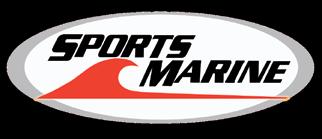



Attracting more than 45,000 attendees and 300-plus exhibitors, SCIBS is the Southern Hemisphere’s marquee marine event, showcasing more than 600 boats and over 1,000 marine products across four spectacular days.
There’s so much going on at SCIBS 2023 you’ll almost need a jet ski just to keep up! Exhibitor space is sold out, with every inch of the Sanctuary Cove precinct covered in everything the marine world has to offer. Loaded with motor yachts, sailboats, pleasure craft, gear and gadgets, this year’s
Show promises something for everyone, with a host of national and international product launches, and exciting displays with everything from superyachts to fishing tinnies, SUPs to eFoils, boat accessories to water toys.

Now in its 34th year, SCIBS has grown to become Australia’s largest and most respected marine showcase. The Show’s reputation both in Australia and around the world makes it one of the most highly anticipated events in the marine industry.
Early bird ticket holders will go in the draw to win a luxury escape to the InterContinental Hayman Island Resort in the heart of the Great Barrier Reef valued at over $5,000. Free Park ’n’ Ride services will be operating from Warner Bros. Movie World, using a fleet of air-conditioned coaches, and there is also limited onsite parking at Sanctuary Cove, available to pre-purchase online with tickets. The 34th Sanctuary Cove International Boat Show (SCIBS) is on from May 25-28, 2023.
SANCTUARYCOVEBOATSHOW.COM.AU
Visitors to this year’s Hutchwilco New Zealand Boat Show, at the Auckland Showgrounds on May 18-21, will have lots to see and do and plenty of chances to win, with an amazing collection of great prizes on offer.
As well as showcasing all the very latest boats and boating and fishing gear, this year’s show will offer Kiwi boaties and fishers the chance to win the most valuable prize ever offered at a boat show. Worth an astonishing $300,000-plus, the Surtees/Yamaha Grand Prize consists of a 30th Anniversary Edition enclosed cabin Surtees 750 Game Fisher, a 250hp Yamaha 4-stroke V6 outboard, a Yamaha Helm Master EX boat control system, a GFAB double-axle braked trailer, over $20,000 of Garmin electronics and a boat-load more!
Visitors to the show will also be able to win Viking family kayak packages, Mac Boats, and a whole host of other prizes simply by visiting those stands and registering their interest. Those keen on improving their
fishing will be able to learn new tips and techniques from some of New Zealand’s top fishers in the free Top Catch Master Class presentations.


There will be plenty of fun and excitement for the kids (and more chances to win!) in the Fishing & Adventure Fan Zone and, for those keen on a challenge, the popular Haswing Trolling Motor Challenge will be running in the Hutchwilco Pool (with a $15,000 Zodiac prize package going to the winner). The show’s unique Coastguard No Reserve Auction will again offer visitors the chance to score a bargain, while doing their bit to help the Charity Saving Lives at Sea.
To get to the show, and give themselves the best possible chance of winning that
amazing Grand Prize, people can now buy their tickets on line at www.boatshow. co.nz. All tickets bought on-line come with a second, bonus entry into the draw for that $300,000-plus Surtees/Yamaha Grand Prize (effectively doubling the chances of winning) AND also automatically go into a separate draw to win a fully kitted out powered Viking Profish Reload kayak package, worth over $8000.
Tickets will also be available at the gates throughout the show, which is open from 10 to 6pm daily, with a late night, until 8pm on Friday, May 19. Tickets are $25 for adults, with children 16 and under free.
BOATSHOW.CO.NZ
“It’s all good news,” said one exhibitor, when describing the Auckland Boat Show, which ran over four sunny days.


Reports of strong sales, quality attendees and a public ready to purchase have set the tone for the return of the Auckland Boat Show, which ran from 23 to 26 March in sunny Auckland conditions. At the first Auckland Boat Show since 2019, the fully-booked event allowed exhibitors to display 112 boats, and more than 500 marine brands in a central Auckland location. “Being our first Auckland boat Show, we were unsure as to the attendance and quality of attendees, but it’s surpassed our expectations and we’ve done better here than at our last Sydney show,” said Stephen Tritton, of Water Makers New Zealand. For the first time the show also featured cars alongside the yachts and boats on display, with Bentley and Aston Martin joining the line-up. Kennedy Point Marina had a very successful boat show campaign. The new marina on Waiheke island is due for completion later in the year and numerous sales and leads
were achieved at the show. Only a handful of unsold berths remain. The team from Hutchwilco reported a steady show with the new Jellicoe Harbour layout paying off. “The show was easy to move around, with a bigger footprint than ever before and layout that made the most of its central city location.” Exhibitors have reported strong trading across the range of marine displays; from berths to large yachts. As the central Auckland location has filled with boats, sea trials and suppliers, the boating public has demonstrated a strong appetite for new marine purchases. “We were blown away,” says Alisha Hickling of Sevenstar Yacht Transport, speaking of customers who snapped up the last spots on a Europeanbound yacht transporter leaving in just ten days. “It feels like everything has ramped right back up again, boats are moving and the industry is out in full force.”
New Zealand boat builder, Elite Marine Design has found the show full of visitors appreciative of the company’s custom designs. “We sold a 16 metre directly from the show on Friday, to a visitor who had come to the show from out of Auckland’ says Elite Marine’s Bill Upfold. “The show

has been really good with steady genuine enquiry throughout the weekend,” says managing director of Pinnacle Marine European Ltd, Azimut and Elan, Grant Saunders. “We are also pleased to announce that we sold a boat at the show to a new client.” Whakatane yacht builder, Legacy Marine launched its three New Zealandbuilt Legacy Motor Yachts to the public. “The number of people who have looked through them has been amazing and Jellicoe Harbour has proven itself as the ideal venue for a great event. All we’d change is more space to store shoes while onboard as we were not prepared for the amount of shoes the pontoon would hold as people explored the boat!” Central Auckland has been transformed into a boater’s paradise with the largest collection of luxury yachts seen in New Zealand, as well as a sea trial marina, and marquees full of New Zealand marine companies after a hiatus of the boat show since 2019. In the on-land section of Jellicoe Harbour formerly filled with America’s Cup bases, rows of trailer boats are providing fodder for a public hungry for the boating lifestyle.
AUCKLAND-BOATSHOW.COM

Australia’s boating lifestyle event is set to run from 3 to 6 August 2023 at the ICC Sydney and Cockle Bay at Darling Harbour, attracting many recognised and respected boating manufacturers, suppliers and retailers.



Major exhibitors who are already locked in to showcase the latest innovations on the water include Australian Superyachts, Clipper Motor Yachts, Cobalt of Australia, Collins Marine, Iliad Catamarans, Multihull Solutions, Short Marine, Sundance Marine, The Yacht Sales Co and Whitehaven. Trailer boats, water sports and inflatable craft will have a prominent presence at the show, the latest engines, marine technology and gear & gadgets will also be on display.
Always a popular exhibitor, Nautique Central will present the all-new GS range of Nautique boats at this year’s show but is remaining tight-lipped about the launch of a new brand. Also confirmed for the show this year is long time exhibitor, Webbe Marine. Their passion for aluminium powerboats has led them to represent two of the most prestigious brands – Sailfish Catamarans and Stabicraft Boats. On display for the first time at the show will be the new Stabicraft 2250WT-this vessel has already won an international design. With marine technology leading the charge in innovation, Coursemaster Autopilots will showcase KVH’s new TracNet terminals which include integrated satellite, cellular and Wi-Fi signals all rolled into one. With almost 5 million people enjoying thewaterways each year in Australia, the Sydney International Boat Show will feature plenty of boating and marine education, and entertainment as well. Fishing masterclasses, adventurer displays and on-water equipment demonstrations are just a few of the many activities included with an entry ticket.

SYDNEYBOATSHOW.COM.AU


The Riviera Fleet heads to Sanctuary Cove for their only Australian Boat Show Display for 2023.

Australia's luxury motor yacht builder, Riviera, will host celebrations and their exclusive owners’ festival as part of a spectacular 11-model showcase at the 2023 Sanctuary Cove International Boat Show beginning on May 25. Riviera
Australia owner Rodney Longhurst said: “Our massive showcase at Sanctuary Cove will be Riviera's only boat show display in Australia in 2023."The showcase will feature the World Premiere of a yet-tobe-announced new motor yacht at the show. The Riviera Festival of Boating will be held on water aboard multiple Riviera yachts and workshops will be held aboard the Riviera YOT Club that will also be
the social heart of the Festival located within this year’s huge showcase. Riviera owners are exclusively invited to participate in a comprehensive program of boating educational and training workshops, including ladies’ skippers, mastering knots lines and hitches, offshore seamanship, understanding radar, navigating the Whitsundays and onboard power systems management, all created to encourage Riviera owners and their families to enjoy their boating experience with Riviera.
RIVIERAAUSTRALIA.COM
Website: www.admiralboatsnz.co.nz


Phone: +64 2796009027


Email: info@admiralboats.co.nz




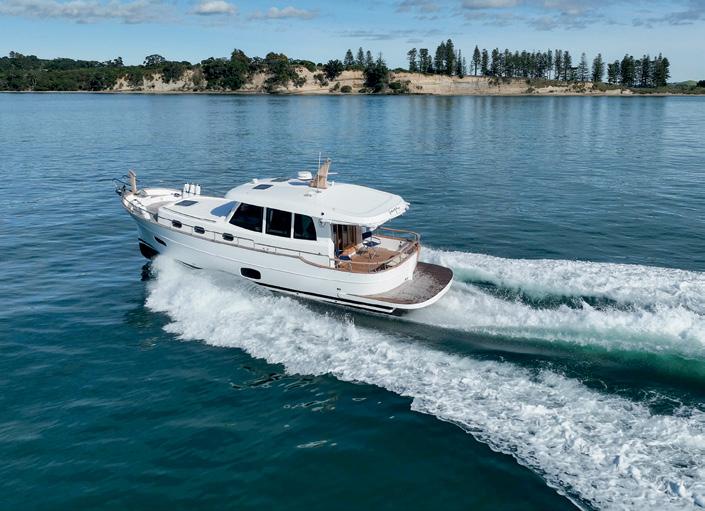

The CPC group continues to grow with three new members.
Established in 1997, the NZ Marine Coastguard New Zealand approved CPC programme has grown to include twenty of New Zealand’s top trailer boat manufacturers, producing a range of fiberglass, aluminium boats and RIBs. The programme sets standards for materials and structural design, fuel and electrical systems, bilge pumps, safe onthe-water performance and offers a two-year structural guarantee. The CPC programme is unique in that an independent marine surveyor visits and audits each approved manufacturer annually to make sure the boats are built to the high-quality CPC standards for safety. The newest CPC members include Whitepointer Boats, Frewza Boats and Kingfisher Boats. CPCSTANDARD.COM

Dometic have launched their latest roller blind platform designed specifically for use on board marine craft - the Dometic Oceanair PrecisionRise.

The new PrecisionRise system features a unique control mechanism allowing users to easily set and secure the blind at any given height without the use of any cords. The new roller blind system is set to further enhance the onboard boating experience, allowing users to easily control light, UV and their privacy all through a simple and secure control system that allows them to position the blind at any given height, without the need for any visible cords or intrusive control cables. This advanced customisable blind comes in a variety of hardware colours, fabrics and hem bar options. During its development, the new locking mechanism was tried, tested and adapted to withstand movement out at sea and resist any environmental changes that may cause components to expand or contract, which could then affect the positioned height of the blind. The PrecisionRise is now available to order via Dometic sales representatives and local distributors. DOMETIC.COM

THE WORLD’S LEADING BOAT INSURER!

Now available in New Zealand, Gear Hugger cleans, restores, lubricates and protects without harming the planet thanks to an eco-friendly formula that is plantbased and non-toxic.

Gear Hugger has 1001 uses from removing the oiliest goo, shining your scuffed shoe or keeping cogs, gears and in fact almost any mechanical products well lubricated. Two spray distributions, wide mist or concentrated mist mean you can shape the spray to suit the job. Tests show that Gear Hugger has 3x the lubricating power of the leading petroleum brand! As a cleaner, Gear Hugger breaks down the heavy grease, grime and dirt from engines or appliances. It’s the high-performance plants (or bio solvents) that make it strong enough to work quickly, yet is safe enough for most surfaces. Gear Hugger smells like natural, earthy, cooking oil, unlike petroleum-based lubricants because it is made with natural,



Steve Clement the man behind Admiral boats and his team, recently took his Admiral 10m Sports Cruiser down to the Kubota Fishing Tournament in Whitianga.

Just a week before the Auckland Boat Show. The team won heaviest Tuna with a 67.9kg yellowfin – the following week she was polished up and displayed in as new condition.


Italy’s Azimut Yachts has launched a new range of sustainable yachts under the Seadeck brand.
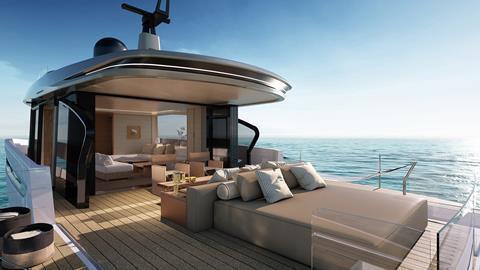

The new Seadeck series will initially comprise three models –the 18.3m (60ft) Seadeck 6, 21.3m (70ft) Seadeck 7 and the 24.4m (80ft) Seadeck 8. They will be the most sustainable and fuel-efficient yachts that Azimut has ever built. All models in the Seadeck range will have low-emission, full hybrid propulsion systems, lightweight carbon fibre, advanced hull designs, sustainable materials, and a batterysolar panel combination. The aim is to achieve a minimum of 30% less fuel consumption at a range of speeds and a 40% decrease at other times. The relevant lower emissions which this produces will be well in advance of the IMO’s target for 2030.The Seadeck design combines sustainable materials and low emissions with outdoor living and meets the ambition to bring such a lifestyle change to smaller vessels that Benetti has already introduced with its Oasis models. “We have shown the models to a number of European dealers and so far 15 orders have been received. Of the 15, 10 are for the Seadeck 6 and five for the Seadeck 7. They are all sold to European buyers” said Marco Valle, Azimut-Benetti group CEO. As to their debuts, the Seadeck 6 will premiere at boot Düsseldorf in January 2024, the Seadeck 7 at Cannes in September 2024, and the Seadeck 8 at Cannes in September 2025.
PINNACLEMARINE.CO.NZ


At the upcoming 2023 Sanctuary Cove International Boat Show, Highfield Boats Australia will host the Australian debut of the all-new Sport 660, a 6.6-metre offshore dayboat. This mid-sized family RIB with a super-deep-V hull is perfect for exploration, water sports and days on the water.
The new Highfield Sport 660 boasts a hull with a deadrise angle of 26-degrees, integrated under floor fuel tanks, EVA teak flooring and family-friendly features such as cushioned seating, sundeck, plenty of storage, swim platform with ladder and shower kit. A bimini is one of the optional extras that make this RIB the choice for “a casual cruise, water sports or offshore adventures,” explains CEO, Julien Carussi. “Like all of our boats, the 660 Sport features leading edge hull design offering an exceptional ride in just about any conditions. The deep V ensures that the boat rides smoothly whilst also limiting any water coming onboard when underway or at rest.”
Rated for up to 13 people, the 660 Sport is powered by a 175hp engine with 140 Litre fuel capacity.


The Highfield line-up at SCIBS 2023 will also include the popular Sport 560, versatile Patrol 660 and 460 models, and from the Classic range, the 380GT, 360FCT and 340, along with models in the Ultralite and Roll Up ranges.
“Sanctuary Cove is a great event for us as we highly value feedback we get from the Australian customers as they are using our product all the time, and in a lot of cases, in testing conditions”.

HIGHFIELDBOATS.COM.AU
AAKRONXPRESS.CO.NZ



HIGHFIELDBOATS.COM.AU




Quality Marine Products backed by outstanding Service.
Andrew Clynes joins Tenob
ell-known marine identity Andrew Clynes has joined the Tenob Wholesale Marine sales team. Andrew has a long and extensive history in the marine industry, with his skills well suited to his new role with Tenob. “Andrew brings a lot of experience and expertise to the company that will help better serve the needs of our clients” says Danny Bassi, MD of Tenob Wholesale Marine.
“I am passionate about boating, being on the water and being involved in the marine industry gives me an understanding of what it takes to deliver products and services to ensure safe and enjoyable activities, all while minimising the impact environmentally,” says Andrew. With over 30 years of experience, Andrew says he never stops learning, and when it comes to the marine industry, there is still a great deal to learn. “One thing that attracted me to Tenob is their diverse product range catering to such a broad spectrum of the marine industry. They have a product to suit everything from kayaks and dinghies to large motor yachts. I look forward to working with the Tenob Wholesale Marine team to provide the service you would expect from this well-respected New Zealand based operation”, says Andrew. TENOB.CO.NZ


ENL has appointed Mandy Smith as the new National Sales & After Sales Manager.
Electronic Navigation Ltd



W(ENL) has appointed Mandy Smith as the new National Sales & After Sales Manager for ENL Group. Widely known in the industry, Smith has worked in the New Zealand marine sector for over 20 years, most of which has been with ENL in sales roles. She has spent time as a sales representative, liaised with large vessel new build projects and their respective yards, as well as marketing and procurement roles. She has also been fortunate to visit Furuno Japan for classroom and on water product training.


Originally from Tutukaka, Northland, Mandy’s passion for the marine environment stemmed from having been raised in a water focused family with early memories of helping her father with Marlin Tagging records during school holidays and long trips away on his old Kauri Launch with its Furuno paper sounder. “I love the industry and particularly the advancements in Furuno and WASSP technology and am very excited to be returning to a more sales focused role at ENL,” said Smith.
ENL’s head office is located in Glenfield, Auckland, with an extensive dealer network across the North and South Islands. ENL also has a secondary branch in Nelson which supports the South Island’s commercial fishing industry. ENL.CO.NZ

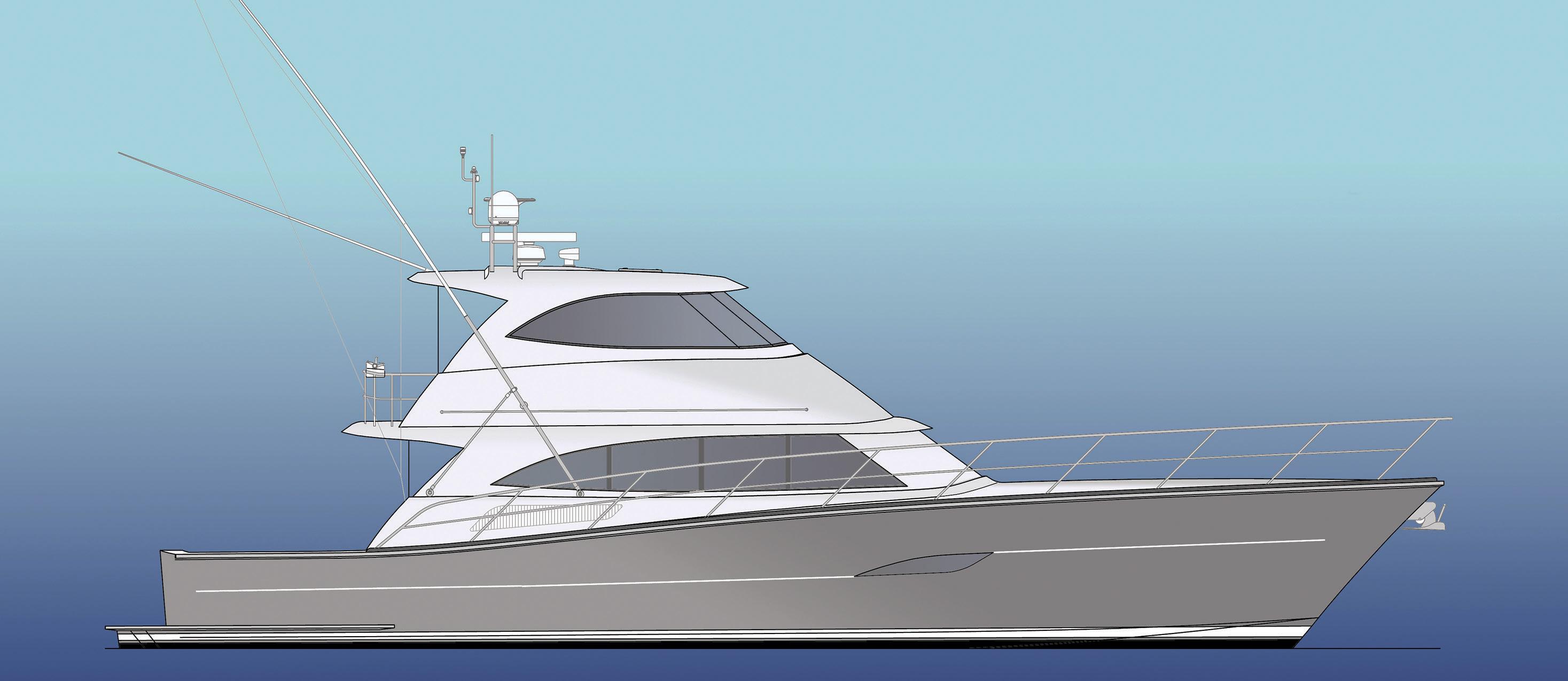
Greg Theron appointed as L&B’s new Commercial/Leisure Manager.
Experienced power systems, telecommunications and home/commercial automation expert, Greg Theron, has been appointed as Lusty & Blundell’s new Commercial and Leisure Account Manager.
Greg brings with him an extensive technical and solutions-based knowledge in important areas such as remotely managed smart power control, off-grid and solar power and communications systems, reliable, multiple-redundancy back-up systems and remote internet and communications solutions.
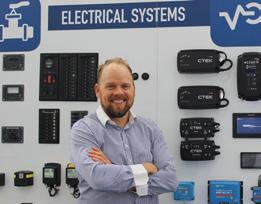
“My customers know that I believe in the products that I am recommending to them and know that I genuinely believe that those products provide the very best solutions for their situation.” LUSTY-BLUNDELL.CO.NZ
AkzoNobel is marking the 50th anniversary of its world renowned Awlgrip brand with activities throughout the year to celebrate how it has become synonymous for unrivalled quality and performance with an amazing high gloss finish among professionals and boat owners worldwide.
Awlgrip originated out of an Aerospace coating, Alumigrip, in 1973. The evolution of Awlgrip has been defined by a restless spirit of innovation to meet the changing boat building technologies, repair and application processes, being ahead of regulatory changes, and to deliver an extensive colour palette that meet consumer demand and expectations.

A dedicated webpage on Awlgrip.com charts the history of the brand and unearths the fascinating hidden stories behind its evolution. One story reveals that the product was initially conceived to be spelled ‘Allgrip’, but a transcribing accident saw it referred to as Awlgrip, with the name sticking ever since.
Over the five decades since its inception, the Awlgrip range has expanded to encompass finishes, primers, fillers and varnishes, becoming a world-class brand that can be found in almost every port and country around the globe. Its market presence is reinforced by industry leading sales and technical teams that educate and support applicators, builders and boaters the world over.
Activity around the celebrations will include amplification of technical and customer support across their social media and digital channels, with promotional activity at key fall boat shows such as Sanctuary Cove International Boat Show, Monaco Yacht Show, METS Tradeshow and Fort Lauderdale International Boat Show.
AWLGRIP.COM

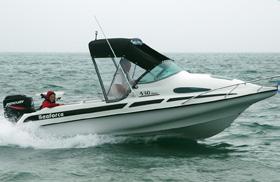
DEMEY Yachts have now finalised the design of a fixed hardtop and flybridge entertainment area on their two 18 metre builds. Codenamed the SPACESHIP 60 due to the vast amounts of interior and exterior space.

The flybridge design on these boats will be unique; not only do you have a large forward entertainment area with two wrap-around settees separated by a centreline helm station, but you also have the ability to store water toys such as paddleboards, kayaks or small sailboats within a 26 m2 area on the rear deck. This is very beneficial when you reach your
destination, with guests able to explore the destination surroundings with ease. The custom designed 3.8 meter carbon tender catamaran is housed in its own tender garage under the lower cockpit floor, with an innovative launching system making retrieval and launching a oneperson operation.



Both current builds are identical, one to remain in NZ and the other heading to Sydney, Australia. The Spaceship 60 is available as a semi-production build with the next available build slot in November 2023. Contact office@nicdemeyyachts.com to book a build tour.
NICDEMEYYACHTS.COM

The Yacht Sales Co will represent Maritimo in Singapore, Malaysia, Philippines, Indonesia, Thailand and Hong Kong.
The appointment is a step in The Yacht Sales Co.’s growth in the Asia Pacific region with numerous sales centres now established in Australia, New Zealand, the Pacific and in multiple locations across Southeast Asia.
The Yacht Sales Co CEO Mark Elkington said the team was honoured by the appointment and look forward to assisting Maritimo with its development and future
growth in the region. Maritimo managing director Tom Barry-Cotter said the new partnership was a wonderful way to launch the brand’s 20th anniversary celebrations. The Yacht Sales Co. is well established in the region, having enjoyed a long-standing presence with sister company, Multihull Solutions. Mark Elkington said there was exciting potential for Maritimo’s growth in Southeast Asia with strong demand for
larger luxury motor yachts.
“We will also be opening a new sales facility in Hong Kong later this year, resulting in a total of seven sales centres in the region,” he said. Maritimo offers luxury motor yachts in three distinctive ranges: the M-Series Flybridge, the S-Series Sedan and the new Offshore Series.

YACHTSALESCO.COM

AkzoNobel’s Awlgrip yacht coatings brand is launching Awlcraft 3000, the latest Awlgrip topcoat to feature enhanced colour technology delivering truer and deeper colours for professionals and boat owners.

The new Awlcraft 3000 system uses the same utoner system as is used for Awlgrip HDT, developed specifically for professional use, the system is coupled with AkzoNobel's suite of digital colour matching tools that support owners in finding the right colour for their boat.

Sharing the next generation colour platform with Awlgrip HDT means it offers a deeper, truer and more consistent colour performance, while retaining the long-lasting, high-gloss finish that its Awlcraft 2000 predecessor is celebrated for.
It also shares the tried and trusted application characteristics and repairability that have made Awlcraft 2000 such an essential part of an applicator’s toolbox worldwide for over 25 years.
The launch of the new generation topcoat and clear coat comes in a landmark year for Awlgrip, in which it will celebrate its 50th anniversary. At launch, the Awlcraft 3000 Clear Coat and a set of ready-mixed colours will be available for the Asia Pacific, European, and North American markets that include the popular colours of: Snow White, Flag Blue and Extreme Black. AWLGRIP.COM

Seakeeper has announced it is introducing its Seakeeper Ride tab system as an aftermarket product for refit installations.
Introduced in August 2022, the company’s Ride tab system was initially provided to boatbuilders only as an OEM part. Seakeeper’s Ride tab system works with non-stepped, planing fibreglass monohulls from 6m-11m.
“Since our launch, we’ve been badgered by boaters asking when Seakeeper Ride will be available for refits,” says Seakeeper president and CEO, Andrew Semprevivo.

“Our team has worked hard to ramp up production and ensure our dealers can meet the demand and provide the appropriate support.”
Three blade sizes are available: Seakeeper Ride 450 for boats 6m-8m, Seakeeper Ride 525 for boats 8.5m-9.5m and Seakeeper Ride 600 for boats 10m-11m.

The company says it will roll the product out to the refit market, initially focusing on the US as it delivers corresponding dealer training, with plans to expand the rollout internationally in the near future SEAKEEPER.COM


Every element of the Tristram Ownership Experience is premium, from a new models CAD designed inception through to production, handover, and aftersales service. Our diverse range of Tristram Hardtops, Targa Tops and Cabriolets are designed and crafted to perform by a talented team of innovators who live for the ocean. We continue to redefine trailer boating for thousands of proud Tristram owners who seek to venture beyond the ordinary.

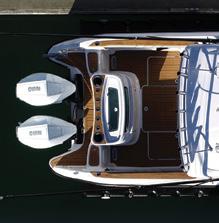




Discover more at www.tristram.co.nz


The Princess S80 is the all-new flagship of the Princess Yachts S Class range. Princess Yachts announce the latest edition to their S Class sportbridge range, the all-new Princess S80.




Featuring Princess’ latest sweeping design language, the S80 is designed by the in-house Princess Design Studio in collaboration with naval architects Olesinski and Italian design house, Pininfarina. The versatile layout of the all-new S80 allows her to be managed as an owner operated vessel with a vast open saloon and raised helm or discreetly crewed, with the option of an enclosed helm plus crew accommodation for up to three. Full length windows flow along the main deck, extending either side of the cockpit canopy to provide a sheltered area from the sun. High bulwarks complete with oval stainless-steel rails, vast teak laid deck, and tailored natural materials define the flagship status of this new S Class model, blending luxurious and contemporary finishes in perfect harmony. The Princess S80 is a Princess above all else with a distinct S Class personality defined by its S hull graphic, strong graphical canopy features and powerful bulwark haunches.
As you approach the S80, she is instantly recognisable from her distinctive central cockpit access. The cockpit and transom have been designed to maximise on-water enjoyment, with a garage to port side with Williams tender launch system, capable of holding up to a Williams SportJet 435 plus an electro-hydraulic bathing platform. The cockpit provides a large functional area in which to spend time with loved ones. Twin sunpads (the largest ever seen on an S Class yacht) border the central access steps, whilst the configurable cockpit seating area with twin coffee tables is the perfect place to enjoy a sundowner. Moving forward, a teak dining table to seat six to eight (with optional extendable table), is positioned next to the galley bar creating the perfect area to serve drinks. Sliding doors and a large opening window above the galley bar connect exterior with interior to create a natural flow through the main deck. Light from the panoramic windows flood
the saloon. A pantograph door gives the Captain direct access from the starboard side deck through to the foredeck for easy mooring and communication. The foredeck continues to adapt to owners’ lifestyles with two U-shaped seating areas plus a sunpad conversion. The S80 lower deck features four ensuite cabins complete with chilled water air-conditioning and opening portholes for natural ventilation. The aft lazarette and two-berth crew cabin with bathroom are situated aft of the machinery space, with various layout options including an additional crew mess area or optional third crew bunk or separate laundry centre. A watertight door from the electro-hydraulic bathing platform gives direct access to this area. Equipped with MAN V12 1900 or 2000 horsepower engines providing speeds up to 34 knots, plus an optional 7,000 litre fuel tank to enable an extended cruising range. SPORTSMARINE.CO.NZ

For those wishing to acquire the ultimate day boat with jaw dropping design, exemplary quality, and also one truly capable of delivering the sheer pace and thrills of a performance sports boat, then a Hydrolift X Series offers the perfect day out on the water.


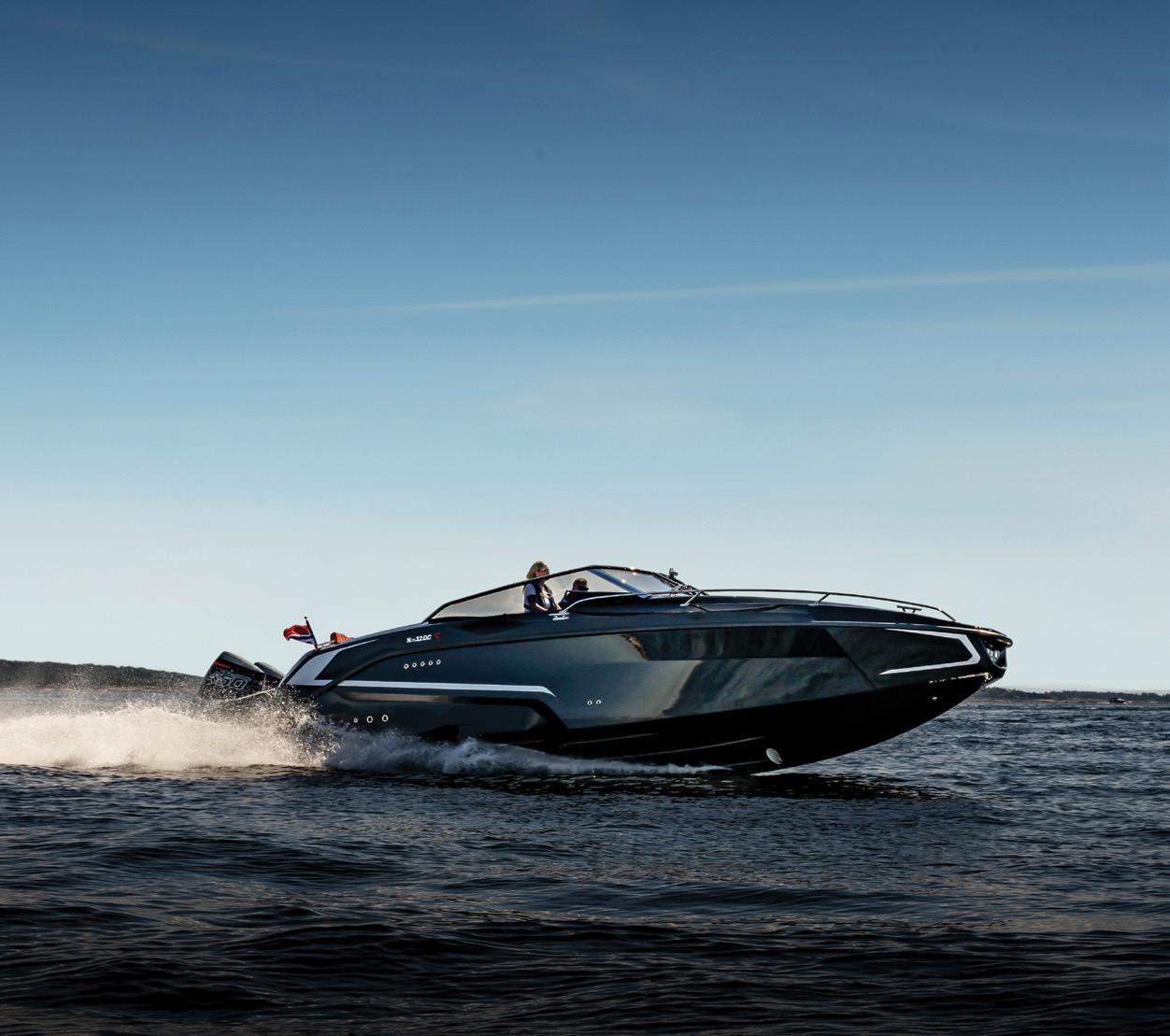
Each boat is beautifully appointed and crafted by hand to the most exacting of standards as you would expect from Norway, a country known for its world-class boat building heritage and coupled with the experience from offshore power boat racing which in the DNA of Hydrolift.

Exclusivity is assured with only a handful of boats being made available from this iconic boat builder so now is the time to act and secure your order.

Please contact us to express your interest, or to make an appointment to view our available models at the 2023 Sanctuary Cove International Boat Show - May 25-28.




Maritimo’s long awaited new 75 series is getting closer. E-news asked principal designer, Tom Barry-Cotter about the progress of the M75 and S75 and the interest on these stunning new flagships for the Maritimo brand.
Will we see both the S75 & M75 at SCIBS?
Yes, we will be globally launching the M75 and S75 motor yachts at SCIBS. Guests, media and VIPs will be the first in the world to see these vessels in the water.
What has been the feedback to both models and where is the main interest coming from?
The response has been incredible. Our Maritimo family are incredibly excited, and proud of the pathway we are forging. Even with a new dedicated production line, orders for the new 75’s stretch well into 2025, so we have many years production ahead of us, even before the first 75 hits the water. A lot of interest has been coming from Oceania, Asia and the Americas.
Which is attracting more interest, the M75 or S75?
The first impression is certainly that of the
boats exterior form and appeal. When owners see the drawings, and then the development taking shape in full scale mock-up within our new model development division, everyone is of the firm opinion that this is the most attractive vessel we have ever crafted. Both vessels have had huge interest but the M75 is slightly in front.
Is there any scope for customisation or are the interiors all going to be much the same?
Customer input drove design consideration from a broad number of items such as the specification, floor plans, storage capability and capacities, down to finite details and styling accents. Our owners (especially Maritimo owners) spend more time aboard their boats than anyone, it has always been a design philosophy within Maritimo to tap into their boating knowledge to continually evolve in the right direction, and always craft a better product. Every Maritimo owner is
able to customise the interior to suit their desires. Our interior designers help guide our customers through this whole process from start to finish.
What are my engine options?
The ScaniaDI16 1150 MHP is the standard engine and Maritimo has aligned itself with Rolls Royce MTU for is featured engine upgrade option. Options include the MTU
10V2000M86 1380MHP and MTU
10V2000 M96L 1625MHP power units which will provide reliable power with leading efficiency and economy.
Are we going to see anything bigger from Maritimo or is this around the size limit for the brand?
We don’t reveal any future models until their official Global Reveal date so until then you’ll have to wait and see.
MARITIMO.COM.AU
AUGUST 3-6, 2023
DARLING HARBOUR AT
From paddleboards to power cruisers, sail boats to fishing gear, the Sydney International Boat Show is your opportunity to mingle with the best and brightest in boating, watercraft and marine tech. It’s the ultimate marine showcase that absolutely everyone should attend.






Clear your calendar and join the fleet for the marine celebration of the year.
The new Pershing 7X concentrates the quintessence of Pershing in a compact, flawless form. 7X is lightness. 7X is speed. 7X is performance in each and every detail. A fabulous blend of the latest Pershing technology and the unmistakable design by Fulvio DeSimoni. The latest in the X series from the Italian yacht builder, the 7X replaces the 70 in the company line up, and although slightly shorter in length, it’s a 30cm wider and more voluminous than its predecessor. The first Pershing 7X sold into New Zealand will arrive later this year for a client that wanted something different to everything else on the water, but offered exceptional finish and detail, along with unmatched performance. Pershing are known for their speed and the 7X is no exception. Powered by a pair of 1,800-hp MAN V12s, through surface drives, the 7X


has a top speed of an incredible 51 knots. Built as a three-cabin boat, the 7X’s optional lower-deck layout offers a spacious seating area on the starboard side opposite the galley. The owner’s suite occupies the widest part of the hull, and with an L-shaped entrance and enormous side windows it feels like an enviably luxurious space. The VIP is set well forward, and the third cabin, features twin-berths. James Dalzell, Sales Broker for Australasian importer for Pershing, Ray White Marine, says the new X Series has proven a huge success worldwide and he says that once the local market sees the Pershing 7X, they will be super impressed. “It’s a boat that you can’t say enough about and I am sure that the discerning Kiwi buyer will warm to the 7X once they can step aboard and experience it first hand”.
RAYWHITEMARINE.CO.NZ
Bays Boating has taken out Mercury Marine’s most prestigious award, named as The New Zealand Dealer of the Year for 2022.


Located in Motueka, Bays Boating was started in 2004 by Dave Thorn in his parent's hop shed. It has since grown to be the region’s largest marine retail and service centre, now employing over ten staff.
In 2019, Bays Boating opened a spacious new showroom and purpose-built workshop where there are five full-time mechanics. Mercury Marine’s Director of Sales David Meehan said the win by Bays Boating was “thoroughly deserved”. It was a hotly contested competition with many worthy candidates but Bays Boating were the standout, highlighted by them being the first South Island dealership to become a Mercury Premier Service Centre”. The team from Bays Boating and all the other winners were recognised at the 2022 Mercury Marine Awards held at SeaWorld on the Gold Coast just recently in March 2023. MERCURYMARINE.COM
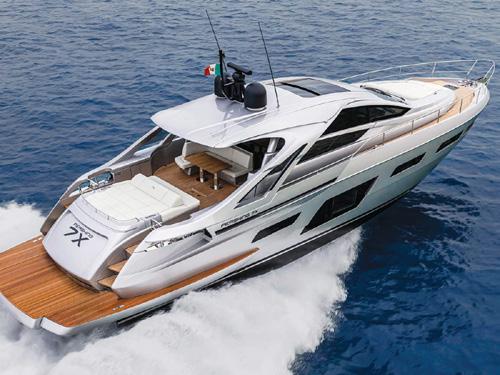
At the top of the L Series, the 2023 LX Sport combines engaging performance with a captivating style to produce an unmistakable presence on any waterway.



For an easier purchasing experience, Bennington made more premium features standard. The LX Sport comes loaded with creature comforts, all
guaranteed to enhance every single day on the water and ensure that all boaters’ and their family’s needs are accommodated. These include new smooth exterior rail skins and graphics; an extended aft deck and Lillipad boarding ladder and sporty integrated LED docking lights. For convenient docking, cleats are built-in stainless-steel pop up-style that store flush with the deck when not in use and a quick fender latch kit. The helm is elevated to ensure a clear line of sight for water sports and docking.
Exterior options include premium graphics, RGB LED lighting, a deluxe and cladded arch and dual power biminis. The luxurious interior can be customized with diamond stitch furniture, an ottoman with integrated cooler, tables and dinettes and a porta potti for

added comfort. Anglers can add a four-pole rod holder and water sports enthusiasts can opt for a ski or tow pylon or bar. Upgraded audio systems are also available. The LX Sport is available in lengths ranging from 22- to 26-feet in two layout options –Quad Bench and Swingback configurations. One of Bennington’s most popular floor plans, the Quad Bench configuration maximizes storage, seating capacity and lounge space. The Fastback stern with aft facing speakers extends the entertainment space to the back deck. The Swingback layout is an innovative floor plan that enables dual seating capabilities by allowing users to face forward or backward depending on the position of the furniture back.

BENNINGTONMARINE.CO.NZ


Australia’s premium luxury motor yacht builder, Riviera, has announced four winners in its Apprentice of the Year awards for 2022, showcasing the depth of talent within the company’s workforce of 900 people, including 112 apprentices.


The winners across four categories received their awards at a special ceremony recently in front of the 900-strong Riviera workforce. The apprentice winners are Simon Magnay, second-year apprentice in engineering, Claudia Le Fevre, secondyear apprentice in upholstery, William Johnstone, second-year apprentice in boat building and Connor Baruksopulo, first-year apprentice in timber and composite machining. Riviera’s safety and training manager Adam Houlahan said Riviera continues to welcome young apprentices through its schools program.
"All of the award-winning apprentices have a shared drive and determination
found across Riviera’s 900-strong team, namely a passion for creating exceptional blue-water luxury motor yachts," said Adam.
The recently announced TAFE Apprentice of the Year was another achievement for the Riviera team as apprentice Max Whitmore was announced runner-up in a very large entry across the State. Riviera also announced that six apprentices have graduated through the company's award-winning Propel program: Tirryn Casey, Jack Fuller, Joshua Hindmarsh, Steven Kupfer, Brendan O'Grady and Thomas Jay Parsons.
Riviera owner Rodney Longhurst paid tribute to all apprentices including the award winners who received recognition this year.
“These young members of our team are the genesis of the next generation of master boat builders for our industry,” said Mr Longhurst. "I began my own career as an apprentice so I have been on the same journey and I share their excitement for the future.
RIVIERAAUSTRALIA.COM
Kiwi, Wayne Valder is returning to the USA for another season on the Superboat offshore series. Driving his 44ft MTI, Pro Floors, Wayne has been a regular competitor on the US Superboat circuit and the Key West World Championship for a number of years and while he has the NZ1, AUS1 and US1 in the trophy cabinet he has yet to get the holy grail, the World Championship title. Held at Key West Florida in November, Wayne, with throttleman Grant Bruggeman, will run the entire seven race US series before taking on Key West.
Last year the season was somewhat disrupted with Covid and hurricanes and some races were cancelled and some overseas competitors were unable to attend. Hopefully the 2023 season go a lot smoother with some great racing.
The Class 1 and Superboat fields are stronger than ever, with Superboat boasting eleven yeam and Class 1 seven. Along with all the twin outboard and bracket classes, fields over more than 50 boats are expected at most events.
Valder says he is primed and ready for the 2023 series. For 2023 he will also be carrying a new sponsor name on the side of the boat, Celsius.
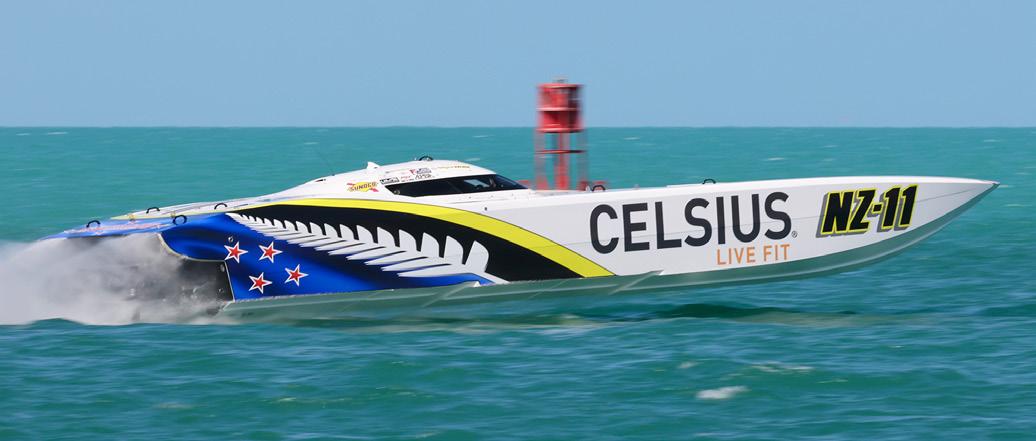
1. Marathon, FL 4/28 - 4/30/23
2. Cocoa Beach, FL 5/18 - 5/21/23
3. **LOTO, 6/01 - 6/03/23 (**tenative)
4. Sarasota, FL 6/30 - 7/02/23
5. Michigan City, IN 8/04 - 8/06/23
6. St. Pete, FL 9/01 - 9/03/23
7. Clearwater, FL 9/22 - 9/24/23
Key West World Championships: 11/05 - 11/12/23


Dometic Trim Tabs are designed to make trim tab adjustment second nature to operators of all types of boats. They increase fuel efficiency, optimise boats performance, increase visibility by adjusting the bow down and increase safety and comfort.

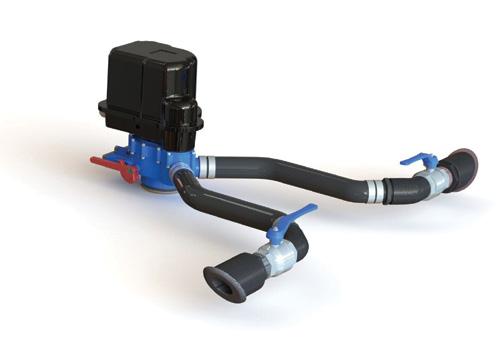
The heart of the Dometic Trim Tab system is the intuitive dial controller that lets boaters easily "dial in" the optimal ride for any situation. All the operator needs to do is turn the dial in the desired direction to level the boat, and the electric actuators respond quickly and precisely to level the ride. Other features include the ability to adjust pitch independent of the roll and roll independent of pitch, being able to turn the dial in the direction needed to change the roll of the boat so it is level and a press of the bow up or down button to adjust the pitch of the boat. There is also a ‘Favourites’ button which makes it easy to plane the boat with a previously set tab position and easy-to-see LED lights on the controller indicate port and starboard tab positions, with an ambient light sensor that automatically adjusts brightness for optimal visibility in any environment. A sophisticated design, engineered to comfortably stand up to the rigors of life on the water.
DOMETIC.COM







Jet Thruster Micro is a compact, powerful thruster designed mainly for trailer boats, small launches and yachts.


Water drawn into the pump unit via a 76mm inlet is pumped at high pressure through small 60mm nozzles just below the waterline on either side of the bow (or stern).
Because the nozzles are installed further forward than possible with a tunnel, the 30 kG force delivered is far more effective due to the increased fulcrum.
Pump Unit can be mounted close to the middle of the boat, needs to be 150mm below the water line to be fully flooded.


This year, Horizon Yachts plans its largest showcase to date, at the annual Sanctuary Cove International Boat Show, with eight yachts on display bookended by the debuting V74 and RP125 motor yachts.
The Horizon Yacht Australia (HYA) team will be joined by senior members of Horizon Yachts headquarters on the display on Pier G that will also include three FD80s, two FD90s and an RP100. The flagship of this grand display will be the new Horizon RP125, the largest Horizon yacht sold in Australia. The RP125 is a five-stateroom yacht with an on-deck master suite and two VIP staterooms and two mirrored queen staterooms on the lower deck. Customized for the Australian market and conforming to AZ/NZS electric standards, the RP100 offers a traditional superyacht configuration. The two FD90 models on display each boast unique features customised to owner’s specifications.

Making its debut at the show is the brand new FD80 Hull 10, which is the first FD model in Australia to feature a galley-aft layout. Rounding out this exceptional showcase is the brand new Horizon V74. Defined by a plumb bow design and exterior profile defined by Stimson Yachts and an interior layout penned by Jonathan Quinn Barnett, the V74 has been customized for the Australian market. “The V74, while smaller in length than most Horizon vessels delivered in Australia, is market-leading in terms of overall volume,” says Director of Horizon Yacht Australia, Mark Western.
HORIZONYACHTAUS.COM


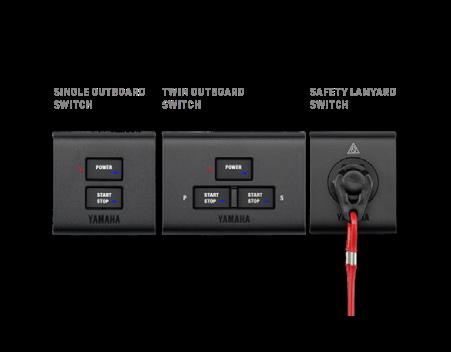
When Yamaha introduced its Helm Master boat-control system back in 2012, they promised an upgradable expandable system.

At the recent Auckland Boat Show we, along with show patrons, had the opportunity to experience the new system with the new additional features now available across single, twin, triple and quad outboard engine applications. Our test vessel for the day was the recently released Haines Hunter 635HT.
The system now consists of four primary application levels and has been designed to be further customizable to suit boaties needs. This means you can install the complete Helm Master™ EX system, or start with just the Digital Electronic Controls and Digital Electric Steering, and then add additional components over time, allowing you to reap the benefits that come with each component upgrade.
Level 1: Digital Electronic Control (DEC)

Level 2: Digital Electric Steering (DES)
Level 3: Autopilot
Level 4: Full Manoeuvrability Joystick
The Helm Master EX offers boaties a completely integrated boat control system that assists getting to your destination or favourite fishing spot, easier with incredible control, using a combination of digital electric steering, autopilot and joystick technologies.
The system, with its own built in GPS system offers a series of great control options, through the combination of engine and steering, these include:
FishPoint (Bow or Stern) which
• DriftPoint: seeks to maintain a heading at drift speed.
• DriftPoint Track: allows one to maintain heading while drifting along a set of prepared waypoints.
• Heading Hold: holds the boats heading while at cruise.
• Course Hold: keeps your course while underway.
• Track Point (autopilot): keep you on track of a predetermined waypoints.
The handy Pattern Steer functions built into Yamaha’s autopilot system have also been expanded to include two new options, in addition to the existing Spiral and Zig Zag patterns. The skipper can now access Williamson Turn and Pattern Search formations, which return the vessel back to the point where the patterns were activated, - great for searching fishing grounds or looking for something lost overboard, hopefully not one of the crew !
Yamaha's Digital Electronic Controls are available in concealed side-mount, single and multi-engine throttle options – they have been updated to include a dedicated Trim Assist button. Trim Assist is a function that automatically trims the outboard to pre-set levels, at chosen engine rpm or speeds, making operating the vessel easier. This function can be turned on and off at the touch of the new button on the control box.

the keyless fob and Yamaha Touch screen, not to mention the compact and clutter free electric steering offers a safer transom with extra ‘real estate’.

It was certainly a lot to take in on the day, but a very cool bit of kit – once set up on your boat and using the system regularly, the benefits will soon be enjoyed.
We also heard a whisper that shortly the system may soon allow an integrated bow thruster control through the Helm Master EX joystick.
In fact as we went to press, it was announced that Helm Master EX Twin and Triple Application can now be integrated with Vetus BowPro Thruster, taking Helm Master EX to yet another level. When you push the F1 button of the autopilot panel, the system wakes up and improves the performance of Joystick maneuvering and SetPoint functions: StayPoint, FishPoint, DriftPoint, and DriftPoint Track; as well as help keep the boat on track when using autopilot functions at low speed.
The Helm Master EX is available across all of Yamaha’s digital electronic control outboards options from Yamaha’s F150 right through to the F425 XTO.






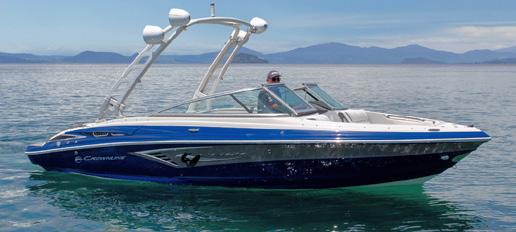

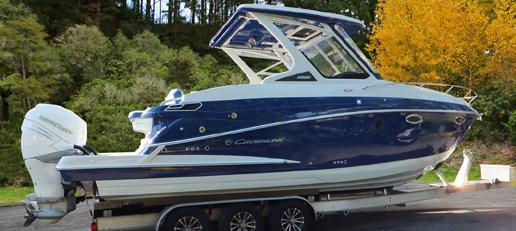




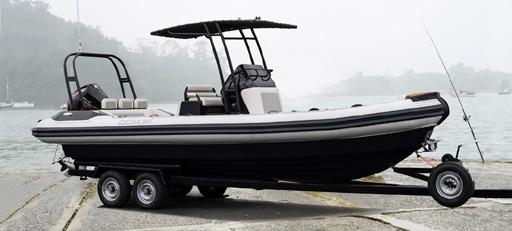








Raymarine recently presented the new Axiom 2 PRO and, HP Watermakers is one of Apps that can be added to the homepage of Raymarine Axiom 2 PRO. The application simplifies the management and control of the watermaker. The partnership between HP Watermakers and Raymarine dates back to 2019, the year the two companies started working together. Their collaboration led to the installation (by default) of the HP Watermakers communication app on the multifunction displays in the Axiom range.
Raymarine recently introduced the Axiom 2 Pro, which combines chartplotter, fishfinder, radar, autopilot and video in one powerful multifunction display. It is easy to use thanks to Hybrid Touch technology, which combines touchscreen control with an all-weather external keyboard, combined with the intuitive LightHouse operating system. Featuring the latest LightHouse 4 operating system, this new all-in-one display integrates with a Raymarine advanced navigation network that includes LightHouse charts, radar and autopilot, as well as FLIR thermal night vision technology. The new 6-core processor allows for faster chart scrolling, instant response and the ability to run multiple apps simultaneously. The choice of applications, which includes HP Watermakers, has been the subject of careful analysis to select the most used and the most useful for improving the quality of life on board.

RAYMARINE.COM

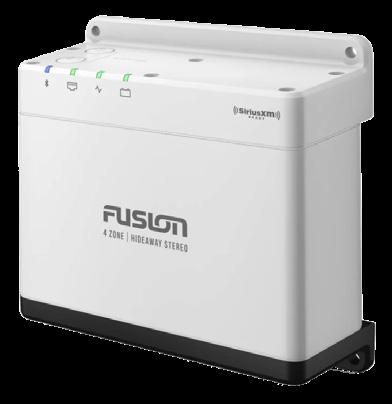
Fusion has announced the update of the Fusion-branded Apollo Series with the release of the Apollo WB675 Marine Hideaway Stereo. Designed to maximise valuable dash space, the WB675 hideaway stereo offers a world-class audio entertainment experience and the ability to enjoy premium sound from four separate audio zones. The WB675 is an advanced marine stereo with cutting-edge technology and features for those who value a premium audio experience while enjoying life on the water. Some of the key features are the multi-zone technology, compact design, and the ability to stream loss less audio with Apple AirPlay2 software from a compatible Appledevice1. The WB675 possess Digital Signal Processing (DSP), that optimises the audio signal that is delivered to Fusion entertainment systems, resulting in superior sound quality at all volume levels and in every listening environment. Designed to withstand extreme weather conditions, the WB675 is rigorously tested against salt fog, UV, humidity, and extreme temperatures that can cause mechanical failure, providing peace of mind that the stereo will perform and last in the harsh marine environment. The WB675 is protected by a three-year warranty.
GARMIN.COM/FUSION
Jet Thruster Micro bow thruster is designed for boats up to 9m. Holland Marine Parts, producer of the Jet Thruster, has developed the all new Jet Thruster Micro. A new small sized bow jet that meets the demand for manoeuvring small boats with too little draft for a conventional bow or stern thruster. The Jet Thruster Micro is the smallest bow thruster system with IP-cover. The powerful pump unit, distribution valve and all technology are housed in a small 15 kg module with a special hood that creates a gas-tight seal. In addition, the entire outer casing of the system is made of very strong ABS, which means that all components are protected against moisture and corrosion. Unlike conventional tunnel or retractable thrusters, Jet Thruster does not use a physical propeller. Instead, the system operates by directing a high volume water flow nozzle installed on the hull. Nozzles can be located much further forward than a tunnel greatly increasing fulcrum. Jet Thruster Micro is specifically designed with the small trailer boat market in mind, where a large open tunnel in a planing hull is undesirable. The Jet Thruster Micro is sold as a complete comprehensive package which includes all material needed to install all in one box. It is suitable for the DIY guy because it requires no costly fiberglass work. The pump and nozzle flanges seamlessly cover the three penetrations making the Jet Thruster Micro system quick and easy to install. On the control side it all is done with plug and play cabling, panel mounted joystick and remote control pendant included in the kit. The new jet bow thruster suits boats up to 9.0m and operates from a 12 VDC battery.
SOPAC.CO.NZ










ePropulsion has announced a new range of E-Series batteries for 2023. With a more ergonomic design, the E60 and E163 will supplement the existing E80 and E175 batteries in the range. The E-Series provides consistent performance and smart operation, says the company, delivering up to 3,000 charging cycles for a reliable user experience.
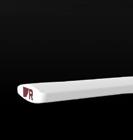
ePropulsion’s new E-Series Lithium Iron Phosphate batteries are highperformance and packed with features. With three times higher energy density and 70% less weight than lead-acid batteries, the E-Series is ideal for smaller vessels with minimal interior storage space. Connectors can be attached with only one hand – no additional tools are required for simple installation.
The IP67 waterproof rated E60 is designed for use with the ePropulsion Navy 3.0 Evo (6hp) and the E163 is designed for the Navy 6.0 Evo (9.9hp). Engineered for ease of use, their intelligent battery management system (BMS) features a display that shows state of charge, voltage, current and alarm information for maximum safety.
The E60’s compact form factor and light, double-layer plastic housing can easily be transported and installed by one person, while the E163 is designed for high reliability with an all-metal housing that is impact resistant and drop proof. A key innovation of the ePropulsion product line is that all outboards are built on a 48V architecture, allowing for a greater degree of flexibility. ePropulsion E-Series batteries are designed to provide optimal performance for the entire range of ePropulsion electric motors.
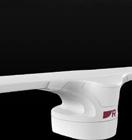
EVOCEAN.CO.NZ



Orca is turning the Apple Watch into a powerful tool for boaters. The brand-new Apple Watch app lets users control their boat’s autopilot and view instruments from the wrist. Orca is the first company to deliver autopilot controls on the Apple Watch. Traditional wireless autopilot controllers are costly and resemble a remote control for a television. With the new app for Apple Watch, Orca is pioneering a new approach in the boating industry. Building innovative solutions on top of consumer day-today devices instead of inventing yet another device to buy for the boat. Why are wireless autopilot controllers such a big deal? When boating you'll often find yourself away from the helm. Maybe you need to prepare for a port entry, find that chart folio, or get the sprayhood up before a rainfall. If you need to change course during situations like that, being able to do it quickly makes life at sea easier and safer. With Orca for the Apple Watch, you can now turn on and off your boat's autopilot and change your boat’s course. On a sailboat, the app allows you to direct the boat to keep a steady angle toward the wind. The Orca App for Apple Watch also shows important instruments, such as speed, heading, water depth, wind speed, and wind direction. Orca is available in Europe, New Zealand, and North America. To use the Apple Watch’s autopilot control you need an Orca Core to connect your watch to your boat’s instruments and autopilot.



GETORCA.COM




Elephant Fish are only found in New Zealand. Most commonly found around the east coast of the South Island at depths of around 200 metres. The flesh of the Elephant Fish is of good edible quality and closely resembles that of Hapuka (Groper).
INGREDIENTS:
2 Elephant Fish fillets (150g)
2 cup Panko crumb
(Fogg Dog Japanese Bread crumb)
1-2 tbsp Cajun seasoning depending on taste (Mrs Rogers)
Rice flour for dusting (substitute All Purpose flour)
Sea salt and freshly ground black pepper
Lemon wedges on the side
1 egg
¼ cup milk
Cocavo turmeric & lemon zest coconut and avocado oil for frying
Salsa
2 tomatoes, finely chopped ¼ telegraph cucumber, finely chopped
½ red onion, finely diced
1 tbsp small capers
Handful flat parsley leaves
1 tbsp Pacific Harvest Karengo fronds (optional)
1 tbsp balsamic vinegar
75ml Cocavo avocado turmeric & lemon oil (or extra virgin olive oil)
½ tsp dried chilli flakes
Juice of one lime
Salad Beetroot, courgette, carrot noodle
METHOD:
1. Combine all the salsa ingredients together and place into the fridge while you prepare and cook the fish.
2. Combine egg and milk together to form an egg wash.
3. Dredge the fish fillets through seasoned flour then place into the above egg wash to coat well.
4. Dredge through the Cajun seasoned Panko breadcrumbs ensuring a good coat of crumb all over.
5. Bring a heavy based pan up to temperature then add in the Cocavo.
6. Drop a little crumb into this, when the crumb turns golden you know the oil is hot enough to place the fillets in.
7. Place the fillets in to cook 1-2 minutes each side depending on thickness but ensure you do not over cook as this fish will dry out really quick.
To plate, place the fillets in the middle of the plate with 2 tbsp of the salsa on each fillet.
Chefs Tip: Ensure you do not over cook the fish although this recipe may be used with any thick fleshed fillets or steaks. Dress the salad with a French dressing.

Since 1984, Cape Crest has developed an international following for its unique expression of New Zealand Sauvignon Blanc. Barrel fermented, with a touch of Semillon and Sauvignon Gris, it is concentrated and complex with toast, citrus blossom, pear and stonefruit characters.
Cape Crest and its gannet symbol refer to Cape Kidnappers, the southern point of Hawke Bay, home to the world’s largest mainland colony of these remarkable marine birds.

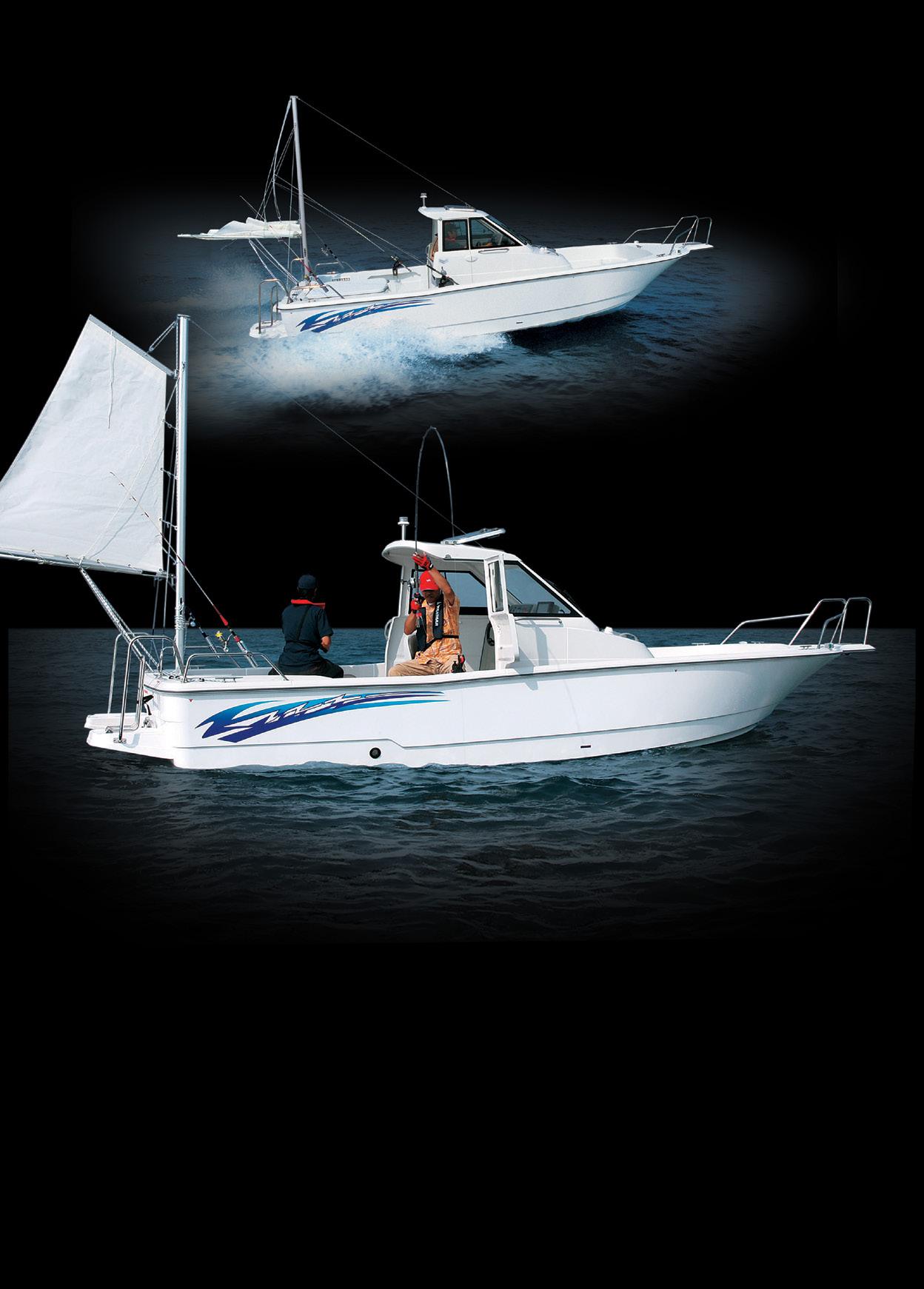
Gulf Harbour, for a 12m craft. Okahu was @$340+ for lift and relaunch v GH at $550+. Hardstand was $45/day v $80/ day at GH. Every boatie knows a 5 day in and out becomes 3 weeks in no time as hidden variables evidence themselves. Not to mention the mass exodus of friends and crew when antifouling time arrives! Including wash down that’s $1604 v $2703, a not inconsiderable sum to many budget boaties. For Jack Windbludger with his $7000 Spencer Stiletto, add in the costs of antifoul, anodes and materials and that’s half the value of his boat. No wonder our mooring areas are littered with sad sights and the public notices by the ACC for ‘abandoned’ boats are becoming more frequent.

From my earliest days of boating Okahu Bay has been there. A gathering place of old boats for long term refurbishment, a place where yachties of all classes sailed from, Coast Guard was there, and the Royal Akarana YC. I must confess to having left that establishment well oiled, and playing hide and seek in our cars amongst the derelicts and empty cradles. Fond memories! Also there was the world’s worst launching ramp, scene of many a catastrophe.
It’s illuminating that ACC requires all boat owners, either in marinas or on moorings to keep their craft free of fouling, but now there is nowhere for many of these craft to go. With the closure of Pier 21s’ hardstand, also Little Shoal Bay (a multi hull facility), Hobsonville (WestPark) becoming much more upmarket and costly and the increase in hardstand ground use for boat stacks, along with mooted apartment development, the capacity of the remaining hardstand areas is insufficient for Aucklands’ budget boating needs. Along with Te Atatu, Okahu Bay was one of the only places where budget boat owners could do repairs and maintenance at a cost that did not reflect half the value of the boat after two weeks on the hard. Compare Okahu with
Long gone are the days of public grids where any boat owner could DIY, dropping anything off the bottom of their boat into the mud, for nature to absorb. Marine Precincts such as Whangarei and Marsden Cove are seeing many more Auckland based craft heading north for their refits. Many of us were blind to the biohazards we created, but I always remember the effects of the sometimes brutal antifoulings we used. Westhaven Marina floats for years were festooned with long weeds and growth, as the antifoul leeching and wastes from the grids forced all fish from the area. Once the better antifoul paints became the norm, the fish came back and ate the weed. Pretty simple really. Back to the closure.
My understanding is Okahu Bay ramp, hardstand and the reclaimed areas which formed this, are the property of ACC Parks and Reserves. For many years they leased the management rights to another ACC arm, Waterfront Development. Waterfront Development morphed its assets into the new ACC property trading arm, Panuku. With the ever increasing public awareness of biohazards and water quality, WD and later Panuku put many millions of dollars into upgrading the facilities at Okahu Landing to collect and treat all wash down water and waste, upgraded the ramp and
jetties, purchased an older travelift to facilitate easier and more damage free lift outs than the old system, with wheeled cradles, diggers and divers with chocks. This all in reasonably recent times. The hardstand was essentially cash neutral, covering its costs without recourse to ratepayer’s money. On instruction from the ACC landowners its charge rates were kept low, specifically to ensure affordable facilities for the greater boating public. Panuku wanted to further develop Okahu Landing (as it was now known), but this was denied as the existing lease was drawing to an end, and purportedly not fit for purpose. This constrained the developments proposed. The new lease mooted had become a bit of a political football, with vested interests wanting the hardstand gone and parking and open space events areas formed, plus expansion of the RAYC storage facilities, while other interests including Iwi and the greater boating public wanted retention. Some political wrangling meant the new management lease for the area was somehow transferred or given to the Orakei Local Board. (Active proponents of the remove and revamp). This meant that the ensuing referendum over future use was essentially restricted to local residents and local interested parties. The greater Auckland Boating public were not consulted, and local Iwi ignored. 809 submitters took part with 340 for continued use in its existing or improved condition, and 469 wanting greater public space. Interestingly, over half of those submitters were from the RAYC and/or the Akarana Marine Sports Trust, the RAYCs’ benefactor. Certainly the RAYC is the big winner here. Very few of those submitters ever used Orakei Landing. Ratepayers will now pick up the costs associated with refurb and maintenance costs for Orakei Landing. The area was closed on Feb 28, ending a long and memorable interaction with the boating public, and further putting the squeeze on those who boat on a lesser budget. Any suggestions on where they can go now?
This piece started out to be a lament to the closure and redevelopment of the Okahu Bay haulout and hardstand, but as I did a bit of background, became a fascinating insight into how Council, and its various appendages work, in seemingly the most dysfunctional and expensive way.






It’s an inconvenient truth that the trickiest part of an outing is getting the boat back in its pen. It can fray skipper’s nerves, cause marital disputes and provide a 5pm entertainment show at the marina.
In yachts, I’ve done perfect landings and absolute screw-ups, but at this early stage in my launching career, I’m thinking launches are trickier to berth. Yachts have a keel which gives them momentum and steerage at low speed. Launches at low speed wander around like drunken ducks. Apart from three berthings of my boat at Waikawa Marina under adult supervision, I was a total rookie the first time I berthed my new boat, stern-in, on its delivery to Nelson Marina. It went perfectly. Truly. I’d been practicing in my head for 20 minutes. I entered the fairway deadslow. Somehow I picked the right spot to engage gentle reverse to stop, then put the helm hard over to port, then re-engaged the throttle. I’d been told that’s far more effective in close-quarters manoeuvring than turning the helm when the throttle is already engaged.
As the bow turned to port, the blah-blah of the bow thruster helped it round until it was pointing directly away from my berth and I reversed straight in. Perfect… I should have known it was too good to last. Sometimes it took two attempts or even three to get in the berth. Which meant I got scared to take it out of the berth. I asked everyone for advice; I Googled it.
I found this English greybeard online who never twitched a whisker as his boat behaved as though it had been top of its class at puppy school. ‘A touch of starboard,’ he’d say casually, ‘a touch of reverse, a touch of port…’ It was a great party trick, but it didn’t tell me how to fix it when I’d got it wrong. Although I did take note that the most common mistake by new boaties is going too slow.
I asked Alan Fisherman for advice because his boat is sort-of like mine. ‘I used to come in fast,’ he said, ‘but now I come in slower and take lots of little bites at it.’ I stopped worrying about nailing it first time. I just say I’m taking bites at it. Everyone told me about prop walk, but prop walk doesn’t apply to my boat, because it has a four-bladed prop. I have no idea why four-bladed props don’t walk, but I do know I can go backwards in a straight line.
And I have learned to watch my rudder indicator.
Someone else told me that the helm moves the stern; the bow thruster moves the bow, which sounds obvious, but it’s handy to remember. Then I found an online article by Tom Cunliffe. He said that when you turn the boat, it isn’t pivoting on the stern, it’s rotating about a point along its longitudinal axis. Again, obvious, but that was my breakthrough. Meanwhile I’d been berthing my boat with mixed success. Sometimes I turned too soon, so that when I reversed, I ended up with my transom just off the bow of the boat next to me in the marina. I hated giving up that proximity to the berth, so I’d try to fix it from there, which was asking the boat to make a bendy bus. The other scenario was worse: turning too late and putting my transom just off the pile to the other side of my marina berth. On one such occasion, I had a horrible moment: ‘Shite, I don’t know what to do.’ Next time, I wanted to know what to do. I needed to understand the geometry of boat manoeuvring 101.
I cut out a little paper boat and drew a map of my fairway, with a width 1.5 times the length of the boat. Then I sat at my dining table and played with my paper boat in my paper marina, using a combo of imaginary bow thruster and helm to rotate my paper boat on its axis, and throttle to put it where I wanted it. Luckily there was no cross-wind on my dining table and the damage report was nil.

I concentrated on the scenarios when I didn’t nail it the first time and on developing a strategy for fixing them. I’m a fan of the little bites; instead of trying to go from A to B by heading in that direction, it’s better to plan a series of manoeuvres; eg, bow thruster to port; forward; bow thruster to starboard to straighten; reverse... For me, it helps to picture the point that my boat rotates on in a turn and put that point opposite my berth, then I can just straighten up with the bow thruster and reverse into the berth.
Of course not everyone has a bow thruster and no prop walk, but hey, I’m still learning. I need all the help I can get.











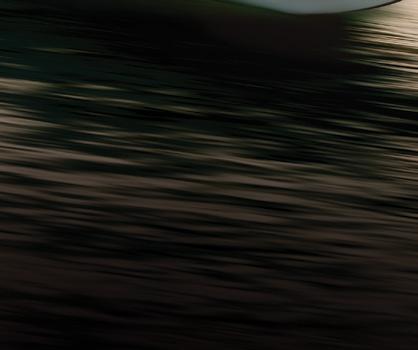
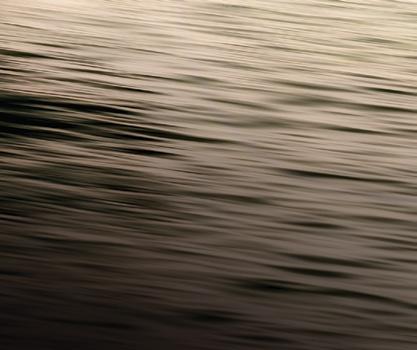



Mid-March we were invited across to the Gold Coast to check out Mercury’s new 350 and 400hp V-10 Verado outboards and their new electric Mercury Avator 7.5e.
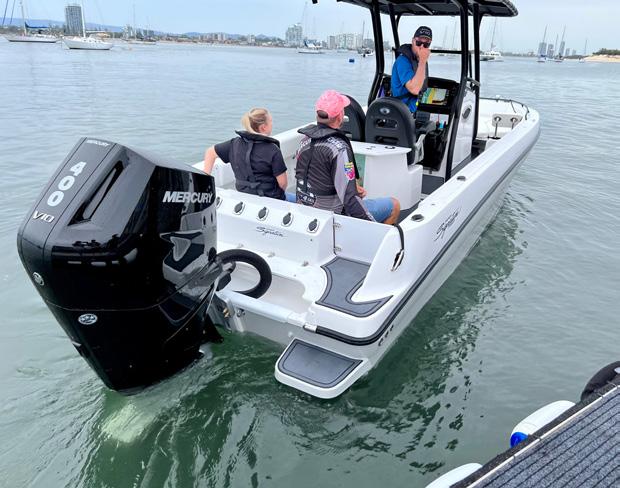
 WORDS BY DOUG DUKESON
WORDS BY DOUG DUKESON
The new Mercury 400hp V10 Verado is the world’s first V10 outboard engine, which has been in development since 2018. V10 engine configurations have been around in performance cars such as Audis, BMWs, and Lamborghinis for some time now –but this is a first for an outboard engine. With the relatively recent release of the Mercury 175-225hp V6, 250-300hp V8 and monster 500-600hp V12, it was almost expected, that an engine would soon be delivered to fill the 350hp and 400hp engine range, to complete the new line up. Mercury’s new 350 and 400hp V-10 Verado, replaces the very successful supercharged 400hp L6 engine, which believe it or not has been around for 19 years. The slightly wider V10 weighs in at 321 kgs, only a few kgs heavier than the previous, taller, L6 at 309kgs. But running on 87 or 91 octane unleaded fuel, the V10 offers better performance through more torque offered by the extra cubes.
This new V10 is a naturally aspirated quad-cam engine that needs no assistance from a supercharger to deliver its power. Instead the 5.7-litre capacity delivers a load of torque for quicker acceleration than the L6, as we discovered on a variety of boats from a Whittley SL 25 family cruiser (single 400 V10), a Haines Signature 788SF (Single 400 V10) Sports fisher, to a twin rigged Powercat 9000 (twin 350 V10’s). The Powercat leapt from the water, with the engines pulling hard, right through the entire rpm range.
For the number crunchers, economy wise, the figures I recorded on the Haines Signature 788SF (Single 400 V10) Sports fisher read as:
AT TROLL SPEED
650 rpm / 1.7 knots / 3.5 l/h
MID-RANGE
3600 rpm / 22 knots / 37 l/h
WIDE OPEN THROTTLE
6350 rpm / 48 knots / 128 l/h
Firstly, the modular design that starts with a narrow 64-degree angle between the two banks of cylinders which is also shared with the V6, V8 and V10 Verado engines. This allows the big V10s to be spaced just 26in apart in multi-engine new installations and repowers.
The V10 outboard has exactly the same bore and stroke measurements as its V6 and V8 siblings (92mm x 86mm) meaning they can all be built on the same production line and fitted with the same pistons and many components.
We were told in our seminar sitting, that the new V10 is up to 56% quieter than its rivals at wide open throttle, and on the water – it was hard to believe there were 10 cylinders working away under the cowl. There is also a very cool Advanced Sound Control (ASC) feature, which at the push of a button, offers a quiet stealth mode or in the lower rev ranges a sport mode, offering
the croakier sound you would expect from a V10. It was interesting to notice, there was no tell-tale, as this was the loudest noise at idle, which annoyed the designers, so they eliminated it.
The all-new gearbox and custom designed Revolution-X propeller has wider blades than normal, to handle the increased torque delivered, increase fuel efficiency and improve steering at low speeds. For the petrolheads among us, there is also a 400R V10, which offers another 200 rpm, stiffer engine mounts, a smaller gear case and gearing worked for top end performance.
The new engine and all engines 250hp plus, can now be set up with Mercury’s new fully integrated power steering system (with the option of a joystick control). This can be set up for multioutboard installations, offering simplified rigging, less maintenance, better response and less clutter through the loss of hoses and actuator pumps. Also means better ‘transom real-estate’.
Mercury have also introduced a range of new features to the next generation controls including, autopilot, auto heading, joystick options and docking assistance.
A newly developed alternator, provides 150 amps of charging power at just 1,500 rpm. This is over twice that of the previous 2.6-liter L6 engine and 30 percent more than the Verado V-8s. Mercury have also developed a new 48-volt alternator to charge the latest Navico Fathom e-Power lithium-battery-based auxiliary power system which is an option as a replacement for an onboard generator. This has the capability to feed power-hungry devices such as air-conditioning and gyro stabilisers and also offers rapid charging for the house and starter batteries.

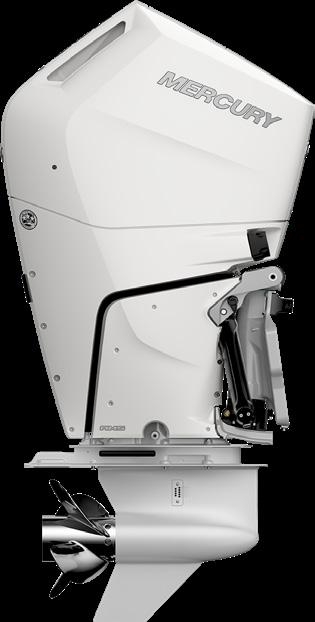


Mercury also had on show their new Mercury 25 and 30hp four stroke, which we all got to experience. This new 500cc, 3 cylinder engine, weighs in at just 60kgs, a whole 11 kgs lighter, cleaner and more economical than the previous model and is SmartCraft compatible (via phone).

MERCURY 600 V12
To blow any cobwebs out, Mercury also had on hand a 600 Gemini fitted up with their 7.6 litre 600hp V12 which was released in 2022. We again got to get out and burn some fossils in the 2 speed gear case steerable V12. To read more about our V12 reports visit the websites listed to the right:
Power 350hp & 400hp
Max rpm 5800rpm – 6400rpm
Capacity 5.7 litres
Cylinders 10
Bore x stroke 92mm x 86mm
Weight 316kg
Alternator 12V/150A, 48V/150A
Gear ratio 2.08:1
Fuel 87-octane unleaded
Shaft lengths 20in, 25in, 30in, 35in
Servicing Annually or every 100 hours
Pricing 350XL NZ$64,553
Pricing 400XL NZ$69,997
POWERBOATMAGAZINE. CO.NZ/1200HP-PROTECTOR/ POWERBOATMAGAZINE.CO.NZ/ MERCURY-V12-VERADO-600-2/
600 HP V12 PowerCat 9000Mercury can now boast being manufacturers of marine engines, from 1 hp to 600hp in petrol, diesel and now electric propulsion versions. It was the logical and obvious next step in Mercury’s marine propulsion offerings. Designed with the Mercury outboard family look’, the very portable Avator 7.5e produces 750 watts of power at the prop, this equates roughly to the same performance as a 3.5hp outboard, which it felt like on the Gold Coast broad water, without the petrol outboard negatives like fuelling, starting with choke management. Instead we enjoyed a no fume, no vibration performance, with a battery that simply dropped into the top of the outboard. The 1 kw battery could run us for 1 hour flat out at 7.9 kph (about the same time as one tank on a 3.5hp outboard). Or pull the throttle back and we are told you could expect close to 19 hours running at optimum speed levels. The boat seemed to hold at a constant speed no matter whether you had one onboard or four.
The Avator had a comfortable tiller handle, which as well as controlling the forward/reverse speed, also controls the multi-tilt lock / trim levels and also acted as a great carry handle.
The handle is centred, balanced and very easy to carry. The unit weighs in at just 9.1 kgs, with the 7.6 kg battery added, the total weight was 16.7 kgs. The 1kw battery, which is capable of up to 1,000 charges, is energised by a 230w charger, this takes about 3.5 hours to power up to full charge. Ideally positioned on the front of the engine cowl, is a bright integrated intelligent display (with GPS), even in the bright Gold Coast sun, it clearly displayed the speed, battery level, range, warnings and settings with features and data that is manageable via a Mercury app on your phone.
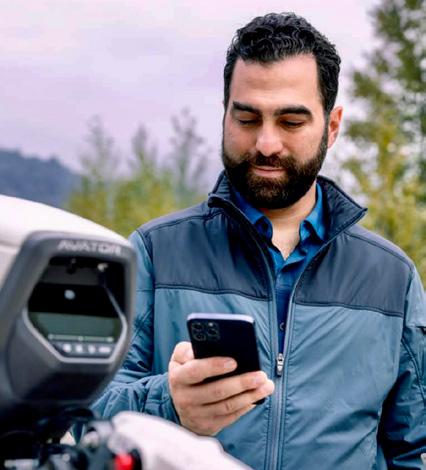

I feel the Avator 7.5e, which comes in at (15” shaft) $6,498 will be a great addition to your dinghy at the holiday home or tender on your diesel launch, the later, avoiding the need to carry gasoline onboard.
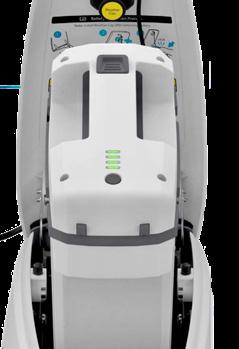
Moving forward, Mercury are planning to release a 20e (5hp) and 35e (9.9hp) version later in 2023 (with remote controls as an option), these will come with an external battery and switch box, capable of running multiple battery options. MERCURYMARINE.COM

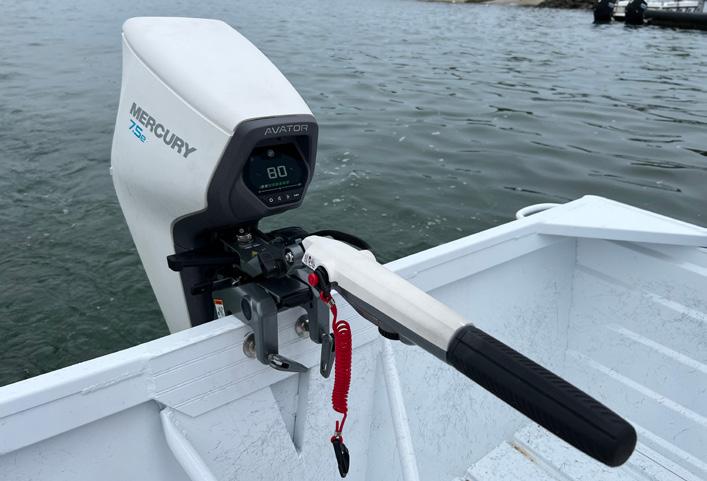 The 1 kw battery can run for 1 hour, flat out at 7.9 kph, or 19 hours running at optimum speed levels
The Avator weighs in at just 16.7 kgs
The 1 kw battery can run for 1 hour, flat out at 7.9 kph, or 19 hours running at optimum speed levels
The Avator weighs in at just 16.7 kgs
Some boaties still haven’t tried our antifoul... Those who have - won’t try anything else!

Developed & manufactured here in NZ by our technical team - mad keen boaties themselves!




• Compatible over other antifoulings
• Exceptionally high loadings of cuprous oxide
• You will achieve a sprayed finish with your roller, for all you do-it-yourselfers!
• Semi ablative to allow washdown without removing paint for a race-ready finish.

• Deal to that green algae and black mould on any exterior surface on your boat.

• Use on Teak Decks, Gel Coat, Sails, Sail Covers, Awnings or any fabric covers or clears.
• Will not affect stitching or exotic sail fabrics.
• Perfect for RIBs when the mould is growing on the PVC tubes.
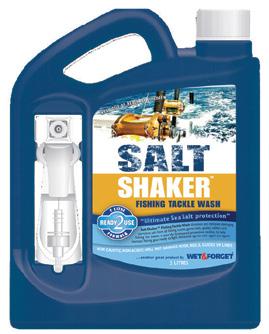
• Boat & Trailer Wash , salt removal, gives additional corrosion protection for galvanised boat trailers.


• 2L makes approximately 240L of product.
• Fresh water does not dissolve salt effectively, but the surfactants in Salt Shaker, attack the salt molecule, allowing the salt to be flushed away.
• Reapply to galvanised trailer, springs and brakes to help prevent corrosion!
RTU Fishing Tackle Wash is also for salt removal on reels, roller guides and rods

While the pontoon boat market in the USA is one of the fastest growing sectors, it is almost unheard of in New Zealand. Well, now, Kiwis have a chance to experience this very different style of boat with the introduction of the US-built Bennington range. Barry Thompson went to Taupo to check out the 25 QSB, the flagship of the Bennington fleet.

Firstly I need to explain the term ‘pontoon’. In New Zealand, we refer to pontoon boats generally as rigid hulled aluminium chambered boats, mostly in alloy, that typically have tubed sides. The first hull to claim this status was the Stabicraft 3.5 dinghy built in 1987. Today, dozens of manufacturers do Kiwi-style pontoon boats with more than 100 models.
Bennington was founded in 1997, and since the beginning, the company have focused on leading in innovation and design with meticulous attention to detail and quality. Step aboard the 25 QSB, and
it is easy to see they mean business, and I can understand why they are one of the industry leaders, building 55 boats a day.
The curved bow and forward-facing arch give the 25 QSB an unmistakable silhouette that sets it apart. While this is a proper party boat, it is still well formatted to be appreciated by Kiwi buyers that will see it as a family boat.

The first two Benningtons to arrive in New Zealand in early 2023 were the 21 SXSR and the 25QSB, brought in through new Australasian dealer, Polaris New Zealand. Retail Development Manager Craig Tillson says the Q range is one of
Bennington’s flagship models developed on a bigger platform, so you can get many more people aboard and make it more of a family boat.
Being sold throughout New Zealand by Trev Terry Marine, MD, Brock Terry said the first time he ran the Benningtons, he felt they performed far better than he thought they would. “They steer and turn well, are super stable, and while they are exposed, I have had both boats out on some very choppy and windy conditions on Lake Taupo and Lake Wanaka, and they were as dry as any monohull”, says Brock.
Party boat or family boat, the Bennington 25 is perfect for both.To understand the difference between Bennington and other pontoon manufacturers, you need to start with the construction methods. Bennington uses what they refer to as their thru-bolt technology on each hull. This system ensures far less flex, plus thick cross channels provide extra vertical strength. Combined with their extruded M-deck brackets and flange bolted deck construction, this minimises twisting and assists in a solid and quiet ride.
The 25 Q Series has various hull options and provides different running surfaces, pontoon diameters, shapes and sizes suitable for multiple applications. Our boat had what they call a ‘tri-toon’ hull configuration which is essential a cat with a centre pontoon.
This ESP Sport Performance package has running surfaces engineered for peak performance and ride
quality. The fully integrated platform boasts two circular 635mm outer tubes and an elliptical 813mm tube in the centre. Constructed of 3mm gauge aluminium, each tube is internally reinforced with stringers and bulkheads. The central tube has a lifting strake on either side, while the outside pods have internal performance foils. All three have solid keels, so you have plenty of protection bringing the boat up onto a beach or rough surface. Engineered for higher horsepower applications and rated up to 450 hp, ESP is optional on select outboard models and standard on 2.6m wide twinengine and sterndrive models.
Bennington has done a lot of development to bring a performance type pontoon boat into the market for various boating applications. Whatever hull form you choose, they all offer unprecedented stability and buoyancy.



There are two models in the Q Line series; the singleengine 25 QSBWA and the twin-engine 27 QSBA. The single-engine models are rated for up to 600 hp, with twin-engine configurations boosting a maximum of 900 hp.
Bennington understands that not everyone wants the same layout, so they offer many options. Once you have settled on a floor plan, the seating can be altered to suit your entertainment needs. Swingback is an innovative floor plan that enables dual seating capabilities by allowing you to face forward or backwards depending on the position of the furniture.
Featuring a quad bench seat format, one of the most popular layouts in the Q Series, the configuration maximises seating, storage and lounging space while still leaving a starboard side access to the aft deck. The five-position swing back seating layout allows multiple seating and lounging positions, all flanked with speakers and drink holders. You can also fold the backrest down so you have one large sunpad.
There is ample storage under the rear seating, plus a pop-up privacy enclosure, perfect as a changing space, or it can be fitted with a portable head.
Twin adjustable bucket seats bring the cockpit seating aft to 5-6, and with the seats swung around, you have a great entertaining space. After all, this is a party boat. The starboard helm is superbly dressed with a single MFD in the centre and all the necessary controls and switches conveniently placed. With every available space used, storage has not been forgotten in the Bennington. Such as large lockers in the mid console, under the forward loungers, underfloor and around the transom. A cool feature is the portable drink holders that can be positioned anywhere around the lounge seating.
The Q Model has a flowing design that’s both inviting and functional. There’s a port side gate and a bow gate onto a short foredeck which makes getting aboard the 25 QSB great from a marina, dock or off the beach. While you might call the Bennington a bowrider, it’s more than that. It does have an open bow and seating on either side, but the big difference is it has a walkthrough bow onto a short foredeck. Surrounding the bow is a stylish fibreglass fairing, with alloy panels running all the to the transom on either side. There is storage here for the anchor tackle, ropes and fenders. A stowable sculpted rectangular bow table is also provided with more drink holders. I was impressed with

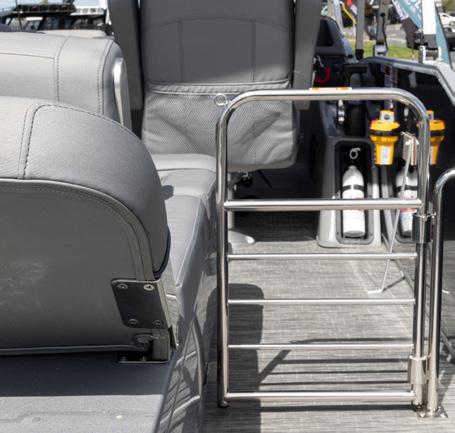
the quality and presentation of the upholstery, from the double stitching in the seats and side panels to the carpet and embossed company logos that reminded me of Bentley. The furniture style and accents all blend well with the Sunset Red exterior. As a slogan I saw says, "There are pontoon boats, and then there are Benningtons!"
The 25 QSB comes with a forward facing fibreglass bimini arch that looks racey and gives the boat a certain character. The electrically operated bimini affords extra weather protection in the cockpit, with another available for the bow area. Sorry, but you’re open to the elements if you are sitting in the bow.
Lake Taupo is a beautiful venue to review boats, and it was the perfect setting for the Bennington. I envisioned the ride being like a powercat that would lean outboard on the turns. So I was surprised that it felt no different
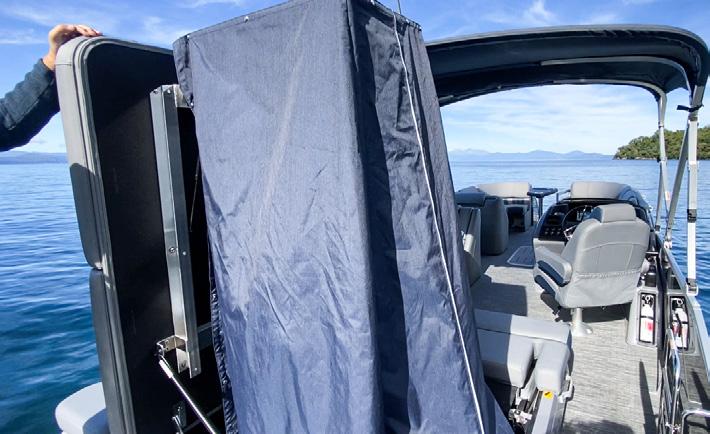 The privacy enclosure is a surprising feature.
The kids will be safe with the stainless safety gate.
The tri-toon hull shape is quite apparent.
The privacy enclosure is a surprising feature.
The kids will be safe with the stainless safety gate.
The tri-toon hull shape is quite apparent.
from a conventional mono hull. The ride and handling felt precisely the same, but it shone when it came to hard turns. The tri-hull doesn’t heel at all and stays perfectly level and flat.
Plus, it is not susceptible to weight distribution. To illustrate just how level the hull rides, with 110 kgs of passenger weight moved forward to one side of the bow, there was no appreciable difference to the boat trim at speed. Stability at rest is unquestionable, and with three pontoons, the Bennington 25 is virtually unsinkable.
From the helm position, it doesn’t feel any different than driving a large bowrider, and while I was on a calm lake, I thought it would handle itself in a reasonably choppy sea. Craig said he had run the boat on a rough day on Lake Taupo and was surprised at how well it coped with the conditions. I am not sure how it would handle a rough Hauraki Gulf chop, but I would certainly like to try it.
The central pod is designed to deliver solid water to the propeller, so there is plenty of bite. When I pushed the throttle down, the boat quickly accelerated, and
Design Name Bennington 25 QSB
Price $NZ349,990
Year Launched 2023
Builder Bennington
Designer Bennington
Hull Type Pontoon
LOA 8.30m
Beam 2.60m
Height on Trailer 2.80m
Trailerable Wght kg
Max Speed 37 knots
Construction Alloy Hull / Fibreglass Deck
Fuel Cap 140 litres
Engine Yamaha 250 Vmax SHO Propeller
MFD Simrad Go9
Ent System Rockford PMX-2
Contact Trev Terry Marine Ph 073787779
brock@trevterrymarine.co.nz
TREVTERRYMARINE.CO.NZ
POLARISNEWZEALAND.COM
Note:
there was a minimal transition (hump) onto the plane. It’s like it’s already planning at rest. With the Yamaha 250 I saw 37 knots on the Simrad Go9. The boat felt just right, cruising around 4500 rpm @ 27.5 knots. Unfortunately, we could not record any fuel data due to a fuel reading issue.
If the boat is loaded with people, getting on the plane and maintaining a reasonable cruise speed is effortless. The three hulls provide buoyancy and keep the boat stable and level.
Bennington’s bold, forward-thinking design puts the pontoon boat on a whole new level of acceptance. It combines the best of a pontoon boat and the most coveted attributes of a fibreglass bowrider. Graig admits that it will take some time for Kiwis to understand and accept this ‘new’ boating style, but he is confident there is a market in some regions of the country. Party boat or family boat, the Bennington 25 has it covered.


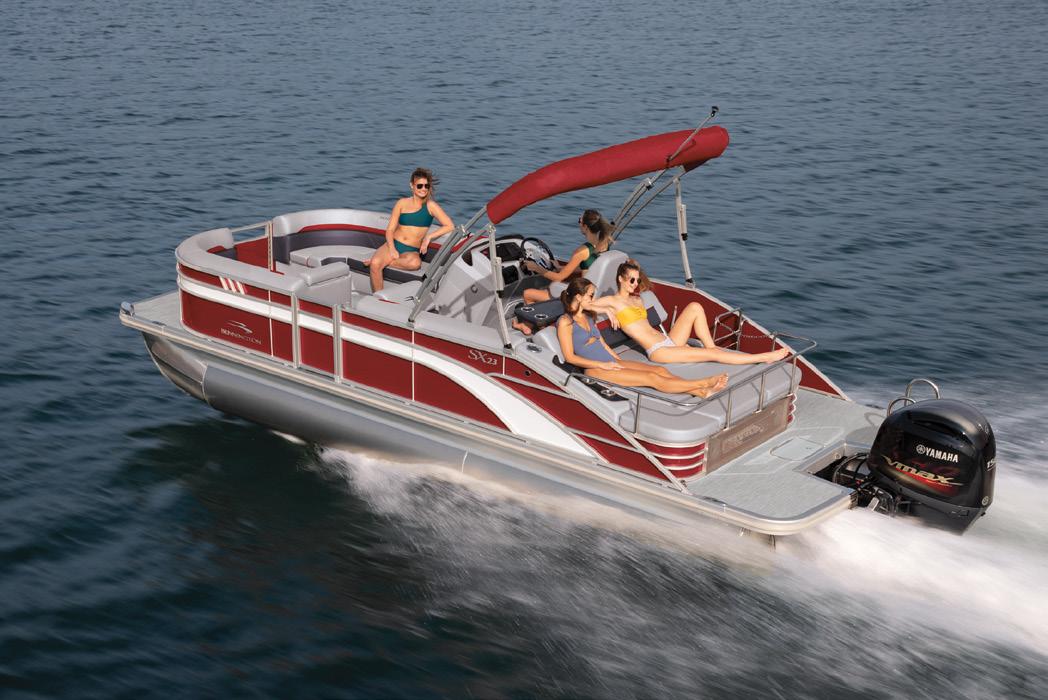








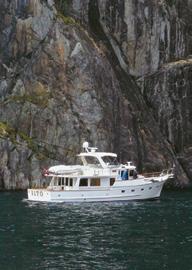


 BY RON CZERNIAK, MARINE CONSULTANT
BY RON CZERNIAK, MARINE CONSULTANT
What a difference a year and a half makes! Only eighteen months ago I wrote an article for this magazine about Electric Outboard Motors. At the time, there were certainly a number of manufacturers offering electric outboards, but inboard electric motors were not as evident. Fast forward. Fortuitously, since Part 1 of our Inboard Electric Boat Propulsion series was published (March/April 2023), I was able to attend the recent Auckland On Water Boat Show in late March. Wandering the show to research the latest news in regards to the state of local and international marine industries in regards to Inboard Electric Motors, I could not help but notice how many outboard companies, not just the specialist niche market companies like Torqeedo, ePropulsion and Evoy, to name but a few; but also traditional outboard motor companies like Mercury, have entered the electric outboard market. And, believe it or not, some of these electric outboards are the equivalent of 300 Hp fossil fuel engines!
But back to electric inboards. Having researched and written about the status of the Inboard Electric Boat Propulsion market and, having learned how fast and how far this market has progressed, I was still not prepared for the plethora of manufacturers offering practical electric inboard alternatives. Even more impressive was how many boat builders, and their customers, are embracing electric technology options. As with cars, a decade ago, “petrol heads” in the marine market, until recently, were still in the majority. This is rapidly changing and many boat builders I spoke to at the show, where electric propulsion is now a viable alternative to conventional ICE (Internal Combustion Engine) propulsion for their vessels, are incorporating electric technology. On the consumer side, there is an increasing demand from customers to go green with their boats, wanting to reduce their own personal carbon footprint, reduce the demand for fossil fuels and as a bonus, enjoy the quiet of electric propulsion while also eliminating the smell of diesel or petrol fumes from their ICE exhaust.
In my last article I stated that we would be looking into the progress of some of the
companies mentioned in Part 1 and explore more about the actual boats that they have, in reality, built or are building and on which they have, or will be installing electric propulsion systems available from the manufacturers also previously mentioned.
However, a quick note before you continue reading, for those that still struggle a bit with electric terminology versus ICE terminology.
Fuel Tank = Batteries
Litres of Fuel = kWh of energy available
1 Horsepower = 0.75 kW approximately (or, If you prefer, 1 kW = 1.341 HP)
0.738 lb/ft. = 1 Nm (Newton metres)
Therefore if a fossil fuel boat hypothetically holds 100 litres of diesel and you burn 2 litres an hour at 10 knots; on a full tank you can run for 50 hours or 500 nm.
An electric powered boat is very similar. If you know your boat has 100 kWh of available energy in its batteries and you use 2kW at 10 knots; on a full battery you can run for 50 hours or 500 nm (assuming 100% efficiency).

Putting things in comparison, I recently read a new hybrid electric car review article and they quoted the power of the vehicle as being 103kW/220Nm. If you’re still a fossil fuel thinking person this vehicle equates to 138 HP/162 lb/ft. of power. Got it?
Earthling (EV) Ltd has come a long way in the short period of time since I first mentioned them in Part 1 of this series. In chatting with John McGettigan recently, he stated that Earthling does not view the Pacific market (NZ, Australia and the Pacific Islands) as mature yet and thus far he has primarily focused on Europe, and partnered with European suppliers, even though boat and systems were designed and implemented from NZ.
While analysing markets with the most potential for the “Earthling E40”, John felt that geographical areas with calm seas and
interesting populated topography, like that of the Mediterranean and South East Asia (SEA) should become his target markets.
Interestingly, as I put the finishing touches to this article, some breaking news. Earthling has just entered a partnership in South Korea which will bring the E40 and E-THOS system to the huge developing pleasure boat market there. As would be expected, John it is extremely excited with the prospect of exporting NZ technology to a very high tech and advanced electrical propulsion (think Hyundai and Kia) focused country such as South Korea. Having spent considerable time along the southern coastline of South Korea during my time with Vetus-Maxwell, I can attest to the suitability of this being an area with generally calm seas, great cruising grounds and an affluent, sea orientated population.



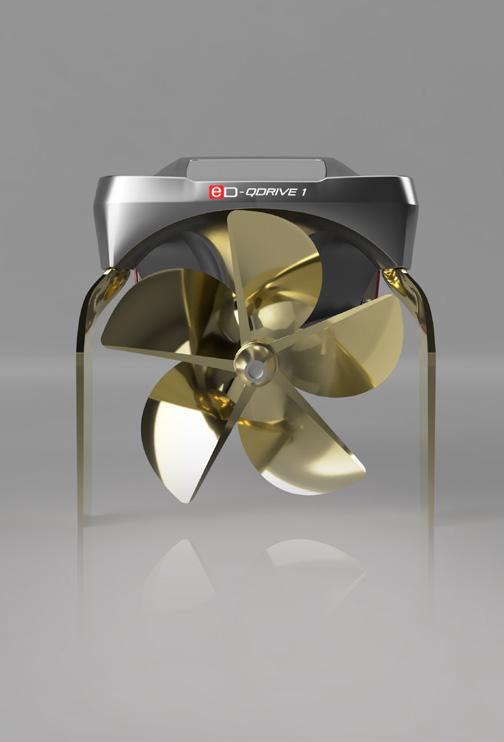
Being the Eco-Warrior that he is, John intuitively recognised that electric boat propulsion was the future even though he didn't fully comprehend, at the time, the full capabilities of marine E-Propulsion. However, without even a nod to existing offerings he adopted a true blank sheet approach and went all out to utilise this new technology.
Although John’s focus was Europe and SEA, since logging approximately 500NM this past summer in New Zealand, some interesting observations were made, proving the E40 is a very capable Hauraki Gulf Cruiser with no ports of call necessary. His conclusions can be concisely bullet pointed as follows:

• Extended stays without infrastructure didn't matter. There was no need to plug in or fuel up. Solar and the highly efficient backup generation system coped seamlessly.

• Although daily passage making in excess of 30NM required Hybrid mode, the diesel DC Genverters used only 3-4Ltrs p/ hr, continuing to drive the boat and complete the daily voyage legs quietly at the sweet spot of 10-12 knots, eliminating range anxiety and arriving with plenty of house power for the evening on a silent ship.

• While the hull is very light (3600 kg); mini keels, deep rudders and the huge high torque E-Props kept the boat surprisingly well planted. As with EVs on the road (compare 1600cc to 5000cc V8 size, weight, running cost etc.), the power available on board well exceeds that necessary; which at sea is a real safety net. The footprint is the same and there is no advantage in having the extra power; compare carrying a 5 litre V8 engine in terms of weight, running cost etc. to a 1.6 litre motor, which is all that is necessary 90% of the time.
• Even turbulent seas where not so bad. On a return passage from Kawau Island with over 20 knots of wind and two metre swells, although not pleasant, the crew felt safe, confident and comfortable. With all the drive aft, lifting the knife edged bows through the seas, the voyage was not a slog and the E40 pointed exactly where one needed to go.
• Something pleasantly unexpected was also discovered. In a downwind blow, the E40 surfs really easily, giving the feeling of "Sailing Without Sails", while still feeling planted and on course.
• This light craft, even with another 1000 kg of people and provisions aboard, performed well, proving this vessel is not just a day tripper.
Although the E40 demonstrator is destined to be shipped offshore in June it won’t be long before another arrives in NZ. Although New Zealand doesn’t have the population to provide early adopter market density, we do have the mind-set for marine E-Propulsion and, as John discovered, the physical environment for this E-Cat.
Zerojet/Highfield: I never ceased to be amazed by the depth of Kiwi Innovation within the marine industry. One year ago I wrote about ZeroJet, the New Zealand designer and manufacturer of electric jet systems. After testing their ZeroJet C350 Tender (PPB March/April 2022), I concluded the boat test article with the following comment: “There is little doubt in my mind that ZeroJet and OC Tenders will soon see a massive international interest in their innovative Kiwi products. Watch this space.” Prophetic? Indeed!
Zoom forward to March 2023 and the Auckland On Water Boat Show, where I was able to catch up with several of the people at Zerojet, whom I had met previously and, was also delighted to finally meet Bex Rempel and Neil Mans, the founders of the company.
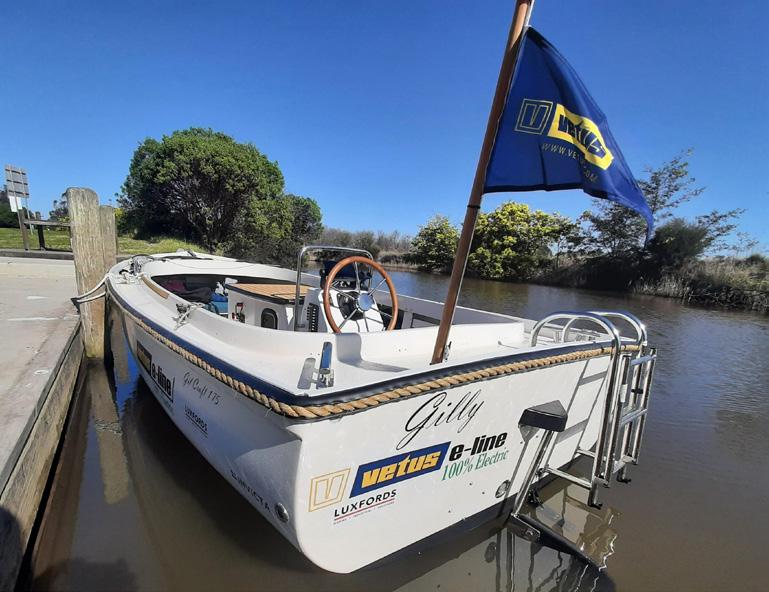
In discussion with David Proctor, Zerojet’s CMO, I discovered that the company’s focus over the last year has been on developing and promoting their electric jet system so that they can supply to boat build partners around the world who will utilise it their designs, rather than Zerojet being involved in boat production. After proving to OCT the worth of the electric jet concept last year, Zerojet continues to work closely with OCT and have their new Gen 2 system shipping with tenders to OCT customers from this September onwards. The increasing supply of their systems across multiple boat builder partners has verified conclusively that it is the way forward for Zerojet.
Now ZeroJet has recently launched an electric jet model, the EJET330, with Highfield Boats, the world’s leading aluminium RIB manufacturer, whose vessels are built in the company's state of the art production facility in Weihai, China and operating under European management. By joining forces, the two companies are combining Highfield’s performance and strength with ZeroJet’s efficient and powerful electric system.
The EJET 330 RIB will be available in the Highfield 2024 range, and with no bulky outboard or exposed propeller, is safer to use in the water. As well as the general benefits of electric over ICE, the EJET 330 can be used in very shallow depths, its low profile allowing it to be easily beached and is the perfect choice for compact storage on-board and in tender garages. The ZeroJet water jet pump and compact electric motor weigh 50% less than a comparable fossil fuel outboard motor.

At 3.36 metres long and 1.82 metres wide, the RIB comes with an FCT one-piece combination seating/steering console system. It features a 10.8kWh battery and power equivalent to 20hp. The boat can reach an impressive 25 knots maximum speed and can cover 12 nautical miles at 14 knots speed. Bex Rempel, ZeroJet CEO & Co-founder, comments “Partnering with Highfield, such a prominent boat builder, helps us to accelerate the industry towards an electric future and provides customers with RIBs which are fun, safe and sustainable.”
As I said about ZeroJet a year ago; “No pollution, no noise. Just you, the ocean, and a rechargeable battery. I like that!” Now having seen the new prototype Highfield EJET 330 at the boat show, I look forward to doing a boat test and experience, first hand, the performance of this new craft. Once again, watch this space.
Vetus-Maxwell, as mentioned in Part 1, recently introduced the Vetus range of E-Line Electric Inboard Motors to the global market. Across the ditch in Australia, Luxfords Marine, the Victorian state distributor for Vetus-Maxwell products, decided that, due to the level of interest in the Vetus E-Line Electric motors, they would undertake their own conversion of a diesel powered boat to Vetus E-LINE electric propulsion for research and demonstration purposes. They selected a somewhat derelict 17.5 foot Gil Craft sail boat, saved from years of further decay which was originally powered by a 12 hp Swedish diesel engine. Having removed the cabin and built a centre console to make it into a day cruiser, they completed the fit out exclusively with Vetus-Maxwell equipment. The demo boat idea was due to the level of interest in the new VETUS E-LINE motors and the questions raised by potential customers regarding range and performance vis-à-vis engine hp to electric Kw conversion and ease of installation.
Luxfords discovered that by doing a conversion themselves, a fantastic learning experience ensued, not only on how easy the E-LINE was to fit and connect up, but how to retro fit batteries, wire everything up
correctly and how to recharge the batteries. They were then able to put theoretical propeller calculations data regarding E-LINE performance calculations into reality and on launching discovered that the actual performance out on the water was as exactly per the Vetus engineer’s data. Love it when a plan comes together!

Once launched, the boating experience proved to be amazing, with smooth and quiet torque. Throttle response was even and linear, allowing great control when docking and the ability to use boost mode to push though strong currents or to lift the boat onto the trailer when retrieving. Additional benefits include battery monitoring through a digital shunt and NMEA2000 communication, plus Wi-Fi to a smart phone, giving real-time data and confidence on the water in regards to range relative to speed, wind and tide. Not to mention, zero smell, zero fuel spills, zero oil leaks, zero annual servicing and zero concern over; “Is it going to start or emit an embarrassing plume of smoke when I hit the ignition”?
Summing up, the E-LINE motor and controls are on par, price wise with an equivalent diesel engine and although batteries, particularly lithium, are more

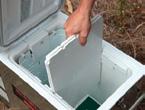


expensive, the warranty and duty cycles far outweigh their counterparts and will pay off in a few years of diesel fuel and engine service costs.
Specifications
Powered by Vetus E-Line 5 Kw Run time @ 4.5 Knots (hull speed) 7.2 hours
Batteries: 3 X INVICTA LiFeP04 48V 75Ah giving a total of 225 Ah equalling 10.8 kWh. A 12v 105 Ah AGM runs control circuit and 12v accessories
Recharge time with a 48v-18 amp wall charger is 3-4 hours
eD-TEC/Q-Speed is a collaboration between New Zealander, Leigh Michau, founder of Q-Speed and German, Michael Jost of start-up company eD-TEC. Between them and their ‘Believer Team’, they have designed and developed a system to offer an electric drive solution to the boating industry for vessels from small day boats and tenders to performance cruisers up to 30 metres in length.
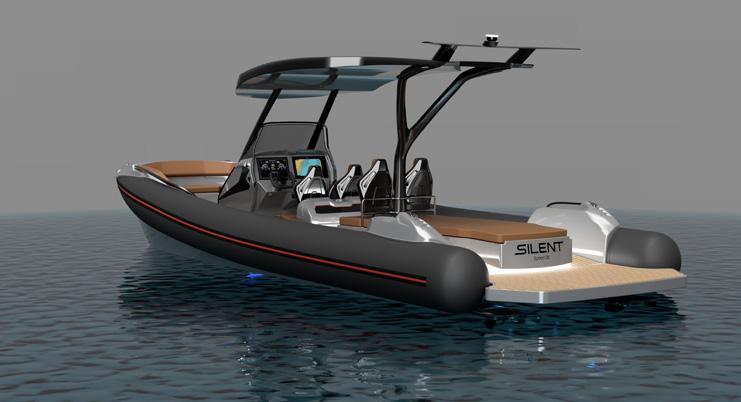
eD-TECs 360º, end to end technology stack, encapsulating full electronic control systems, energy storage and charging system and high performance propulsion system, all connected to and supported in the cloud via advanced AI, was illustrated in Part 1.
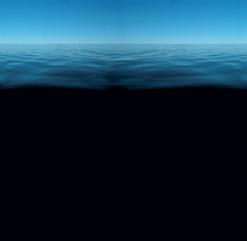
Companies that are approved to build boats to CPC certified standards are:


The enormous eD-TEC/Q-SPD power solution is in the eD-QDrive; a fully integrated propulsion package designed and developed by collaborating with by Leigh Michau, owner and designer of the Q-SPD surface drive system.
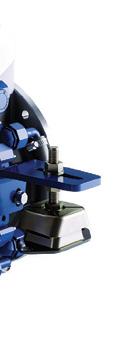

economy and maximum range capability at 25 to 30 knots. This means working with efficient hull designs, ultra light weight manufacturing, including the carbon fibre composite construction eD-Q-Drive, for the best possible power to weight ratios.
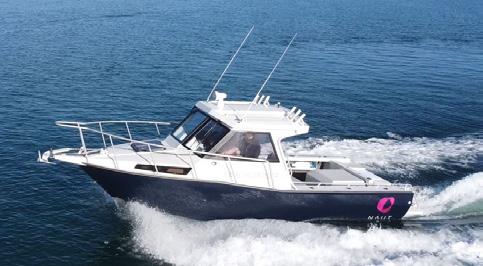
The eD-TEC development program is utilising an 8 meter light weight high perfromance speedster, purpose built for the eD-TEC platform by Kaiser Bootsmanufaktur in Germany. As we go to press, integration and testing of the entire system is taking place at the Kaiser yard, including testing of all systems in their purpose built test pool to ensure all systems are working 100% before moving on the sea trails.
and peak short burst speeds in excess of 60 knots, are expected.




To enable such performance, speed and range, eD-TEC is developing a light weight high C-rated* (high capacity charge/ continuous discharge capability) battery system, with options from 80 to 320kW. A high C rated battery is required to enable high power draw from the battery system for extended periods, thus enabling longer range at prolonged higher speed.
By embacing Q-SPD’s already proven and successful surface drive technology, eD-TEC have employed the most effective form of propulion for planing boats and in so doing, offer the highest propulsive efficiency possible. To quote Michael Jost, “We are not interested in going slow –the eD-QDrive and the eD-TEC tech-stack is built around the principle of GO FASTER, GO FURTHER”. As such the company has targeted effectual solutions which will typically have +50 knot peak speed capability, but will have the best
Concurrently, as the first prototype production boat nears completion and as soon as the test program is complete, a collaboration between eD-TEC and Silent Yachts will see the first production boat series using the full eD-TEC/Q-SPD package. Following the principles of ‘highest efficiency integration’, the 8 meter, foil assisted Silent Speed 28 catamaran will be fully spec’d as a high end tender. A cruise range of 70 nautical miles at 30 knots,
Naut, as mentioned in Part 1, designs and builds electric propulsion systems which include an inboard system that will work with jet units, stern drives or Naut’s own electric outboard with the focus on the 6 – 12m trailer or marina boats, which







are commonly powered by equivalent 150-300 hp engines. Naut believes it is the only marine electric propulsion company, where the design and build occurs 100% in NZ, focusing on commercial products of this size. While primarily focusing on the propulsion system, Naut have a suite of design partners they work with, to complete bespoke boat and electric propulsion designs specifically meeting customers multi boat fleet needs.
We introduced Naut in the March/April issue and since then, such is the confidence in their product and R&D, Hillfarrance Venture Capital Fund has invested $1.5M into Naut. The investment allows Naut to accelerate the development of their systems. Secondly, Naut has experienced a significant increase in discussions and contracts with customers and boat builders, both within NZ and globally, proving yet again that the interest in electric boat systems clearly continues to grow, whether due to getting an ROI, reducing pollution and noise, or just having the best and latest technology!
Naut aims to have their inboard system available for order later in 2023 and the outboard early 2024. I look forward to doing a boat test later this year and In the meantime, any customers or boat builders interested in discussing opportunities to

join the growing market that is electric boating, should contact Fiona Bycroft, the co-founder and CEO at Naut in Whangarei.
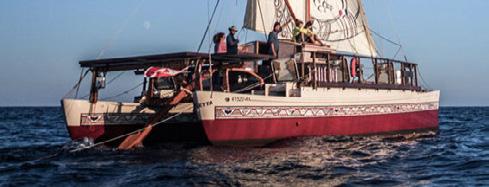
EVOCEAN, representing ePropulsion and Oceanvolt here in New Zealand, were featured in Part 1 of this series. Since then they have been very busy over the past several months and after visiting Evocean at the Auckland On Water Boat Show recently, I was impressed to discover that they have now completed or are in the final throes of completing a few very interesting electrically propelled boat projects. However, as far as ePropulsion goes, their I-Series inboard motors have only just been released and the first units are now coming off the production line in China. Here in New Zealand Evocean is about to receive one of the first 10 units produced and it
should be in the country by May. This I-Series unit will be installed into a classic 28 foot yacht.
In the meantime, Evocean have another project close to completion; a 5.5 m RIB. Although not inboard propulsion, it is fitted with two 10kw ePropulsion electric outboards. This vessel will be tested by Westhaven Marina, and all going well will become one of their fleet.
In regards to Oceanvolt inboard electric propulsion, Evocean has been involved with three installations here in NZ, all utilising Oceanvolt systems. The first one being a 50ft catamaran, which has two electric Oceanvolt 15kw sail drives with two generators and battery packs. The second was a Leopard 45 sailing cat installed with two Oceanvolt 15Kw sail drives, batteries and a generator. The last one was a traditional Vaka, a new build by Lloyd Stevenson boat builders. Two Oceanvolt AXC10 shaft drive electric motors, batteries and generators were fitted to this traditional South Pacific vessel.

Torqeedo, although not a Kiwi manufacturer, it is mentioned here simply because of the fact that they are an international company at the forefront of electric boat propulsion, both outboard and inboard and are strongly represented here in New Zealand through their long standing distributor, Power Equipment, located on Auckland’s North Shore. We featured Torqeedo in the September/October 2021 issue of Pacific Power Boat magazine in an article entitled “Silent Power” – The 2021 Buyers Guide to Electric Outboards and Trolling Motors”.
While Torqeedo is well known for their electric outboard motors, what is not so well known by many boating end users, is the fact that they are also at the vanguard of the design, manufacture and supply of inboard electric motors. Torqeedo’s superior electric motors are suitable for powerful motorboats, large sailing yachts and commercial vessels such as ferries. With up to 100 kW the high-RPM version easily powers planing boats, while the low-RPM version is ideal for large yachts and other displacement vessels.
In speaking with Dave Low, Power Equipment’s NZ Branch Manager, he advised that although there haven’t been any significant projects in NZ yet to be fitted with the high voltage/Deep Blue Inboard systems, there are plenty of examples from other parts of the world, as illustrated above.
The Deep Blue System is a fully integrated high-performance system for propulsion and energy management, propounding a high-power electric drive system for motorboats that offers exceptional performance, professional safety and easy operation. Motorboats and fast yacht tenders can choose from a range of “state
of the art” inboard models up to 100 kW. With a 9-year limited battery capacity warranty, outstanding efficiency, and a proven long service life; backed by Power Equipment here in New Zealand, Deep Blue is an excellent solution for powerful electric motorboats.
Although Torqeedo offer several smaller Deep Blue options, from the smallest 25 R (25 kW) through to the 100i (100 kW), for fast speed boats, most interest will be for the Deep Blue 100i 900, which is suitable for heavy displacement vessels, with its robust direct-drive motor delivering 100 kW of emission-free power and over 1,000 Nm of torque and the Deep Blue 100i 2500with a 100 kW motor, specifically constructed to power fast, planing motorboats. With a reliable, low-maintenance, direct-drive design, the Deep Blue 100i delivers extraordinary performance, with up to 2,700 RPM and a torque of 437 Nm.
The Torqeedo Range of Electric Inboard Motors are offered to fulfil the requirements of nearly all types of boats and it is all but certain that a New Zealand boat manufacturer will be collaborating with Torqeedo/Power Equipment to build a vessel fitted with a Deep Blue inboard electric propulsion system before too long.

JP RIBS, a well-regarded industry name has evolved to better reflect the full scope of their offering - and their ambitions.
JP RIBS began with the combined vision and experience of father-son duo, Phil and Jonathon Edgar, growing to a team of 22 from their base on Auckland’s North Shore, and boasting some of the country’s best boat building and design talent.

While this legacy gives them a foundation of creditability and reliability, they’re an ambitious Kiwi company in pursuit of
progress. The agility of their lean but clever team, and a fearlessness when it comes to pushing boundaries, imagining what’s possible, and embracing challenges, now as JP Crafts, has them embarking on a new era of marine excellence. It brings together four key divisions of their business: their projects, marine specialist services, partnerships and custom crafts.
Stepping away from the typically siloed approach within the industry, director Jonny believes that future-fit vessels should take shape through collaboration, collectively advancing industry innovation by bringing together world-leading technologists with superior craftsmanship.
As part of this, JP Crafts is now pioneering new technology in partnership with green-energy innovators, Sealence, and is the first in Australasia to proudly integrate the Sealence DeepSpeed jet-powered electric propulsion systems into their craft. Their vision is to offer inboard electrically propelled crafts like no other, starting with a 40-foot, fully electric wave surf craft, fitted with two Sealence drives. The Sealence DeepSpeed is a truly innovative system. It is a completely new marine jet propulsion unit with unprecedented performance in terms of more thrust at any speed, better efficiency and is extremely silent. It is a truly unique inboard/outboard system that brings substantial advantages in terms of installation and safety.
Being both full-electric and hybrid, the marine jet propulsion unit offers unprecedented performance with more thrust at any speed, better efficiency and reduced noise. The advanced energy management system guarantees maximum comfort with the lowest environmental impact, through fast charging. In Full Electric Mode there are zero emissions.
Hybrid mode brings the same autonomy as conventional propulsion, but improved efficiency of their propulsion system sees emissions reduced between 12% and 17%.
While some developments are still under wraps, JP Crafts has a number of local and international projects in the works that will see them expand on the next evolution of both electric and traditionally powered vessels. This includes an electric charging station marina in conjunction with the Queenstown City Council and an 80 foot Vaka based in Aitutaki.

When you understand the collective knowledge behind the brand, you can see why they’re a team trusted by project partners to bring the boldest of visions to life. Although driven by continual progression, the essence of JP Crafts still remains true to the personal, meticulous service that Phil and Jonny grew their name on - just the kind of approach that helps to maintain New Zealand’s cutting-edge boat building reputation, globally.
Up until now we have been focussing on inboard electric motors and drives but, needless to say, the essential requirement electric boat is power. With and ICE motor it is petrol or diesel, but with an electric boat motor it is batteries.

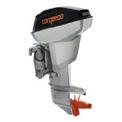




Enertec Lithium Ion batteries are designed and manufactured by Enertec Marine Ltd., established in Auckland New Zealand in 1987. Enertec have long relationships with some the world’s best known marine electrical power product brands.
With over 10 years’ experience with Lithium Ion batteries in both marine and land based applications, the team at Enertec, in typical kiwi fashion, saw the opportunity to develop a new generation of Lithium Ion batteries specifically for the marine industry which would resolve some of the installation issues with other product offerings.

To achieve this Enertec Marine teamed up with the Electrical Engineering Department at Auckland University to help develop a cutting edge Lithium Ion battery management system and cell balancing system to allow superior performance and longevity. Finally, with the growth in electric propulsion aboard vessels and the requirement for higher voltage DC battery
systems, the Juice Lithium Ion Professional series of batteries were designed with an integrated series balancer to allow a simple solution for these typically higher voltage applications in mind.
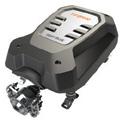
Enertec are seeing an increase in customers wanting to build electric vessels or convert existing vessels to electric both here in NZ and abroad, establishing overseas distribution to cater for demand. Typically, these will be catamarans or displacement mono hulls who want quieter operation and a more environmentally friendly footprint. These vessels are typically installing 48V systems which require a battery bank that

can work in series whilst maintaining balancing between the batteries. Electric propulsion applications require a battery solution that can deliver high current when needed by the electric motors, and accept high charge to recover in the shortest time possible. Juice Pro Series Li-Ion batteries have been designed with this in mind making them ideal of Electric propulsion systems and the unique demands these systems place on batteries.

As proven by ZeroJet, there is also demand for Li-Ion batteries in small trailer boats and tenders wanting to use the latest technologies in inboard electric propulsion. While Enertec also see this as an exciting market, there are a number of challenges here. Typically these builds required a level of customization to allow the ‘form factor’ of the battery to fit the vessel. Enertec certainly has the technology and expertise to offer these customized solutions, however given the level of product development involved it usually either requires a contribution from the client towards the development, or forward orders for the designed product to make it cost effective for Enertec to cover the development costs in house. A somewhat chicken and egg situation.

Something I hadn’t mentioned in part one of this series regarding the selection of Li-Ion batteries was the all-important issue of compliance. It is one of the most limiting factors, with a significant amount of product being supplied from overseas not complying with New Zealand regulations. Therefore it is worth noting that for a standard pleasure boat, electrical installations have to comply with AS/NZS 3004.2:2014, which includes a section for installation of lithium Ion batteries. If the batteries do not comply the vessel should not be offered an Electrical Warrant of Fitness (EWOF). Jeremy advised that they had recently also found insurance companies asking if a vessel’s Li-Ion installation complied with these standards and, if not, they were unwilling to insure. One hears mentioned the C-rate* in relation to batteries. This is the unit that battery experts use to measure the speed at which a battery is fully charged or discharged. For example, charging at a C-rate of 1C means that the battery is charged from 0 – 100% in one hour. A C-rate higher than 1C means a faster charge. E.g., a 3C rate is three times faster, resulting in a full charge in 20 minutes. Likewise, a lower C-rate means a slower
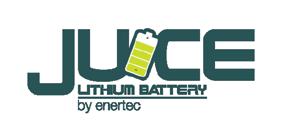
charge: C/5 (or 0.2C) would be five times slower than 1C, amounting to a five hour charge. So, the higher the C-rating the faster the charging and higher the continuous discharge.
All food for thought and important considerations if you are seriously contemplating building or buying an inboard electrically propelled vessel. If one wants to look further outside New Zealand, just do some internet searches regarding inboard electric boat propulsion and I guarantee you will be gob-struck by the enormity of information out there and you will be impressed by the number, size and variation of electric boats actually on the market and being put to daily use. The marine industry is fast catching up with the automotive industry when it comes to electric propulsion in boats, whether it be pure electric (BEB – Battery Electric Boats) or hybrid (think PHEV cars), where batteries and supplemental fossil fuel generation is required to keep the batteries charged and/or propel the boat if necessary. Electric boat propulsion, whether outboard or inboard, is happening now and will continue to happen exponentially in the months and years to come.
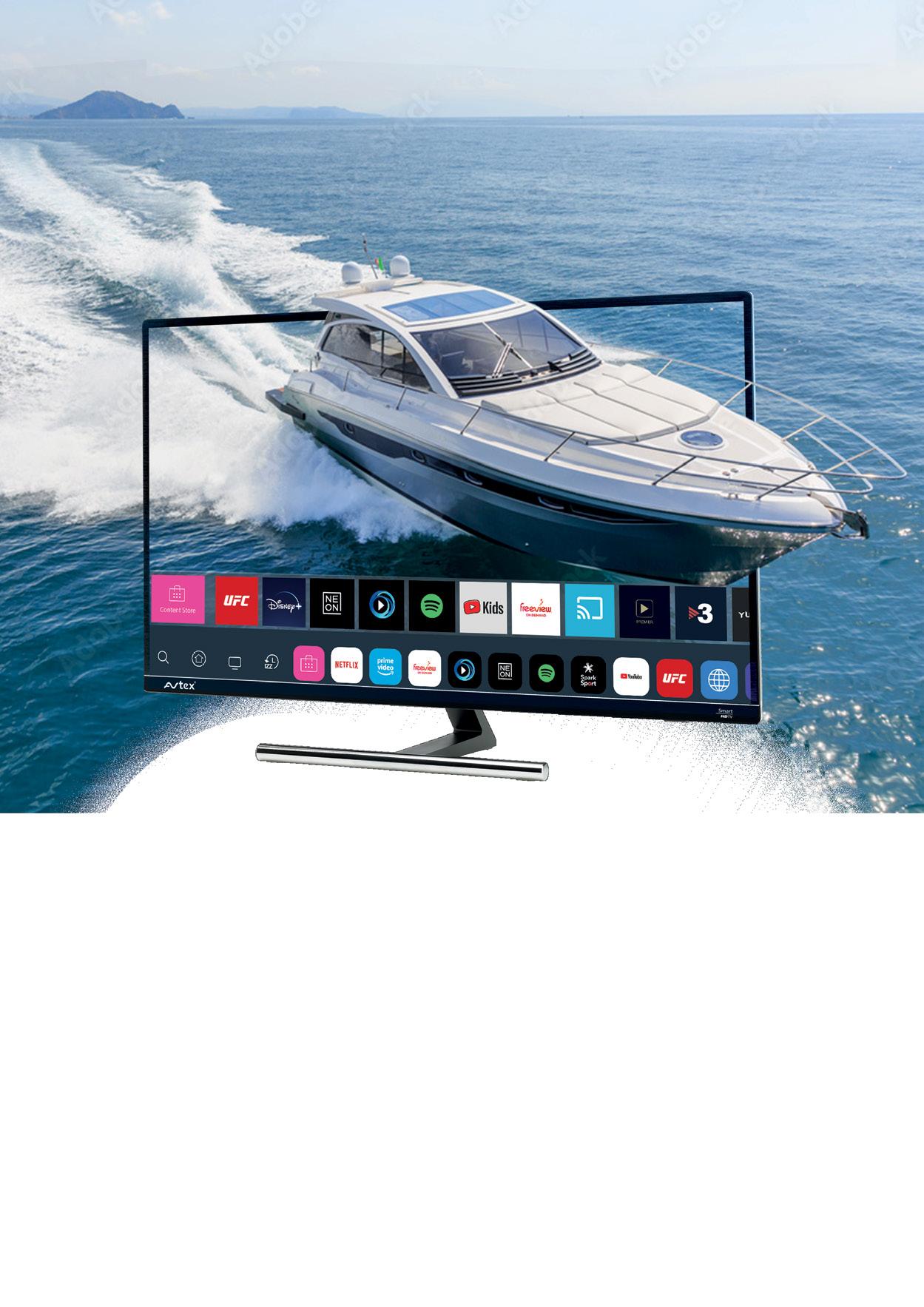












Custom boat building is alive and well in New Zealand, and Lloyd Stevenson Boatbuilders is unquestionably one of the most active and versatile. The full custom Artnautica 60 is one of the latest examples completed by LSB and reflects their exceptionally high standards of craftsmanship and bespoke building.

When the owner of Matuku first approached designer Dennis Harjamaa, his requirements were quite specific. “He started with a clean sheet of paper with four things in mind – a sports fisher, a passagemaker, a family floating holiday home and a dive platform. Not too much to ask, I wouldn’t have thought”, says Dennis.
a cruising speed in the mid-20 knot range and long-range capabilities in displacement mode. Along with the open flybridge, an important design criterion was a dry ride at both planing and displacement speeds.
Matuku blends meticulous craftsmanship, a practical layout and a superefficient hull form into one exceptional package.

Then there was the wish list which started with an 18m length overall and a lightweight boat powered by Volvo Penta IPS engines, and it needed to get to Fiji at 10 knots without carrying extra fuel. The layout requirements call for a spacious cockpit for stand-up game fishing, an open flybridge with low weight and reduced CofG, plus anyone in the saloon must be able to see the horizon from wherever they were sitting. He also wanted a smooth curved transom with no swim platform. Harjamaa’s response was, firstly, to achieve the lightweight, the boat would need to be built 100% carbon fibre with a mix of infusion and pre-preg. Interestingly the trade-off of building in carbon fibre is that while there is a substantial increase in material costs, these are largely offset by the reduction in labour cost and the time to build the boat.
“Matuku was built like a modern race-yacht with every single item having a weight budget and being weighed on and off the boat during construction. Also, the decision to go all carbon fibre still kept us below the contractual budget,” added the owner.
The Artnautica 60 (Matuku) design called for
“The way to achieve easy planning is to minimise weight and to maximise the planning surface area. The long waterline one gets with the plumb bow is essential for high displacement speeds, and keeping the waterline entry sharp smooths out pitching motion. The high chine, in combination with the pronounced topsides knuckle line and rub rail, all work together to knock down spray’” explains Dennis.
One of the owner’s requests from the first brief was he wanted to be able to cruise the 1500nm to Fiji at around 10 knots without adding extra tankage. Matuku will do that and more with a range of about 2000 nm at 10-11 knots. Power is a pair of Volvo Penta D11 IPS 800, producing 625hp each. Maximum speed is just over 30 knots @ 2450 rpm, which returns a fuel burn of around 7.4 l/Nm. However, that’s not where Matuku will spend most of its running time. The optimal cruise speed is around 23 knots, using 6.5litres per nautical mile, giving an approximate range of 830 nautical miles. At a trolling speed of 8 knots, consumption is only 20 lph or 2.35 l/ Nm and a range of around 2400nm.
Matuku is the result of a collaboration of not only the owner and designer but also a group of like-minded experienced boating
The saloon has high profile side windows
friends who enjoy their fishing and cruising and know what they want in a boat this size. Many elements of the boat have come from a vast pool of people. The owner reflects on their many discussions to achieve what he feels is a near-perfect boat that has fulfilled every criterion he wished for.
The design brief for the saloon has certainly been meet with high profile side windows with narrow mullions giving everyone in the saloon almost unbroken views outside. The raised fore and aft lounging spaces are at a perfect height. With weight still a consideration, all the interior cabinetry is foam with a blonded oak veneer finish, with Flexiteek used on the cabin sole, cockpit and coamings.
The aft galley has Miele appliances, Hi-MACS surfaces,


an Isotherm fridge and freezer drawers. Opposite is the L shape settee that converts to another berth when required. The layout of Matuku is very much what the owners wanted, and the designer is quick to add that you can have just about anything you want.
Two large leather Llebroc seats dominate the helm, which features a trio of 16” Furuno glass screens. There’s a pair of Black Box VHF radios and controls for all the onboard equipment, such as Humphrees interceptors, Fusion head deck, Flir camera and HP watermaker. Four large wipers are tucked out of sight under the eyebrow above the screen.
The entire main deck becomes a glorious indoor/ outdoor living space with the rear door and window open. An external staircase provides access to and from the open flybridge, with the raised upper deck offering coverage from the weather. A perfect area to enjoy a
 Twin Volvo Penta D11 IPS 800 give Matuku a max speed of 32 knots.
with narrow mullions giving almost unbroken views outside.
Twin Volvo Penta D11 IPS 800 give Matuku a max speed of 32 knots.
with narrow mullions giving almost unbroken views outside.
drink, have a meal or watch the action in the cockpit. The rest of the self-draining cockpit is all about fishing. The owner is into his stand-up game fishing, so there’s no chair. This is serious stuff, so the cockpit reflects that. Tuna tubes and live bait tank, naturally. There is no boarding platform and a single transom gate. Deck fittings are all recessed or flush, and anything to do with fishing tackle, bait or wet storage is handy and easy to access. The cockpit has been designed to have two people hooked up with plenty of room to move around. A deck hatch aft gives access to the twin Volvo Penta D11 IPS 800s, with another forward leading down to a large utility space. This comes with a watermaker, gensets, a diesel heater, a freezer, dive bottle racks, and a dive compressor, and a pair of Njord fuel polishers. Had the owner gone for the full beam aft master option, this space would not have been available.
Matuku has been designed with three cabins and two heads to sleep six and has an overflow capacity for at least two more. In contrast, the initial brief was for a full beam master, which meant raising the saloon sole and the flybridge. Harjamaa persuaded the owner that this would compromise the sleek low profile aspect of Matuku, so a master forward was chosen. The owner wanted to keep the CofG as low as possible, so raising the cabin was not an option. Hence, the master stateroom is forward, with a central king-size berth with easy access on both sides, plenty of storage for drawers, under the berth and hanging lockers and, of course, a private ensuite. The headroom throughout all the cabins is 2m, and all are individually zoned with Webasto air con. Heating is provided from a Post diesel boiler, which provides heating and hot water, and saves
A sports fisher, a passage maker, a family floating holiday home and a dive platform all in one.

The cockpit reflects the owner’s accent on fishing.
A combination of style, elegance and craftsmanship. There are guest cabins on both sides of the companionway.
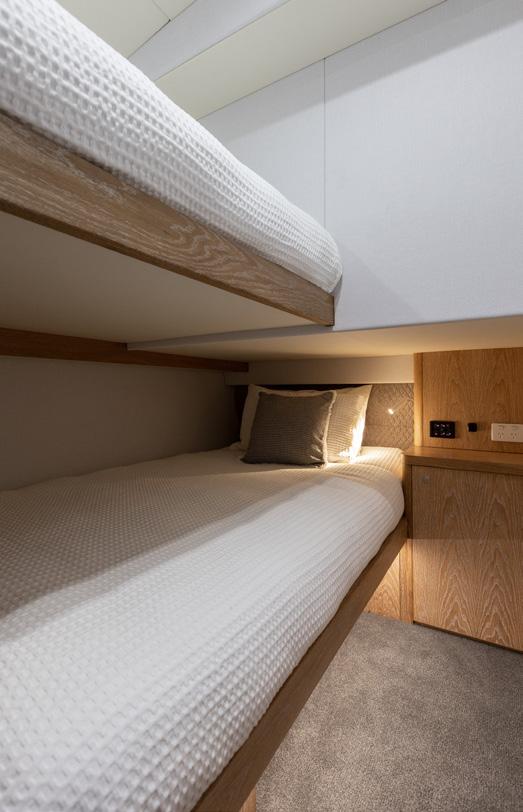
The serious set up utility area under the cockpit.
Setting a new standard trim & stabilization. Priced for 20-45ft
LIGHTNING by HumphreeTM is & stabilization system that comfort, increased speed LIGHTNING is suitable for 20-45ft
Its combination of our advanced user-friendly interface, mobile and beautiful underwater LED what truly sets it apart.
No matter which propulsion outboards, electric, sterndrive, new system will be the perfect build boats or for when you will take you to the next level.
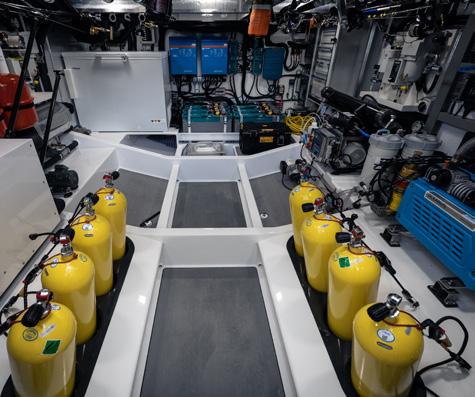


Priced for 20-45ft boats.
Setting a new standard in trim & stabilization. Again. Priced for 20-45ft boats.

TAKES YOUR BOATING TO THE NEXT LEVEL standard in stabilization. Again. 20-45ft boats.
Setting a new standard in trim & stabilization. Again.
Priced for 20-45ft boats.
is an automatic trim brings world class and fuel savings. 20-45ft boats. advanced technology, mobile app integration, LED lighting system is propulsion system you use; sterndrive, inboard—this perfect choice for new refit a used boat. It level.
Setting a new standard in trim & stabilization. Again.
Priced for 20-45ft boats.
LIGHTNING by HumphreeTM is an automatic trim & stabilization system that brings world class comfort, increased speed and fuel savings. LIGHTNING is suitable for 20-45ft boats.
TAKES YOUR BOATING TO THE NEXT LEVEL
TAKES YOUR BOATING TO THE NEXT LEVEL
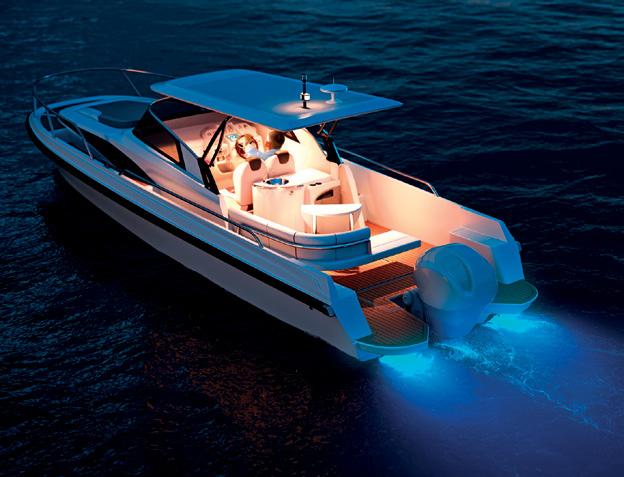
LIGHTNING by HumphreeTM is an automatic trim & stabilization system that brings world class comfort, increased speed and fuel savings. LIGHTNING is suitable for 20-45ft boats.
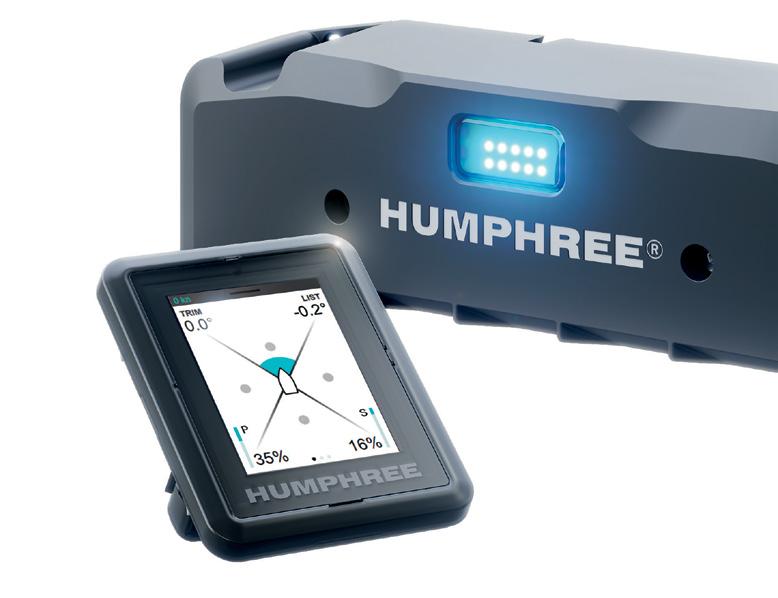
Its combination of our advanced technology, user-friendly interface, mobile app integration, and beautiful underwater LED lighting system is what truly sets it apart.
Its combination of our advanced technology, user-friendly interface, mobile app integration, and beautiful underwater LED lighting system is what truly sets it apart.
No matter which propulsion system you use; outboards, electric, sterndrive, inboard—this new system will be the perfect choice for new build boats or for when you refit a used boat. It will take you to the next level.
No matter which propulsion system you use; outboards, electric, sterndrive, inboard—this new system will be the perfect choice for new build boats or for when you refit a used boat. It will take you to the next level.

AUTOMATIC
VISIT THE LIGHTNING WEB PAGE BY SCANNING
THE QR CODE WITH YOUR SMARTPHONE

The aft galley has a great flow through to the cockpit .The aft galley has a great flow through to the cockpit.
running the genset or engines.
There are guest cabins on both sides of the companionway, and being a custom boat, how you configure the sleeping arrangements is up to you. Matuku has a double to port with two singles that slide together in the starboard guest cabin. The guest cabins share the same head/shower, doubling as the day head. Both ensuites have large shower stalls and heated ceramic tiles on the soles.
As Matuku is not a 100% Sportfisher, the flybridge helm is well forward and not aft, as you would expect from a serious game fishing boat, instead utilising that space for the Williams Jet Tender dinghy stowage and as a social area. There is a third driving position in

the cockpit, so the angler and the skipper can be close together in the same space when a fish is on. There are L shape settees on either side of the central forward helm, and while there is a reverse sheer low profile screen, there are no clears. If the weather gets nasty, the skipper can run the boat from the lower helm.
Matuku blends meticulous craftsmanship, a practical layout and a super-efficient hull form into one exceptional package. A compromise maybe, but it meets the owner’s objectives in all respects. After a Kiwi summer, plans are to cruise to exotic destinations such as Fiji, New Caledonia, the Kermadecs and even a circumnavigation of New Zealand. The Artnautica 60 is the perfect vessel for all those adventures.
Boat Design Name Artnautica 60
Boat Name Matuku
Year Launched 2022
Style Sedan
Builder Lloyd Stevenson Boats
Designer Dennis Harjamaa
(Artnautica Yacht Design)
LOA 18.0m
Beam 5.6m
Deadrise 17 deg
Draft 1.27m
Displacement (Dry) 22000 kgs (Approx)
Max Displacement (Wet) 28000 kgs (Approx)
Max Speed 32 knots
Construction Carbon Fibre
Fuel Cap 6000 litres
Water Cap 900 litres
Engines Make 2 x Volvo Penta D11 IPS 800
Drive Train IPS
Generators 2 x Fisher Panda 21kw
Air Con Webasto
Interceptors Humphree
Lighting Hella
MFD 6 x Furuno TZT3
Winch Maxwell
Flooring Flexiteek
Tender Williams Sport Jet
Ent System: Fusion
Classification DnV-GL High Speed Light Craft
Open Ocean at 4g Acceleration
Contact LLOYDSTEVENSONYACHTS.CO.NZ
 The mezzanine deck features a dining table and U shape lounger.
The mezzanine deck features a dining table and U shape lounger.
The all new Telescopic Shading system by Webasto is ideal for use above the cockpit or rear deck. operated with the touch of a button this smart, straight forward design can be customized to widths up to 2500mm and a range of colours ensuring a perfect match with the styling of your boat.


Features:
Fully retractable
Customisable widths up to 2500mm
Easily retrofitted or integrated by your boat builder
Self adjusting within 5mm
Marine-grade stainless steel tubing
High quality eco-friendly shade fabric

Can be used in tandem with Webasto's wide range of GRP & glass marine sunroofs
+61 (0)2 8536 4800 svc-info@webasto.com
Webasto Thermo & Comfort Australia

One of the most recognised names in offshore powerboat racing worldwide is Jesse James or just Jesse to its fans. In 1986 it arrived in New Zealand to compete in the Class 2 UIM World Championship, and it has never left.

Built in the USA, Jesse James is a 9m Chris Craft, constructed of GRP over a balsa wood core, that interestingly after 40 years, still retains the same livery as it did when first launched. Even more ironic is that the signage on the original Chevrolet Dually crew cab tow vehicle has also never been changed.
So how did it come to be in New Zealand?
In 1986 a group of Kiwi offshore competitors attended the World Offshore PowerBoat Championship in Key West, Florida, where one of the week's stars was Jesse James. Jesse wrapped up the world championship for Class 2 with three races
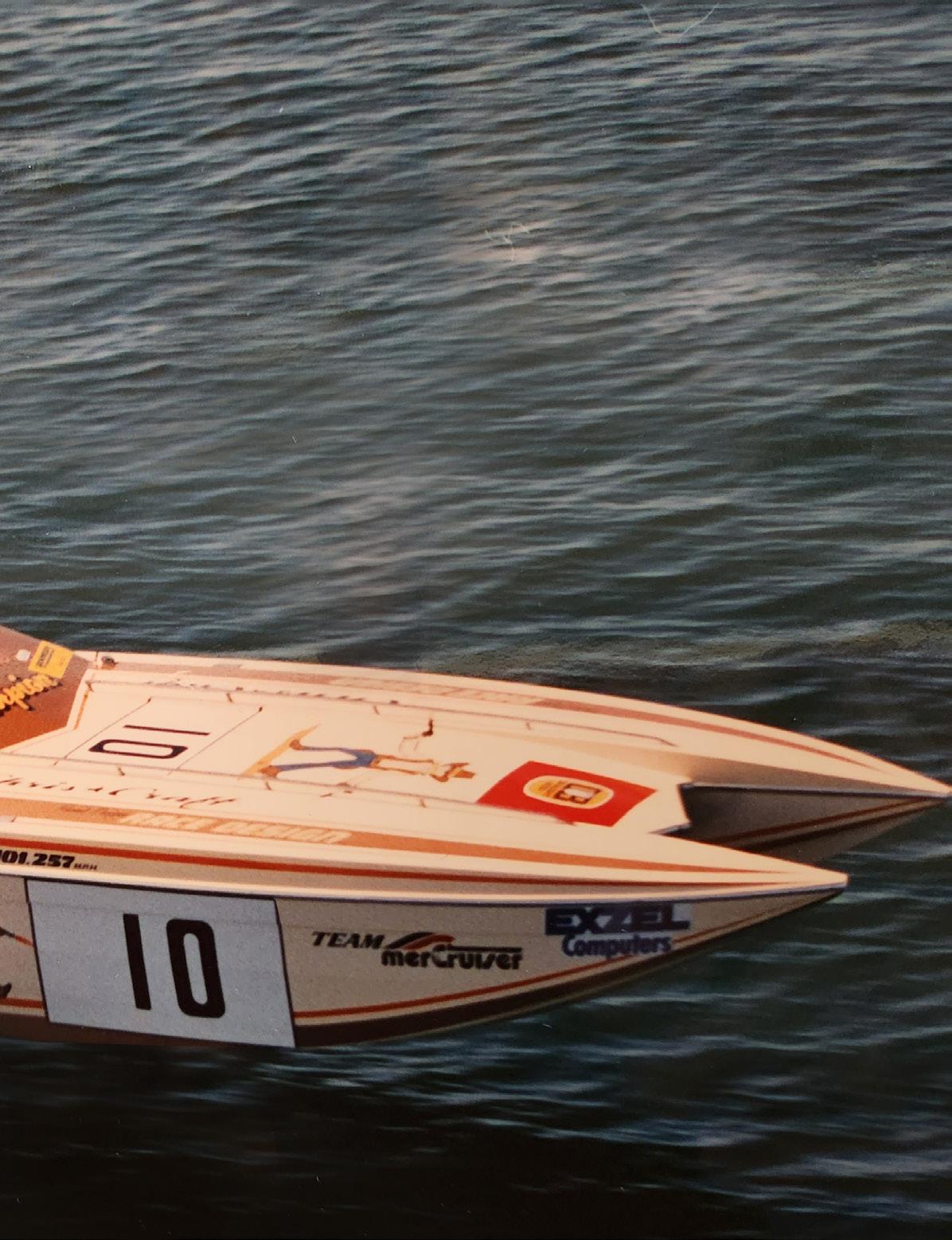
and three wins. Owners Chris and Mark Lavin had already won the American Offshore series in 1984 and 85, plus setting a world record of 101.3 mph. At the time of the '86 APBA Worlds, they were developing a replacement boat to race in the open class, having done everything they could with Jesse.
"I was standing in the pits with a group of Kiwis, including Phillip Mills, when he said that if anyone brought that boat to New Zealand, it would make every other boat redundant. I thought, yep, he's right, so I walked over to the Lavins and made a deal on the spot", says Ross. For about $US250,000, Ross got the
boat, truck and four engines, which he considered a great deal on the day. The same MerCruiser #4 drives that came with the boat are still on the transom, albeit having had a few rebuilds over the years.
A few weeks later, Ross was in Lake X, the Mercury test facility in Florida, where he tested the boat before shipping it to New Zealand. Time was critical as the 1986 UIM World Championship was to be held in Auckland in early December.
"We couldn't get a ship out of the West Coast in time, so we delivered the boat and truck to a port on the East Coast and shipped the boat from there.
It was going to be tight getting the boat in time for the first race, and it was all on track until the ship got delayed in the Panama Canal for a few days, which saw it arrive in Auckland at 5.30 am on race day. Ross even tried hiring a big chopper to lift the rig off the freighter, but it couldn't be done. Knowing the time pressure Ross was under, the shipping people pulled out all the stops to get Jesse unloaded as quickly as they could, and by 6.30 am, Ross was driving his new rig off the wharf and to Ken Grant's North Shore workshop. Unfortunately, it was not quite race ready, so Ross, with crewman Robin Irvine, decided to run their existing boat Rite Pine so that they could score some points.
"That gave us a couple of days to get the boat sorted, and we knew we would be ready for the second race. However, we had a setback when we blew an engine on Rite
Pine and recorded a DNF and no points.
"I knew that we had to win the next two rounds to even be in with a chance to take out the championship, and we had some stiff competition, especially from the Italians", added Ross.
When Ross brought the boat, Chris Lavin told him that when you take off at the start you need to feather the throttle to bring the boat up to speed, otherwise you'll choke it. Needless to say, Ross, who admits he was in panic mode, floored the throttles, choked an engine, and had to stop and start it a couple of times before getting away. Meanwhile the fleet was heading out of Auckland Harbour to the Gannet Rock turn buoy.
"I was furious with myself as I been told how to get the boat on the plane, and in the heat of the moment, I paid the price.
"Once we got going, it was throttles hard
down and I told my driver, Robin Irvine, to hang on as he was about to go on the ride of his life. You have to remember that this was the first time he had driven the boat at speed and it was all new to him ", says Ross. So quick was Jesse that they caught the whole Class 2 field before they got to the Gannet Rock turn mark and from there were unchallenged for the win. Race two saw a better start and another faultless run to notch up two easy wins. But with no points in the first race, that left them in second place overall, a mere two points behind the Italian boat Medidel. "Phillip was right. Every other boat racing in our class was now redundant", remarked Ross.
After the worlds Ross had to look at the local championship and so he and his team did some work to the boat to try and improve the speed even more. The original


engines were two-bolt main, 383cuin Chevs and after a few block failures, Ross decided he needed to look at more reliable power. The decision was made to replace them with four-bolt main Chevs of a similar size, but then they experienced a lot of valve issues. "We were pumping out around 600hp and there was a lot of stress on the engines", adds Ross.
The next change was to a pair of alloy 383cuin Buick V8s, which had a different valve train with 11 deg heads (Chev was 18 deg) and those engines put out 780hp. Built by ace engine builder Tony Marsh, these engines turned out to be the magic ingredient. Ken Grant was responsible for keeping the engines in peak tune for every race. When Jesse arrived in New Zealand, it was running close to 110mph, and with the new engines and some Teflon coating on the hull's running surface, that jumped to 130mph. A few years later, after Ross had sold the boat to Wayne Valder, both the engines were stolen from an engine builder's shop and never seen again.

"When I brought the boat from the Lavins, they said they had got the best out of it and wouldn't go any faster. Yeah, right", says Ross. With the very slippery Teflon coating, Ross remarked that even with one engine off, they could still run 60mph, so finishing a race even with an engine failure was more achievable.
Ross, with crew firstly Robin and then Ken Grant, raced Jesse from 1986 – 1993, won the championship in 1988 & 1991 and remained virtually unbeaten for several years.
In 1990 Jesse was fitted with a couple of F16 canopies as the UIM rules now dictated that boats had to have enclosed or semi-enclosed cockpits. Previous owner Mark Lavin was one of the many competitors killed in an open cockpit boat. Much like the FI Halo, fatal injuries dropped dramatically once the canopies were regulated.
Ross added that when they put the boat back in the water, it ran terribly and wouldn't perform. However, the problem was the lack of air entering the engine bay. The problem was soon fixed by adding more venting, which saw Jesse quickly return to its former handling and speed.
"Once Peter Turner and Graeme Horne turned up with their bigger Class 1 boats, it was obvious that Jesse was about a metre too short in the rougher water. So when I sold it, it was getting to the end of its competitive life as a boat that would suit all the various racing conditions on the NZ circuit", said Ross.
Ross retired in '93 after breaking his neck in a car accident. The boat was parked up for seven years, and in June 2023 it was sold to Wayne and Grant Valder. Wayne & Grant won the 2005 NZ Offshore Championship for National Open Class. Although parked up now for around 18 years, Jesse is still one of the most recognised race boats on the planet, and who knows, one day it will be seen on the water in a poker run or classic racing. There would still be plenty of fans who would love to see it on the water, doing what it does best, go fast and go loud.



The Nimbus T11 is a mid-cabin cruiser that gives a new meaning to social boating. This boat combines the space and amenities for great day boating but still provides the comforts of overnighting.

The Nimbus T11 is a mid-cabin cruiser that gives a new meaning to social boating. Wide side decks lead to the forward lounging space.



The Nimbus T11 offers flexible socialising spaces, plenty of room to move around, good protection from the sun and several spots to lie back and sunbathe and enjoy your day on the water. One aspect of the Nimbus is its simplicity, or what Nimbus like to refer to as ‘easy living.’ Mats Jacobsson, Technical Director at Nimbus, says, “In the design and development process, we have deliberately focused on “simplicity” and “easy living” for everyone on board. It includes being able to easily and conveniently use the boat. Everything that has to do with your Nimbus should feel natural and easy regardless of activity. When things are easy, we feel more relaxed and can focus on the boating experience”. Once I got aboard the T11, I must admit he was right. While it looks busy, it isn’t, and there is certainly space for everyone to do their own thing. There is a feeling of openness, whether you are cooking something on the grill, lounging on the forward sunpad or enjoying a coldie on the rear lounge.
The design is typical Scandinavian, with the plumb bow and styling that sets it apart. The Nimbus T11 is one of four models based on a stepped 12.4m hull, the others being fully enclosed hardtop/sedan style boats. The T11 is the only one with a full walkaround and mid-cabin, with a T-Top, but it shares some similarities in the cabin and bow area.
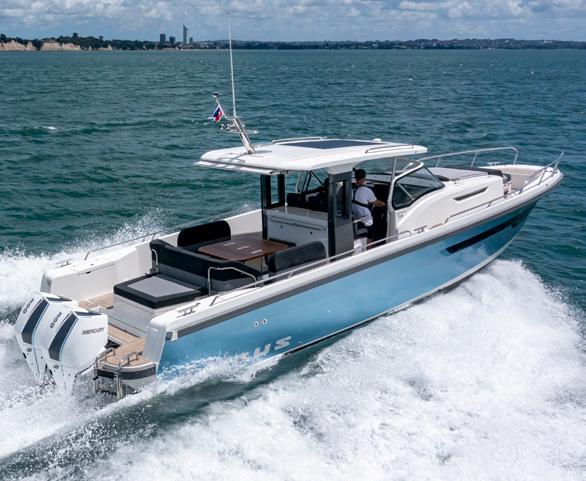
The cockpit, or as Nimbus like to call it, the lounge area, is an intelligent layout that divides the area into three distinct zones. Forward is the helm with a trio of seats with bolsters, footrests and a generous facia that allows you space to add a lot of extras. The dash can be fitted with a single 12’, 16’ or double 12’ MFDs, and there is still enough space for all other controls and systems.
A couple of well-placed wipers keep most of the large one piece forward screen clear, with air conditioning ducts feeding warm air onto the inside. The driving position is excellent, and the screen keeps the wind off your face. Being an open boat, ventilation and fresh air is not an issue. If you want some extra protection from the wind or rain, a soft screen is available to zip on between the hardtop and the screen.
Nimbus are aware that not everyone likes to soak up the UV rays, especially in New Zealand, where they are extremely harsh, so offer full coverage from bow to stern.
The GRP hardtop, held in place by serious box section fibreglass stanchions on either side, offers perfect all-weather protection for the forward cockpit spaces. If you want to add coverage to the rear of the cockpit, you activate the Sureshade retractable canopy,
(Bottom left and right images) The sofas and tables can be rotated and moved into different positions depending on what you want to do.which extends just about to the transom. Even the foredeck has a detachable sun shade that gives all-over protection for the bow area.

Dividing the helm from the rest of the cockpit is a dedicated galley with four drawer storage, freezer/fridge and electric hob. All this is hidden away when not in use under a flip up lid.
I am always impressed with the ingenuity and ‘outside the box thinking’ that Nimbus and other similar Scandinavian brands come up with. On the T11, it is never so apparent as with the rear lounge seating. The word to describe it is flexibility. The sofas and tables can be rotated and moved into different positions depending on what you want to do. The lounge area has three sofas and a large table which, depending on its position, can function as a sun deck or a seating area that can either have all seats facing the direction of travel or alternatively facing one another. Simple and very ingenious.
But it doesn’t stop there. Underneath the rear settee is a sizeable 2500-litre stowage locker. It has space for everything you could ever want to bring, whether SUPs, wakeboards, an inflatable tender, or maybe a Temo electric outboard.

Aft of the cockpit seating is another short sunpad with further storage under. If you are into fishing or diving, it’s perfect for your dive and tackle gear.
The swim platform and the aft deck offer space for fishing, with a telescopic boarding ladder to assist swimmers and divers. A handheld freshwater shower and a couple of aft storage compartments for fenders and ropes are also provided.

420mm wide, deep bulwarks start with a couple of steps to the raised foredeck, which includes a sizeable stainless grate and sump on either side to collect any water before it runs into the cockpit lounge space. Low-profile handrails for security and Flexiteak flooring extend through to the short foredeck. With a through hull anchoring system, all the tackle, including the Lewmar winch, can be kept below deck, leaving the foot space obstruction free. With the split bow rail, bullnose deckline and a clip-on ladder, the bow makes a great place to access the boat. Ideal when pulling up to a beach or onto the stern of another boat. The foredeck includes a large sunpad with backrests and a forward seat, and much like the T9 series, the T11 also has a large storage hatch at the front of the cabin. Below the deck, you will find two separate cabins with space for two couples or a family of four. The forward berth is 1.9m long, and the rear berth under the cockpit sole is slightly longer at 1.98m. Additionally, there is a spacious bathroom with a toilet, shower and sufficient headroom. Storage is plentiful, and a second fridge/freezer is included.
A good size helm with space for everything.
Dividing the helm from the rest of the cockpit is a dedicated galley.
There are twin double berths below decks, plus a separate head/ shower space.
Underneath the rear settee is a sizeable 2500-litre stowage locker.

The T11 stepped hull is designed to work at speed and that’s something the T11 has plenty of. The sharp plumb bow is designed to cut through the water, with wide flared chines that protect against spray and makes for a drier ride. Put the Zipewake interceptors on auto, and all the serious trimming is done for you. The deep vee hull excels in rough water. The Nimbus T11 is an easy boat to drive in most sea conditions. The standard package is a pair of Mercury Verado V8 300s, which gives a speed of close to 40 knots. Other options are twin Verado L6 x 350, L6 x 400, Volvo Penta D4 DPI 320 and D6 DPI 440.
Boat Design Name Nimbus T11



Year Launched Nov 2023
Builder Nimbus Boats

Base Price $765,507
Price as tested in NZ $917,335
LOA 12.40m
Beam 3.46m
Draft 0.9m
Displacement (full) 5600kgs
Max Speed 37.9 knots
Construction GRP
Fuel Capacity 850 L
Water Capacity 135 L
Engines Make/HP 2 x Mercury 300 V8 Verado
Interceptors Zipwake
Bow Thuster SidePower SE100
Air Conditioning Webasto
Anchor Winch Lewmar
Entertainment Fusion
Flooring Flexiteak
MFD Simrad NSX 12
VHF Simrad
Contact Sports Marine SPORTSMARINE.CO.NZ
The last word goes to Gustavsson. “We already added some extra deck space, treading surfaces and wide passageways on this boat’s little sister, the T9, but the T11 takes things to a whole new level. The surface areas are exceptionally generous, and the freedom of movement you get onboard is palpable –not just in the lounge area but also on the aft deck and the foredeck. The boat is far from being over-furnished and freedom of movement is something that you truly feel whenever you step onboard.”
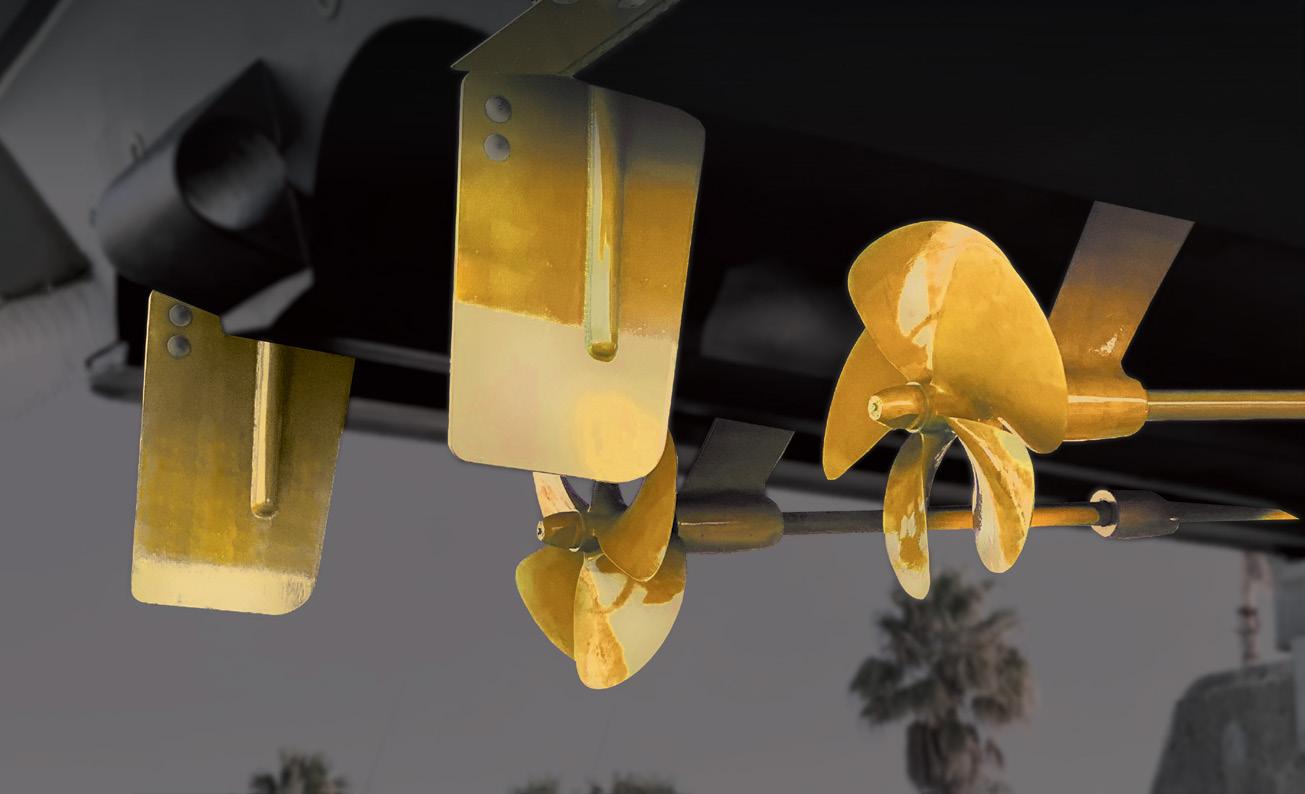


Robson Design had huge success in their early years with their championship winning offshore race boats. It is from this very niche market that Robson

Design has evolved. Today they are one of New Zealand’s leading designers, offering an extremely diverse design portfolio that encompass boats from 2.4m through to 28m plus. Barry Thompson called into the Robson Design studio based in the Cashmere Hills of Christchurch to find out more about the company and principal designer Scott Robson.
For Scott Robson, it all started in 1978 when he was approached by a South Island marathon racer who asked him to design a 5.5m single outboard tunnel hull. Named Times Up, it went on to win its first race in C class at Nelson. This was followed soon after by Hitachi, his first twin-rigged tunnel, for the March Bros and then the successful C Class boat, Miss Exide, for Jim Dunlop.
In 1981 Scott designed the successful single rig Cold Gold and the twin rig, Versatile Garages, which became Mystic Miss
These boats proved to be winners, and people around the racing scene started to appreciate this talented young designer. While success on the New Zealand racing circuit had its rewards and status for the Robson Design name, it was in 1984, with the launching of Sunday News, that was the turning point. Built for Norm Chadwick by Scott (and crewed by the author), Sunday News was a dominant force in the North and South Island B class championships. The Kiwi designed and built cat successfully challenged the might of the internationally recognised Cougars and did it regularly. Long-time racer Phillip Mills was impressed
enough to get Scott to design and build him a radically different cat with central inline seating. Built light with a composite of marine ply, foam, alloy laminated with epoxy it also had very advanced aeronautics with a wider tunnel and an emphasis on a low drag coefficient. Supercat, powered by a pair of Mercury Mod VPs, was the quickest boat on the circuit, with a top speed of around 106 mph. Unheard of back then. Supercat was later converted to twin cockpits and raced by Peter Boylan as Humminbird/Boat City
At the start of the 1985 season, Sunday News was involved in a crash at Lake
Taupo, which injured the driver, Norm and resulted in severe hull damage to the boat’s starboard side. Norm never raced again, and the boat was sold to an ex-circuit racer, Glen Urquhart (Miss Coventry), who had Scott rebuild in time for the 1986 North Island season.
Three main protagonists for the 1986 NI Offshore championship were Paul Stevenson’s Stevensons Express, Ted Taiatini’s NZ Privateer and Graeme Horne’s EIT Mover, all triple outboard Robson designs. Sunday News competed in the very competitive 3D Class, where competition was extremely strong. From the ‘get go’, Sunday News, under its new owner, in his rookie season, proved the boat to beat by taking out race one at Tauranga not only in the class but also outright. Sunday News went on to win both the 1986 3D class and overall championships. But more fame was to come, with Sunday News taking out the World Class 3D championship at Guernsey, Channel Islands, UK. Sunday News dominated against a field of 26 boats with two wins
and a third place. Such was the impact of Sunday News on the world racing stage that it was rumoured that one of the teams went down under cover of darkness and measured every inch of the boat and then went back to the UK and built a clone. It proved to be highly competitive the following season in the UK.
From 1987 through 1998, Robson Design kept producing highly competitive cats for clients in Australia and New Zealand. Amongst them Kyro, Watts & Hughes , Lowes Ego, Team Australia, ETA Ripples and the Stealth 605 and 805. The only departure from the catamaran was in 1993 with the design and launching of the 10m diesel-powered monohull, Line 7/RFD. Over the years, Robson boats have notched up an impressive list of wins, including the UIM Class 3D World championship, an Australian UIM Class 2 Championship, eight NZ Offshore Championships, numerous NZ UIM Class 3 D & E championships, plus NZ Boat Marathon Commission championships and the iconic Sydney to Newcastle race.
Having had success in racing their tunnel hull, Hitachi and winning the 1981 Sth Island championship, when the March Bros, Sam and Buzz decided they needed a new pleasure boat, then who better than the guy that had designed their race boat?
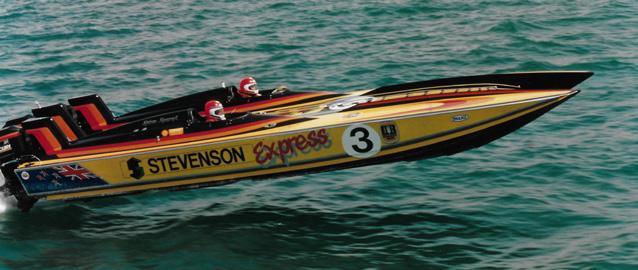
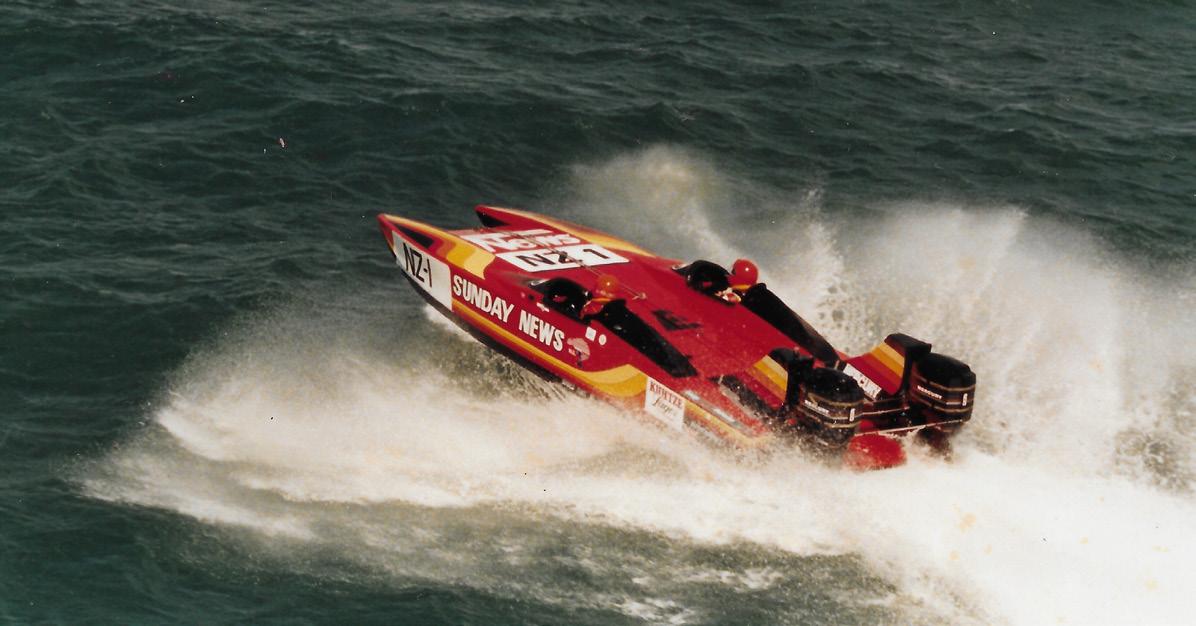
In 1982 they commissioned Scott to design and build a 7.0m asymmetrical tunnel hull. It was constructed from GRP and was a cuddy cabin style, powered by a pair of 200hp Mercs. And now, the recreational side of Robson Design was born.
Things started to get serious when in 1985, he was approached by an Auckland businessman to design the Kona Cat. One of the few trailerable powercats on the market. The Kona cat measured 5.2m and was powered by a pair of mid-range outboards. It was somewhat unique and ahead of its time, with an asymmetrical hull with a semi symmetrical bow. While they were a great boat, they never really took off and although around 25 were built, Kiwis were not ready it seemed for
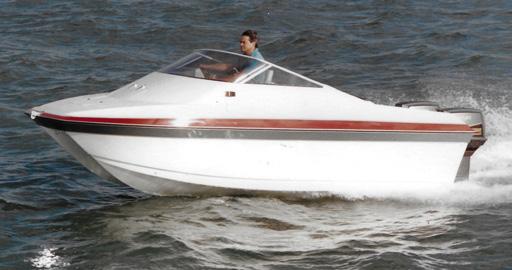 1985 saw the release of the Kona Cat, one of the few trailerable powercats in the country.
Stevenson Express was another winner on the local offshore scene.
1985 saw the release of the Kona Cat, one of the few trailerable powercats in the country.
Stevenson Express was another winner on the local offshore scene.
a trailerable powercat.
In 1988 Robson got their first big break into the New Zealand trailer boat market when they were asked to design a new range of monohulls for Bonito Boats. This included the Bonito 522 and 622 in various models and were a huge success and some of those designs are still around today, marketed under the Smuggler brand.

In 1990 Robson was asked to design a 28ft high performance powercat for Marten Marine. This lead into company owner, Steve Marten having Robson design a 44ft powercat the Robson 404 XRS. This boat was world leading in its technology with a multi stepped asymmetrical hulls with semi symmetrical bows, epoxy foam core Kevlar construction and unique styling and layout. The first big commission was for Mares Yachts, who had heard about the Robson 404 XRS And had travelled to Auckland


to do a test ride This saw four models produced in Auckland, Brazil and the USA. From the Auckland factory Mares build 8 boats, from the Mares 38 through to the Mares 90. A further 25 plus were built between the Brazilian and Florida factories. By the early 90s, Robson Design had a reasonably full order book with well-known builders such as Export Yachts, Vaudrey & Miller, Marten Marine, Phil Bish and Franklin Yachts building custom designs. With his toe into the trailer boat market other New Zealand companies approached Robson for new models, such as Aqualite, Extreme, Barchetta, Smartwave, Altech, Ramco, Kwikkraft and Pinnacle. As well as being the named designer Robson has also been the ‘ghost’ designer for other alloy brands in the country. In 2014 they designed their first trailer boat for an overseas client, the Moda range of trailerable powercats and mono hulls and in recent years, have specialised in
cut files for the alloy boat market. On top of this, Robson Design received commissions from overseas manufacturers in Australia, USA, Brasil, Canada and China.
While Robson has always had a reputation as a power catamaran designer, they are also very committed to designing monohulls in fact out of the over 500 designs to date have designed more monohulls than catamarans. An early example was the 13.5m Siltec, then the 15m Cervesa, the 21m La Diva and the 25m Azzura and, more recently, a range of monohulls for ICON Boats up to 18m.
“If you want to have a successful design business, then you want to be versatile enough to design a broad spectrum of boats regardless of size, hull shape or materials, and that’s what we do at Robson Design”, says principal designer Scott Robson. He adds that currently, they are working on commissions as different as a 6.6 m GRP production monohull to a 24m performance powercat, plus everything

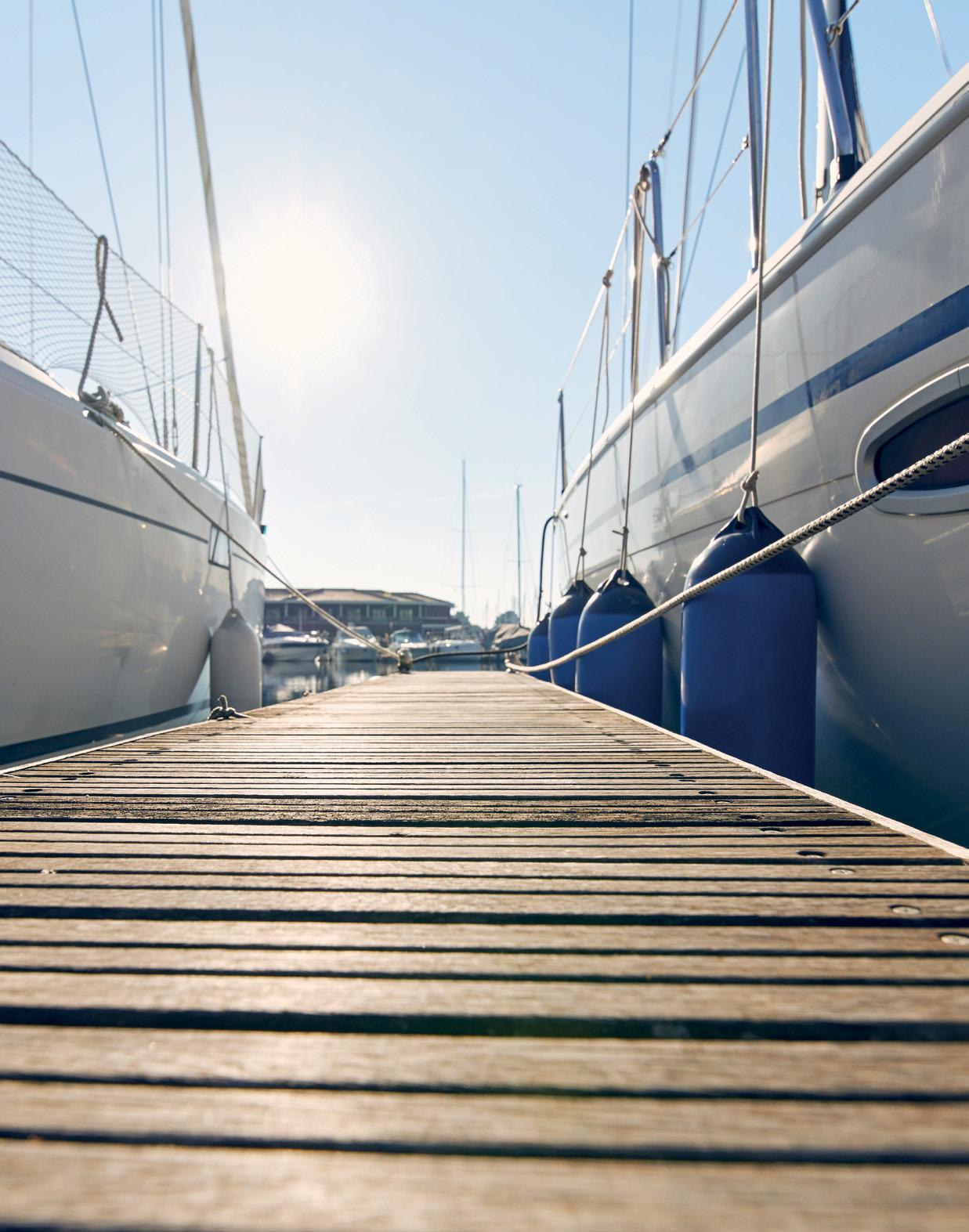





else in between.
“We are also very active in the commercial market in New Zealand, Australia and the Pacific Islands having recently, been involved in three Coastguard rescue boats in Australia and are working on a patrol/ transfer alloy Powercat for the Tokelau Islands with ICON. We were also involved with ICON in designing a multi-purpose powered barge for Pitcairn Island as part of our on-going relationship on commercial projects with them.
Robson design has also developed its ability to design for any construction medium, whether GRP, composite, aluminium or polyethylene.
“One of our more interesting current projects includes a new range of polyethylene boats for a Kiwi builder, for export and they will be unlike anything you have ever seen. Smart, stylish and robust”, says Scott.


“I am bemused when I read something about how designers are now adding foils into their Powercat the claims about being the’ new big thing” because we did our first foiling cats back in the early 90s with Mares, and they were very efficient. Again it’s like the Mares and Kona cat, we were too early, and people were too conservative to accept them. Unlike today, thanks partly
to America’s Cup, foils are now more accepted”, adds Scott.
Robson Design is currently completing design works on over 10 designs. These include the Tokelau power cat, a 13.5m composite power cat the RSV400 powered by twin Mercury 600s, a 16m Sportfishing alloy cat with quadruple Merc 600s in Australia , a 14m ICON Sportfishing alloy Powercat, and an Encore 48 centre cab catamaran to begin construction in Louisiana.
“The American high-performance boat market is a significant part of our future.
We have already established a foothold through companies such as Encore Boat Works, and it will only get bigger.
“We have had over a dozen commissions for high-performance catamarans in the past two years for the Florida market. However, Australia is also important to us with a constant demand for our designs. Right now, some 9m and 10m power cats are being built, and we are working with
a client on a custom 16m sport fisher, says Scott. Working drawings have been completed for a 70ft monohull which will be released later this year. Being built in aluminium in a yard in Hong Kong, the power will be a pair of Volvo Penta IPS1350. Other interesting overseas projects include a 22m Expedition catamaran to be built in Kiribati, a range of alloy production trailer boats manufactured in China, and another range of super high quality 8m-10m alloy boats for an Australian client. Scott sums up the future of Robson Design as doing precisely what they are doing now but striving to do it better. He is confident of being busy for a long time yet. Being as diverse as they are and not being ‘pigeonholed’ into one style or size range has been a winning combination for Robson Design and has allowed them to survive through the hard times and benefit when the market has been strong.



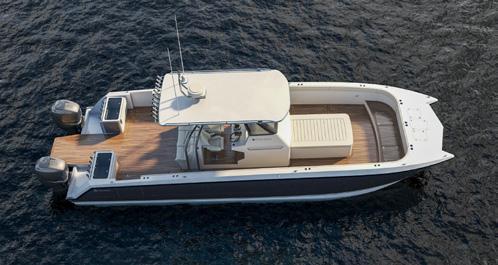


“One of our more interesting current projects includes a new range of polyethylene boats for a Kiwi builder, for export and they will be unlike anything you have ever seen. Smart, stylish and robust”
SCOTT ROBSON PRINCIPLE DESIGNER

Ayear ago I tested FatCat’s 4500 Fisherman Open, single console and tiller steer craft (Pacific Power Boat May/June 2022 issue). I concluded that article with the following summary.
“The boats we tested were pretty much FatCat’s entry level spec, but the company offers quite a range of accessories, including twin, single and centre consoles, Bimini tops, seats, grab rails, dive ladders, rocket launchers and a plethora of other options to pimp up the basic boat. Basic or flamboyant, with the FatCat 4500, you get the convenience of a small boat in an affordable package that offers more space than most and with built-in safety and incredibly stability.
With its simple, uncluttered interior design, cleaning up at the end of the day couldn’t be easier. The rugged polymer hull promises to be maintenance-free and comes with a 3 year warranty.
I concluded by asking myself; “Do the FatCat’s achieve their aims”, epitomised by the following words: safer, seaworthy, load, capsizing, self-draining, unsinkable and affordable? The answer was absolutely! And I also added, functional fun”.
Fortuitously I recently attended the Auckland On Water Boat Show and having heard rumours that Blair McLay, the designer and co-founder of FatCat, was working on a cabin version of the 4500. My interest piqued, I searched Blair down on his stand at the Viaduct Harbour, hoping to get a glimpse of this new model. "I found Blair aboard a Double Console FatCat 4500, not surprisingly talking to a very interested potential customer". But alas, no cabin boat. When Blair was free I asked him if the rumours were true about the cabin version. He confirmed they were and that the boat was for real, but that they hadn’t quite been
able get it finished in time for the show. Asking the inevitable ‘when?’ question, Blair said hopefully in a couple of weeks. Next question. “When can we do a boat review and article”? “Soon”, Blair replied.
True to his word, on a brilliant Auckland autumn day at the beginning of April we met up at Gulf Harbour ready to get out on the water and see how this new Cabin 4500 differed from the open Fisherman and to find out if it performed as well, if not better than the two open 4500’s we reported on last year. Having arrived at the boat ramp shortly before Blair, he soon showed up with a hard to miss, bright green Cabin 4500 in tow. Hmm, no idea why Kermit sprang to mind. This new boat was making a statement even before it hit the water!
As we prepared to launch the boat (not that two people are necessary, such is Blair’s simple and efficient trailer design), I asked him why a Cabin Version? In a nutshell: “We are responding to Kiwi demand for such a craft”. Obviously FatCat had done their market research and had listened to customer feedback. Being a boat designer, it didn’t take Blair long to figure out he already had a great boat in the Open Fisherman, and that all he had to do was design a practical and easy to install cabin for his existing and well proven FatCat 4500 hulls.
The FatCat hulls are rotomolded (rotationally moulded) polyethylene polymer and compared to traditional methods, rotomolded vessels are inexpensive and quick to produce, have a long lifespan, and can take a serious beating. They also happen to be 100% recyclable. A real plus!
By now, Doug had arrived to take pictures of the sea trial and leaving him to head off to the point at the breakwater entrance to Gulf Harbour Marina, Blair and I motored out to put the Cabin 4500 through its paces.

Chatting on the way out to open water, I more closely scrutinised this new variation to FatCat’s fleet. The first thing that struck me, aside from the obvious huge internal volume of this relatively small craft, was that it adhered to a basic marine principle: KISS (Keep It Simple Stupid). In an ideal world, when you own a small boat, you want a vessel that has all the safety and other features you require for an enjoyable experience, while minimizing things that can go wrong. The Cabin 4500 rates highly on both counts.
Starting with the helm station, one sees a clean, minimalist configuration; but with all you really need. Wheel and throttle controls for the 60 Hp Honda 4 stroke outboard are positioned exactly where they need to be when sitting, or standing in front of, the comfortable and adjustable, pedestal swivel seat, mirroring the co-pilot’s seat to port. In addition to the Garmin UHD2 75cv chart plotter/depth sounder mounted on the steering console immediately in front of the driver, a GME GX700 VHF radio is conveniently located right alongside to starboard, immediately accessible for routine radio calls or an emergency. The tachometer resides just below the radio and the angle of the console facia permits this gauge, along with the trim meter gauge, to be read at a glance.

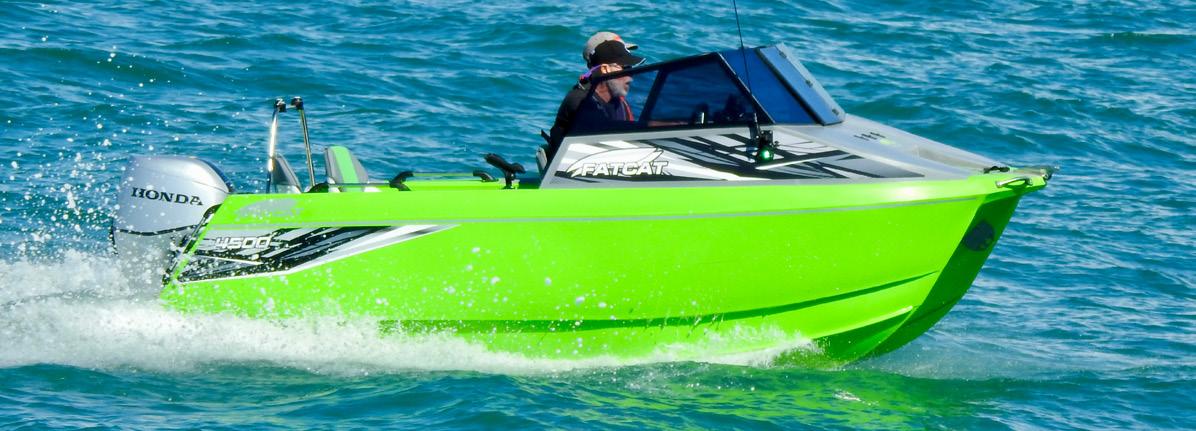
But, before exploring the rest of this boat, let us have a look at what makes this a ‘cabin’ boat. Quite simply, Blair ‘plastic’ welded his specifically custom designed, one-piece superstructure; incorporating a fold-back central window for easy access to the anchor locker, onto his existing open 4500 hull. But wait, I hear you cry: “Plastic weld”? Yes, exactly that. Think about how aluminium boat manufacturers weld together their boats and, in essence, it is the same thing for moulded polymer boats. Except in this case there are only two things ‘welded’ together – the hull and the ‘cabin top’. In effect; a bead of hot plastic is run along the two surface parts to be permanently joined together, and in so doing, temporarily melts these two surfaces together and once cooled, the two joined parts and the welds are as strong as if the whole boat had been originally one-piece moulded together. The weld and surrounds become almost invisible after a bit of cosmetic sanding of the surfaces. It’s not Superyacht quality and it is not meant to be. This is an inexpensive family or sport boat – think fishing or diving for example. A boat that you don’t have to worry about if the kids get a bit rambunctious, or dive weights are dropped on the floor or lead fish line sinkers bang against the hull as your catch is reeled on board. It’s a plastic fantastic built for safety and enjoyment.
With lots of room for up to four people, this catamaran has a beam half as wide as the craft is long (2.05m by 4.6m)! Although somewhat fundamental, the craft, as tested, is sold as ‘ready to go’, including anchor and rode (stowed in a more than adequate anchor locker with an easy access lid and locker drain). Access to the anchor locker is through a ‘fold back’ window, which folds out and back onto the port side of the windscreen and, combined with a lower, fold-down plastic shield, allows you to stand near the bows safely and securely, close to the locker, for easy manual launching or retrieval of the anchor. One of the options FatCat offers is a Maxwell Tasman 6-6 Drum Reel windlass, which easily fits into the existing anchor locker space and is simple to install.
Positioned in the open windscreen space you find yourself standing in two large, open storage lockers which extend across the full beam of the boat. Wide enough to comfortably stand in, unless you have size 12 feet or larger, these bins provide loads of storage space and aside from stowing things like lifejackets, fishing tackle boxes, scuba tanks, etc.; they are a convenient place to stow all-important chilly bins. I mean, seriously, what’s a fishing trip without a few cold beers when you’re out for a warm summer’s day of fishing?
 The grab handles fitted on the hull topsides, alongside the stern seat positions, give you that extra sense of security while happily skipping across the waves.
The hull has a central ‘sponson’ (stability pod) under the wing deck that channels lower and wider towards the transom.
The grab handles fitted on the hull topsides, alongside the stern seat positions, give you that extra sense of security while happily skipping across the waves.
The hull has a central ‘sponson’ (stability pod) under the wing deck that channels lower and wider towards the transom.
On the port side, in front of the passenger pedestal seat and on top of the console, there is a large stow tray, surrounded by retention edges, to prevent items (such as cell phones, sunglasses, etc.) from sliding off when underway. An adequately sized, lidded glove box resides beneath the handy grab rail and to port of this is a fold away drink can holder. Speaking of grab rails, should one be standing at the helm and passenger stations while underway, the top portion of the windscreen sports convenient grab slots, wide enough to hang onto with both hands in a particularly rough sea. I like attention to detail. There is a longitudinal storage locker on the port side forward, beside the passenger seat, but to starboard, this space is logically taken up with the throttle and steering controls and cables, making for a clean and unobstructed look to the whole helm station area.
Looking aft, we once again see the KISS principle at play. Two, 24 litre petrol tote tanks occupy the space beneath the port and starboard stern passenger seats. The battery sits amidships in the built in stern battery box situated between these two tote tanks, which are simply but securely kept into place by a strong length of bungee cord with a securing hook at one end. The fuel filter is located beneath the port, stern seat and the battery switch beneath the starboard stern seat. Speaking of stern seats,
FatCat has cleverly fitted detachable, swivel seats. Want to get them out of the way while fishing or diving? Press the release mechanism and lift and stow them up forward in those large bins. But when in use, these two stern seats are arguably the most comfortable place to sit on this boat; especially while underway in a rough sea. The grab handles fitted on the hull topsides, alongside the seat positions, give you that extra sense of security while happily skipping across the waves. Forward of these port and starboard grab rails are RailBlaza, detachable rod holders, while further astern are standard, flush mount rod holders. Anti-skid deck pads extend over all horizontally exposed portions of the hull deck sides, adding to the safety of these relatively high (0.625 m) top sides, when climbing aboard or departing the boat alongside a marina or dock.
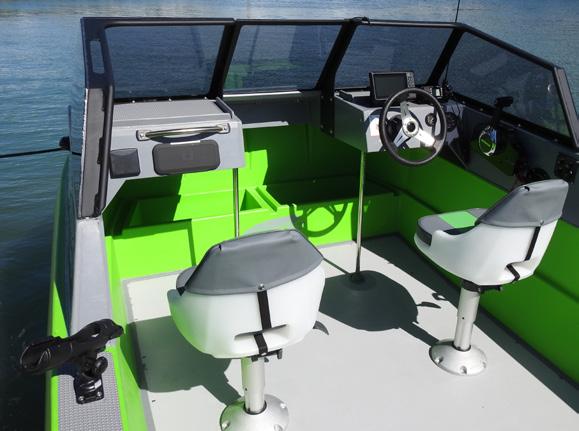

Two other notable features to be found at the stern are an extendable S/S boarding ladder on the port side and over the outboard motor is a S/S arched tube which can be beefed up to act as a tow bar or on which can be mounted the detachable bait board, which can be supplied as an optional extra.

Inside of the boat, now taken care of, let's look at the unique hull on this 4500. First off, the Cabin model shares the same proven hull as the 4500 Open that we
tested a year ago. The hull has a central ‘sponson’ (stability pod) under the wing deck that channels lower and wider towards the transom. This helps smooth the water flow over the propeller to avoid cavitation, which can be an issue for any catamaran with only one engine. Although cavitation is almost non-existent on this boat, even through extremely tight turns; due to the clever hard chine, spray deflecting design. Additional lateral spray deflectors, running smoothly above the lower chine, from the bow and widening gradually towards the stern, also help repel a great deal of water when pounding through waves or in those tight turns. All this making the Cabin 4500 highly manoeuvrable and not surprisingly, even drier than the open model; which wasn’t half bad in this regard. The boat gave us a comfortable ride throughout. The polymer material flexes slightly, softening any hard bangs and deadening the sound, making these much quieter boats than their fiberglass and, especially alloy, cousins, The new Cabin 4500 gets along really well, especially when fitted with the Honda 60 Hp 4 Stroke, which topped out at about 27 knots on several speed runs conducted at the end of our day’s testing. Although an optional 40 Hp 2 Stroke Parsun outboard will push this boat along at a respectable speed, for the bit of extra money, I’d opt for the 60 Hp unit.
 Additional lateral spray deflectors, running smoothly above the lower chine, from the bow and widening gradually towards the stern, also help repel a great deal of water when pounding through waves or in those tight turns.
A nice additional feature are the custom "Floppers" at the back end to lower entry height for beach launching/low gradient ramps.
Additional lateral spray deflectors, running smoothly above the lower chine, from the bow and widening gradually towards the stern, also help repel a great deal of water when pounding through waves or in those tight turns.
A nice additional feature are the custom "Floppers" at the back end to lower entry height for beach launching/low gradient ramps.
Supplied on a custom galvanised steel trailer, which has been improved with multi rollers instead of skids which, combined with a new additional feature; custom "Floppers" at the back end, lower entry height for beach launching/low gradient ramps. Sitting on the boat while Blair executed the quick and easy retrieve, assisted by the 5:1 manual winch, I was able to witness how these two ‘Floppers” greatly helped sliding the boat onto the trailer. The boat and trailer combination makes one person operation a breeze from start to finish. With a gross weight
4500 Cabin (as reviewed)
4500 Fisherman (Open)
4500 Single Console
4500 Double Console
4500 Side Console
4500 Twin Side Console (2 consoles with central walkway)
of 700 kg, as tested, the Cabin 4500 is comparatively light to tow and easy to manage at the ramp; the boat itself weighing only 500 kg.




The FatCats have been out on the market long enough to prove that the hull design and construction are sound. It only remained for Blair to come up with an aesthetically pleasing design and practical solution for attaching the cabin to the existing 4500 catamaran hull to satisfy customer demand.

Suffice it to say, he has succeeded on both counts.

Make and Model FatCat 4500 Cabin
Manufacturer FatCat
Price as Tested $50,995 (with 60 Hp
Honda Outboard and trailer)
Priced From $40,995
Type Power Catamaran
Construction PolymerRotomolded and fabricated
LOA 4.6m
Beam 2.05m
Deadrise 15 degrees
Test Power 60Hp Honda 4 Stroke
Top Speed 27 knots
Maximum Power 70hp /125kg
Displacement 500kg
Trailerable Weight 700kg
Fuel 2 x 24L petrol tote tanks
Draft 250mm (Motor Up)
Contact info@fatcat.nz, (09) 424 0004

Left: Access to the anchor locker is through a ‘fold back’ window, which folds out and back onto the port side of the windscreen and, combined with a lower, fold-down plastic shield, allows you to stand near the bows safely and securely, close to the locker, for easy manual launching or retrieval of the anchor.
www.fatcat.nz
FATCAT 4500 FATCAT 4500 FATCAT 4500 FATCAT 4000 FATCAT 4000 Unit 9/623 Whangaparaoa Road, Stanmore Bay, Auckland | P: +64 (09) 424 0004 | M: 021 1142 444 | e: info@fatcat.nzFleming Yachts represent the point at which adventure and luxury converge. From the efficient performance that offers unmatched range, to the durability of the construction, to the impeccable comfort found throughout our interiors, Fleming is the Ultimate Cruising Yacht.
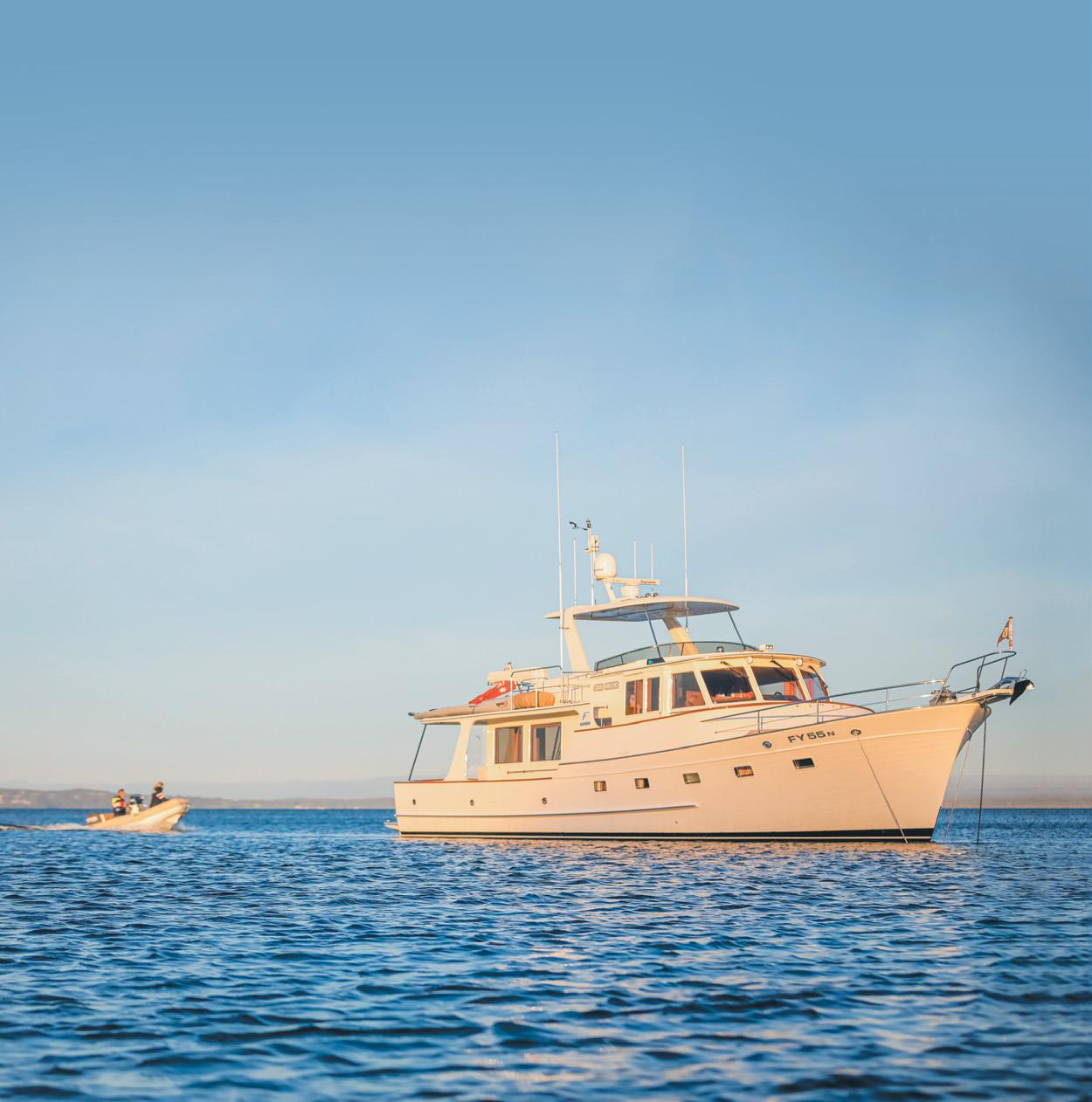
Learn why at FlemingYachts.com/Research
www.flemingyachts.com

For sailors, cruisers, and yachties, the importance of offshore medical training cannot be overstated. Having the knowledge to administer first aid and basic medical care on board your boat can mean the difference between life and death in an emergency situation. Whether you’re heading out on an overnight voyage or a long-distance offshore trip, it is essential to make sure you have the knowledge and skills necessary to handle any medical situations that may arise. In this article, we'll discuss why it's essential for all boaties to have a minimal level of understanding when it comes to medical care at sea.
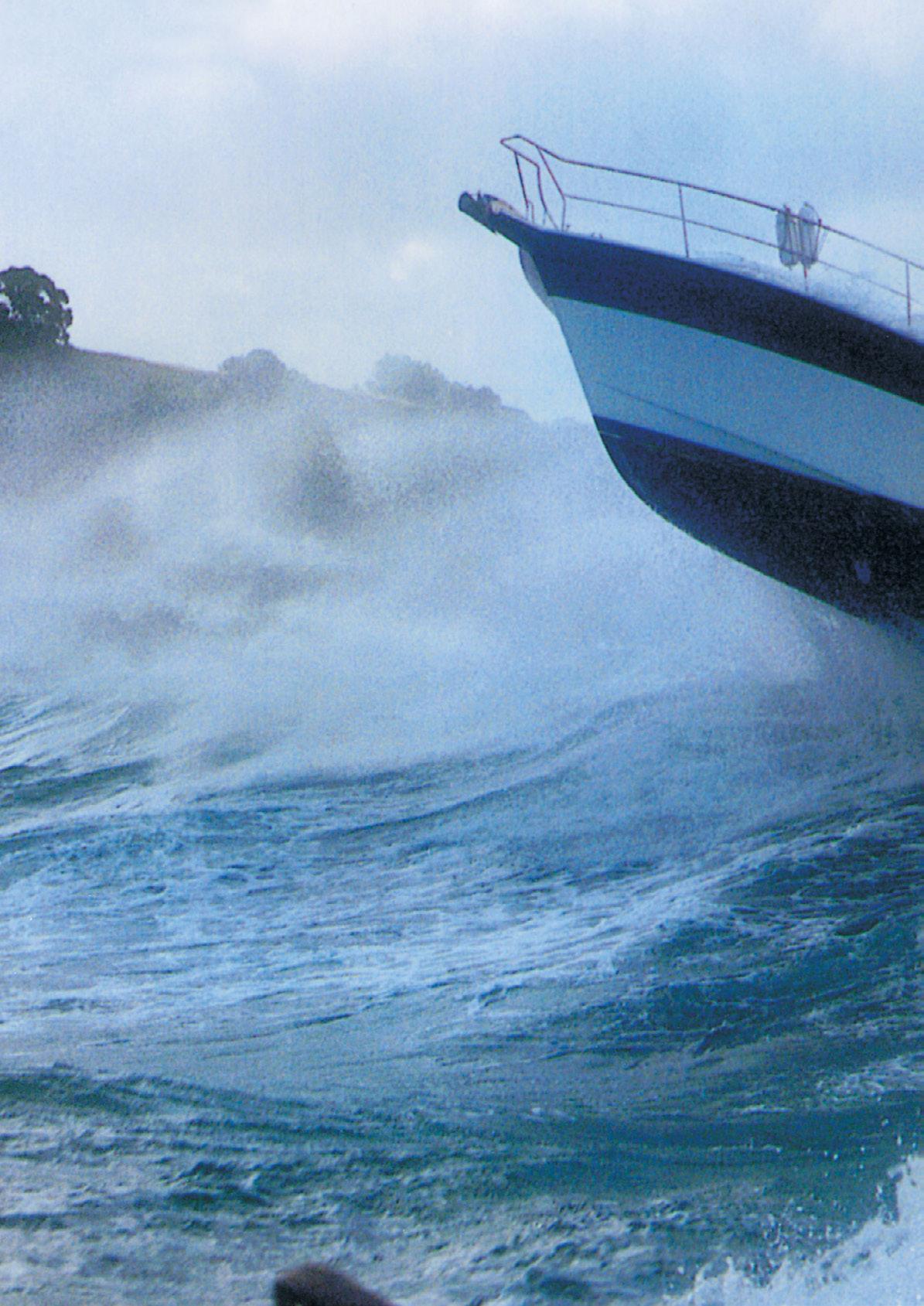
Offshore medical training is important because it provides boaters with the skills and knowledge to respond appropriately in a medical emergency while out on the water. Being able to respond quickly in an emergency situation is paramount. A basic knowledge of first aid along with additional information such as how to administer CPR can help save lives when there are no other options available. Additionally, having this type of training can also prevent minor illnesses or injuries from becoming more serious if not treated promptly.

This type of medical training covers a wide range of topics related to first aid or advanced life support treatments for those onboard or on nearby boats. The goal is to help boaties gain the knowledge and skills needed to keep themselves safe from potential harm due to illness or injury while on the water.
In order to receive certification in coastal and offshore medical training, you need to attend a classroom course. The coastal medic course is a 2 day course and is the prerequisite to offshore medic. These courses provide comprehensive instruction in a variety of topics including CPR, first aid, patient assessment, shock management, wound care, bone fractures, dislocation care and much more. After completing these courses successfully, students will receive official certification which is valid for two years after completion date so it’s important to stay up-to-date with your certifications if you plan on spending lots of time at sea!
1 day classroom course
This course is intended to promote safety amongst recreational boaties. The course focuses on safety equipment which should be carried on any vessel. The purpose is to understand the potential risks aboard a small vessel, the best safety equipment to carry, how it functions, and how to properly use it. This course includes a practical, in-water component.
2 day classroom course
An intermediate course for coastal boating within 24 hours of assistance.
This course covers modules
• airway, breathing and circulation
• injury identification
• stabilisation/treatment
• evacuation
• documentation
1 2
1 day classroom course
3
An advanced course for offshore skippers and crew to detail the management of medical/trauma emergencies on-board in an offshore marine environment. You will need to have completed the coastal medic to attend this course. It covers 2 modules; trauma management and medical management.

The trauma management covers
• Advanced airway management
• Fluid resuscitation
• Common on-board injuries
• Radio support options
• Offshore medical kit content review

2 day classroom course
The medical management covers:
• Medical management
• Medical assessment
• Symptomatic treatment
• Administration of medicines
• Advanced wound closure
4
A comprehensive course to cater for coastal and offshore crews. Required for Category 1 certificates. The course offers detailed knowledge and practical competence in sea survival techniques and equipment. This course includes a practical, in-water component.
Along with medical training it is essential that you have an understanding of emergency protocols. Knowing how to make a distress call or contact the Coastguard can be the difference between life and death in a critical situation. Additionally, being able to properly use safety equipment such as flares or life rafts may be necessary in order to survive an accident at sea. It's important for boat owners or operators to know what types of safety gear are required by law (such as personal locator beacons) as well as any other items that might be useful in an emergency situation (such as flashlights or radios).
THERE ARE FOUR COURSES THAT COASTGUARD BOATING EDUCATION OFFER WHICH ARE BENEFICIAL FOR ANY BOATING FAMILY BUT ESPECIALLY IF YOU ARE PLANNING TO TAKE THE VESSEL OFFSHORE
Book online or email us:
BOATINGEDUCATION.ORG.NZ BOOKINGS@BOATINGEDUCATION.ORG.NZ

If you want to discuss things in more detail please call the team who will be happy to help on 0800 40 80 90.

To detail the management of trauma up to 24 hours with little outside assistance and medical equipment. Meets requirements for workplace first aid certificate. Recognised by the RYA and YNZ.


Two
To detail the management of medical /trauma emergencies on-board in an offshore marine environment. Meets requirements of YNZ & World Sailing Offshore Special Regulations Appendix H.


We are now firmly into the start of autumn which makes for careful selecting time out on the water due to seasonal storms. In this issue I highlight the absolute value of having a Coastguard membership, as I needed their services for the 2nd time in 6 months. Spend the next few weeks completing any outstanding repairs before putting your boats into long term storage for the next few months.

If you have an inboard motor in your boat, you will be painfully aware that it can produce excessive engine noise when underway, updates in recent sound deadening technology means that there are a variety of products available on the market that can significantly reduce the noise down. Here is Brendan installing a product called Dynamat Xtream on his engine cover. This product has high performing sound deadening properties and is very effective at reducing the engine drone.
Pro Tip: Make sure that if you are installing new sound deadening, completely remove all the old foam and glue, this will make the installing of the new product much easier and will look nicer.


Yet another gentle reminder to encourage you to purchase an annual Coastguard membership and keep it updated every year. I had to get towed back to the boat ramp after I managed to get water in my fuel tanks (don’t ask), which caused my engine to shut down and left me with no way of getting home. The boys from Browns Bay Coastguard towed me back to the Gulf Harbour boat ramp and helped me load it back onto the trailer, all included in my membership - thanks guys!

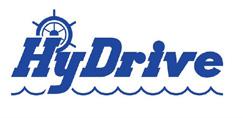
As part of your maintenance schedule, always check for fishing line wrapped around the propeller shaft, fishing line can work its way under the seals on the prop shaft. These seals keep water from entering the gear case and keep the oil leaking out.




Pro Tip: Check the gearbox oil by draining and checking that it’s not a milky white colour, if it is, then get your marine mechanic to replace all the gearbox seals.

There are a number of products you can purchase to remove stains from fibreglass, however you can make a cheap paste mixing baking soda and a little water. Use a sponge or soft cloth and rub the mix into the discolouration, this will work on almost all imperfections and blemishes.
Pro Tip: Use lemon juice as a final wipe-down to remove all the old paste.











